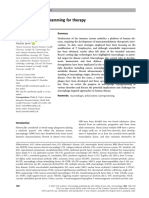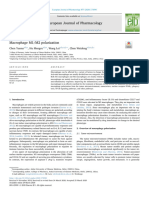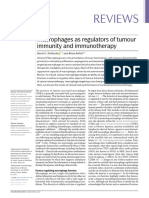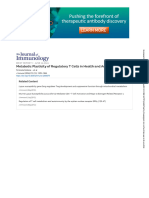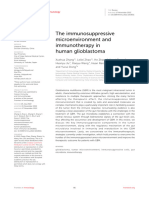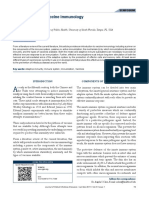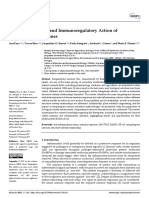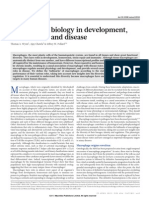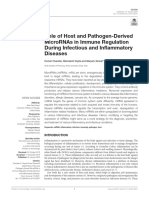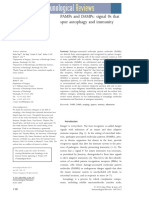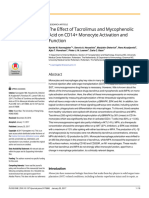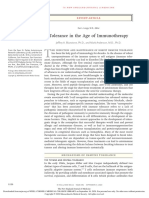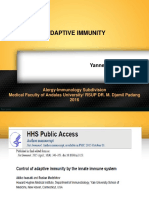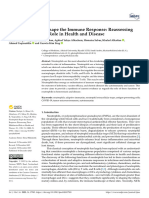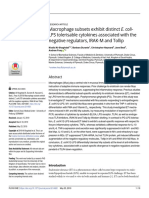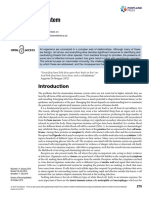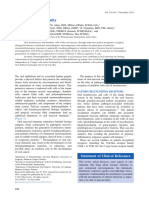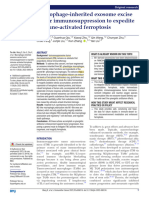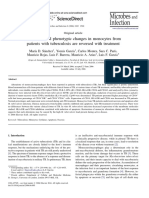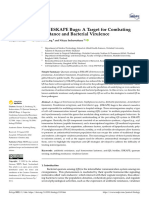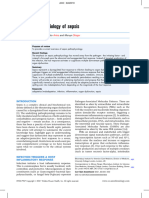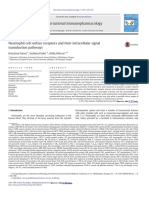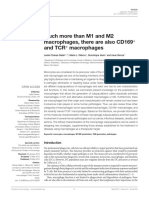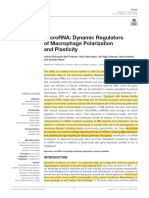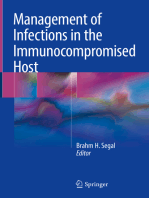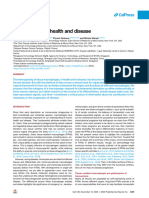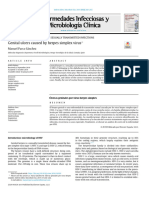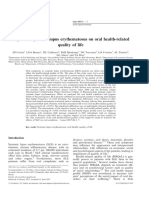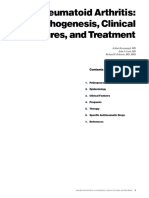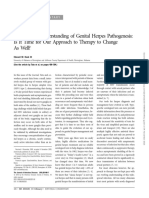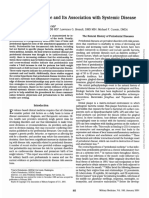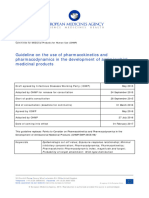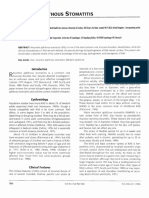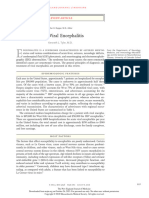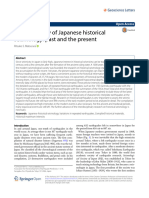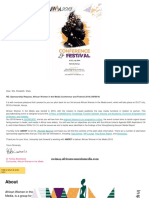Macrophages in Immunoregulation and Therapeutics: Signal Transduction and Targeted Therapy
Macrophages in Immunoregulation and Therapeutics: Signal Transduction and Targeted Therapy
Uploaded by
gugicevdzoceCopyright:
Available Formats
Macrophages in Immunoregulation and Therapeutics: Signal Transduction and Targeted Therapy
Macrophages in Immunoregulation and Therapeutics: Signal Transduction and Targeted Therapy
Uploaded by
gugicevdzoceOriginal Title
Copyright
Available Formats
Share this document
Did you find this document useful?
Is this content inappropriate?
Copyright:
Available Formats
Macrophages in Immunoregulation and Therapeutics: Signal Transduction and Targeted Therapy
Macrophages in Immunoregulation and Therapeutics: Signal Transduction and Targeted Therapy
Uploaded by
gugicevdzoceCopyright:
Available Formats
Signal Transduction and Targeted Therapy www.nature.
com/sigtrans
REVIEW ARTICLE OPEN
Macrophages in immunoregulation and therapeutics
Shanze Chen1, Abdullah F.U.H. Saeed2, Quan Liu3, Qiong Jiang1, Haizhao Xu1,4, Gary Guishan Xiao5 ✉, Lang Rao 6✉
and
Yanhong Duo7 ✉
Macrophages exist in various tissues, several body cavities, and around mucosal surfaces and are a vital part of the innate immune
system for host defense against many pathogens and cancers. Macrophages possess binary M1/M2 macrophage polarization
settings, which perform a central role in an array of immune tasks via intrinsic signal cascades and, therefore, must be precisely
regulated. Many crucial questions about macrophage signaling and immune modulation are yet to be uncovered. In addition, the
clinical importance of tumor-associated macrophages is becoming more widely recognized as significant progress has been made
in understanding their biology. Moreover, they are an integral part of the tumor microenvironment, playing a part in the regulation
of a wide variety of processes including angiogenesis, extracellular matrix transformation, cancer cell proliferation, metastasis,
immunosuppression, and resistance to chemotherapeutic and checkpoint blockade immunotherapies. Herein, we discuss immune
regulation in macrophage polarization and signaling, mechanical stresses and modulation, metabolic signaling pathways,
mitochondrial and transcriptional, and epigenetic regulation. Furthermore, we have broadly extended the understanding of
macrophages in extracellular traps and the essential roles of autophagy and aging in regulating macrophage functions. Moreover,
we discussed recent advances in macrophages-mediated immune regulation of autoimmune diseases and tumorigenesis. Lastly,
we discussed targeted macrophage therapy to portray prospective targets for therapeutic strategies in health and diseases.
1234567890();,:
Signal Transduction and Targeted Therapy (2023)8:207 ; https://doi.org/10.1038/s41392-023-01452-1
INTRODUCTION Macrophages are innate immune cells first identified by Elia
The primary formation of host resistance, contrary to infectious Metchnikoff in starfish hatchlings in 1882 when tangerine tree
pathogens in disease, is the innate immune framework mainly thistles were used, then in Daphnia magna or essential water flea
made of innate immune cellular entities and cells originating from infested with fungal spores as the cells responsible for the cycle of
myeloid, comprising macrophages, monocytes, granulocytes, and phagocytosis of foreign materials. For this accomplishment, the
dendritic cells (DCs).1,2 When disease ensues, pathogen-associated Nobel Prize (Physiology and Medicine) was presented to Elia
molecular patterns (PAMPs) and damage-associated molecular Metchnikoff in 1908. In this way, macrophages are the primary
patterns (DAMPs) are recognized via the cell surface or intracellular innate immune cells identified 130 years ago.4
pattern recognition receptors (PPRs) from innate immune cells, for Macrophages are crucial in innate immunity by regulating
example, Toll-like receptors (TLRs), advanced glycation end several homeostatic and evolutionary host defense immune
products (RAGE) and Nod-like receptors (NLRs).2 Successively, the responses. Besides, macrophages partake in many other biological
interaction of PAMPs or DAMPs through particular receptors events, including modulating reactive oxygen species (ROS)
triggers signaling cascades following association at reactive endogenous intensities, iron homeostasis, tissue injury repair,
oxygenic and nitrogen-related species, chemokines, proinflamma- and numerous other metabolic functions.5,6 In addition, macro-
tory cytokines, and antimicrobial-associated peptides, including phages have three essential functions, i.e., immunomodulation,
augmented phagocytosis and the efficient elimination of microbial phagocytosis, and antigen presentation. They are vital for
infection.2,3 In addition, instigating the innate immune system leads performing normal immune reactions under various pathophy-
to the follow-up with the trigger of more specific adaptive siological conditions.7
immunity. However, given the advantages of the innate immune As the relationship between TAMs and malignant tumors
system, this tends to remain a double-edged sword employing expands into more apparent, TAMs are suggested as possible
inflammation that will damage the host.2 Hence, it is significant to biomarkers for diagnosing and prognosis tumors and therapeutic
comprehend the immune regulatory strategies that govern the targets in various cancers. Inhibiting monocyte recruitment,
inflammatory progression’s commencement, extent, and goals. targeting TAM activation, converting TAMs to anticancer
1
Department of Respiratory Diseases and Critic Care Unit, Shenzhen Institute of Respiratory Disease, Shenzhen Key Laboratory of Respiratory Disease, Shenzhen People’s Hospital
(The Second Clinical Medical College, Jinan University; The First Affiliated Hospital, Southern University of Science and Technology), Shenzhen 518020, China; 2Department of
Cancer Biology, Beckman Research Institute of City of Hope National Medical Center, Los Angeles, CA 91010, USA; 3Department of Laboratory Medicine, Huazhong University of
Science and Technology Union Shenzhen Hospital (Nanshan Hospital), Shenzhen University, Shenzhen 518052, China; 4Department of Respiratory, The First Affiliated Hospital,
School of Medicine, Southern University of Science and Technology, Shenzhen 518055, China; 5State Key Laboratory of Fine Chemicals, Department of Pharmaceutical Sciences,
School of Chemical Engineering, Dalian University of Technology, Dalian, China; 6Institute of Biomedical Health Technology and Engineering, Shenzhen Bay Laboratory, Shenzhen
518132, China and 7Department of Microbiology, Tumor and Cell Biology (MTC), Karolinska Institutet, Stockholm, Sweden
Correspondence: Gary Guishan Xiao (gxiao@dlut.edu.cn) or Lang Rao (lrao@szbl.ac.cn) or Yanhong Duo (duoduo7753@126.com)
These authors contributed equally: Shanze Chen, Abdullah F.U.H. Saeed, Quan Liu
Received: 5 September 2022 Revised: 6 March 2023 Accepted: 26 April 2023
© The Author(s) 2023
Macrophages in immunoregulation and therapeutics
Chen et al.
2
macrophages, and targeting TAMs in conjunction with conven- profiles, including major histocompatibility complex (MHC) II, IL-
tional chemotherapy are all examples of the therapeutic strategy 12, nitric oxide synthase 2 (NOS2), and suppressor of cytokine
aimed at TAMs.8 signaling (SOCS)1. IFN-γ is part of the M1/M2 model paired with
Macrophages accomplish widespread functions counting tissue LPS. Nevertheless, the combination’s gene expression profiles vary
repair and regulation of homeostasis and immunity. Nevertheless, from LPS and IFN-γ alone.27
the signal transduction details are still far from complete. The PRRs, such as TLRs, recognize bacterial moieties. Specifi-
Moreover, even though these cells are precisely regulated, cally, LPS and other microbial ligands activate TLR4, activating the
immune pathways modified in disease and health are poorly TIR-domain-containing adapter-inducing interferon-β (TRIF) and
understood. Hence, we have comprehensively reviewed the the myeloid differentiation response 88 (MyD88). The TRIF-
essential functions of macrophages in various immune settings regulated mechanism triggers kinase cascades and eventually
that will support an in-depth understanding of recent advances in activates the interferon-responsive factor 3 (IRF3). IRF3 tracks the
macrophage signaling and immune regulation. secretion of IFNs, including IFN-α and IFN-β. In TLR4, MyD88,
which is yet another adapter, activates the nuclear factor kappa-B
(NF-kB) pathway (p65 and p50), a crucial transcription factor in the
ACTIVATION AND POLARIZATION OF MACROPHAGES polarization of M1 macrophages. MyD88 also activates the protein
An essential function of macrophages is to sanitize the cellular activator 1 (AP-1) via MAPK.28,29 These pathways promote the
fragments produced by tissue remodeling and apoptosis, leading expression of various inflammatory genes like proinflammatory
to cell death.9 For these events, macrophages can sense danger cytokines (including tumor necrosis factors (TNF), IL-1β, and IL-12),
signals over pattern recognition receptors (PRRs), consisting of chemokines CXCL10, CXCL11, co-stimulating proteins, and pro-
TLRs and C-type lectin receptors (CLRs). Afterward, the elicited teins that process antigens.30
danger-associated signals comprise PAMPs on the attacking
entities and DAMPs, which happen as the infection advancements, Stimulation of M2. Cytokine IL-4 and IL-13 bind to the IL-4Rα
and cells are destroyed.2,10 Bone marrow-derived monocytes are receptor and M2 polarization. Generally, JAK1 and JAK3 signals
the origins of the macrophages, the primary defense in the front activate STAT6, which translocates into the nucleus and modulates
line to entering infectious pathogens, acting as a surveillance interferon genes-mediated antiviral innate immune responses.31
framework, and an essential constituent of innate immunity.11,12 Other transcription factors involved IRF4 and peroxisome
proliferator-activated receptor γ (PPARγ). A variety of proteins,
Macrophage polarization such as arginase 1 (Arg 1), Ym1 (or Chitinase 3-like 3, Chi3l3),
The macrophages’ destiny relies on various environmental resistin-like-α (Retnla or Fizz1), CCL17 and CD206 (or macrophage
conditions that fuel polarization to any of the classically mannose receptor 1, Mrc1) are controlled by STAT6, IRF4, and
triggered pro-inflammatory M1 response or triggered M2 PPARγ. The PPARγ transcription factor can also be triggered by
immune response. Macrophage M1 or M2 polarization is a fatty acid receptors linking free fatty acids.19
precisely regulated process comprising several key signaling All the leukocytes may contain IL-10, which binds the
pathways, transcriptional epigenetic and post-transcriptional heterodimers IL-10 (IL10-R1 and IL10-R2). The IL-10 binds to IL-
regulatory networks (Fig. 1).13,14 10R leading to receptor autophosphorylation, which activates the
Immune-related responses are elicited by several pathogen- STAT3 transcription factor. The binding of STAT3 to its promotor
associated molecular markers, including damage-associated can modulate the expression of the suppressor of cytokine
molecular markers, lipopolysaccharide (LPS), as well as inter- signaling 3 (SOCS3), which blocks the proinflammatory cytokine
feron-γ (IFN-γ), a type 1 helper T (Th1) cytokine-provoking pro- signaling pathways.32
inflammatory responses.2,15 In addition, Th2 cytokines, such as As a product of digestion by cellular enzymes in macrophages,
interleukin (IL)-4 and IL-13, trigger alternative M2 immune glucocorticoids are formed from glucocorticoid hormones. They
reactions. Likewise, diverse factors affect macrophage polarization will pass across the membrane and are lipophilic. The glucocorti-
and reprogramming (Table 1).2,16 coid receptor (GR) binds with intracellular glucocorticoids,
In comparison, different terminology and definitions contribute resulting in the complex’s nuclear translocalization.33 The DNA is
to the stimulation and polarization of the macrophage. For directly linked to the complex, and anti-inflammatory genes like
example, recent research reported M1 and M2 phenotypes in IL-10 and IL1-R2 are prompted to transcribe. Conversely, the GR
Balb/c and C57BL/6 mice.17,18 In another study, Abdelaziz et al. complex can communicate with other transcription factors, such
depicted that IL-4 and IL-13 trigger alternative macrophage as NF-kB or AP-1.34,35
activation.19 Furthermore, other studies reported a regulatory
macrophage (Mreg) activation.20 Another analysis was defined as Attributes of macrophage polarization. The concept of M1/M2
classical IFN-α macrophage stimulation.21 Again, oxidized lipids in polarization was reported in 2000 based on the capacity of C57BL/
antioxidant macrophages (Mox) are revealed to induce macro- 6J macrophages to generate NO (M1 polarized) compared to Balb/
phage phenotype.22 In addition, Yi Cai et al. identified a subset of c mice (M2 polarized).36,37 Altered LPS infusion metabolic activity
macrophages that are distinguished with high expression of of arginine evokes various macrophage-related phenotypes in
CXCL4 (M4)23 by using single-cell transcriptome analysis. Lv et al. C57BL/6J mice and albino mice in Balb/c. C57BL/6J peritoneal
described alternate triggered macrophages into M2a, b, c.24 macrophages can be induced to express inducible NOS (iNOS),
Moreover, a new study reveals for the first time that insulin-like generating NO and Th1 CD4+ T cells mediated immune response.
growth factor 2 (IGF2) mRNA-binding protein 2 (IGF2BP2) plays an In comparison, Balb/c albino mice added ornithine-like arginase
essential role in macrophage activation.25 and a Th2-like response system. The macrophages called M1 and
M2 looked the same as Th1 and Th2.37–40 Such findings suggested
Stimulation of M1. Microbial products or pro-inflammatory that macrophages urging various mouse species had an
cytokines induce M1 polarized macrophage (M1). The critical alternative preference attributable to LPS to produce NO and
Th1 cells-derived inflammatory mediator that polarizes macro- arginase.
phages to the M1 phenotype is IFN-γ. The binding of IFN-γ to its In addition, NO formation is a fundamental feature of M1
receptor interferon-gamma receptor (IFNGR) firstly activates the macrophages following the upregulation of the inducible NOS2.41
Janus kinase (Jak) adapters, which subsequently leads to the Large quantities of proinflammatory cytokines and ROS, compris-
activation of STAT1 (signal transducer and transcription activator ing tumor necrosis factor-alpha (TNF-α), IL-1β, IL-12, and IL-23, are
1).26 In addition, IFN-α also triggers specific gene expression auxiliary generated by these classically activated M1
Signal Transduction and Targeted Therapy (2023)8:207
Macrophages in immunoregulation and therapeutics
Chen et al.
3
Fig. 1 Pathways for signaling macrophage polarization. The figure demonstrates numerous strategies essential for macrophage polarization
and depicts feedback control on signaling pathways of M1 and M2. Key signal channels include IRFs, STATs, NF-κB, and SOCS. The downstream
protein STAT6 is krüppel-like factor 4 (KLF-4). Also, macrophage polarization can be induced by GO (graphene oxide) towards the M1
phenotype. HA-PEI/pDNA-IL-10 or HA-PEI/pDNA-IL-4 NPs) and tuftsin-modified alginate NPs containing murine cytokine IL-10 plasmid DNA
modulate programming from M1 toward M2. Similarly, enhanced expression of API, PPARγ, and CREB is mediated by cytokine receptor, fatty
acid receptor, and TLR4, respectively. STAT1-STAT6 introduces the feedback control of M1 and M2, IRF5-IRF4, NF-κB-PPARγ, AP1-CREB, and AP1-
PPARγ, which play a crucial role in inflammatory disease instigation, development, and termination. TLR toll-like receptor, CREB cyclic AMP-
responsive element binding, NF-κB nuclear factor kappa light chain enhancer of activated B cells, STAT signal transducers and activators of
transcription, PPARγ peroxisome proliferator-activated receptor γ, IRF interferon regulatory transcription factor, API apigenin
macrophages, adding the killings of pathogens and recruitment of macrophage roles, they can further be subdivided into Mregs
additional proinflammatory cell sorts.42,43 Graphene oxide (GO) based on the alternatively activated subset, myeloid-derived
can aid in forming an antioxidant and reducing inflammation and suppressor cells (MDSCs), profibrotic macrophages (M2a), and
inflammatory macrophage polarization through lessening ROS in TAMs.48 Respectively, the M2 subtypes are generally immunosup-
the cell.44,45 GO is a critical transporter for IL-4 plasmid DNA (IL-4 pressive but have discrete functions of activators and effectors.
pDNA) that proliferates M2 macrophages.44,45 Conversely, M2 Mregs are mutually stimulated, produce IL-10, and induce neither
macrophages participate in tissue remodeling, wound restoration, arginase nor NOS2, nonetheless playing their role in repressing M1
regulation of tumor environment, hypersensitive reactions, and macrophages.49 The tumor factors induce the isolation and
responses to helminths.46,47 These, on the other hand, actuated polarization of TAMs present in tumor microenvironments (TME)
macrophages with improved arginase action and IL-10 produc- (e.g., hypoxia) and typical M2 stimuli. This term triggers tumor
tion. Because of the widespread assorted variety of M2 growth to be instigated and encouraged similarly through
Signal Transduction and Targeted Therapy (2023)8:207
Macrophages in immunoregulation and therapeutics
Chen et al.
4
Table 1. Factors influencing macrophage polarity and reprogramming
Factors M1 macrophage M2 macrophage Ref.
17
Stimulation LPS, IFN-γ, GM-CSF, TNFα LPS, ICs, GCs, LIF, adenosine, TGF-β, IFN-γ, IL-4, IL-10,
IL-13, IL-33, Th cytokine, M-CSF, helminth
Cytokines High TNFα, IL-1β, IL-6, IL-12, IL-18, IL-23 Low IL-12, IL-23, high IL-1RA, IL-10, IL-4/IL-13
Markers CD86, CD80, CD68, MHC II, IL-1R, TLR2, TLR4, iNOS, SOCS3 CD86, CD163, MHC II, SR, MMR/CD206, CD200R, TLR1,
TLR8, VEGF, MMP9, TGM2, DecoyR, IL-1R, IIMR, Fizz-1,
Ym1
Chemokines CXCL1, CXCL3, CXCL5, CXCL8, CXCL9, CXCL10, CXCL11, CCL1, CCL2, CCL5, CxCL10, CCL13, CCL14, CCL17,
CXCL13, CXCL16 CX3CL1, CXCR3; CCL2, CCL3, CCL4, CCL5, CCL18,CCL22, CCL23, CCL24, CCL26, CXCL16, CCR2,
CCL8, CCL11, CCL15, CCL19, CCL20; NOS2, CD64, IDO, CCR3, CCR4
SOCS1
Reprogramming Reprogramming from M2 to M1; Superparamagnetic iron- Reprogramming from M1 to M2; hyaluronic acid-poly
oxide nanoparticle (SPIONs), Glycocalyx-mimicking NPs (ethyleneimine), plasmid DNA NPs (HA-PEI/pDNA),
(glycol-NPs), Ag, Au, Co, ZnO, TiO2, SiO2 miR-223-expressing plasmid DNA-encapsulated, HA-
PEI NPs (HA-PEI/miR-223 NPs), alginate NPs, Au, Ti
Other macrophage- STAT1, STAT2, IRF5, p65, iron uptake, and metabolism; high STAT3, STAT6, IRF4, p50, iron release, folate uptake and
induced products ROS, ROIs, NO, and MHC I, low IL-10 metabolism, arginase 1 to polyamine
immune suppression and angiogenesis.50 MDSCs are believed to by innate and adaptive immune cells, consisting of CD4+ Th1-type
be a precursor of TAMs. Nevertheless, as seen in mice, they also T cells, CD8+ T cells, and natural killer (NK) cells (46). Macrophages
increased the supply of GR1, a proinflammatory immune marker, are skilled in manufacturing only IFN-γ and LPS or LPS in humans
decreased the activation of F4/80, and had a corresponding role in or IL-12 and IL-18 in mice.62
arginase and NOS2. MDSCs play a crucial role in inhibiting innate
and T-cell responses in cancer. M2a macrophages produce Functions of activated macrophages
fibronectin and other IL-4 and IL-13, enhancing the repair of Phagocytosis. Phagocytosis is an essential function achieved by
injuries and the development of extracellular matrix (ECM).50 After macrophages to satisfy their crucial purpose in removing disease
activation, macrophages maintain plasticity and shift from one and remodeling tissues. The impact of substrate rigidity on
functional phenotype to a different one centered on conditions. macrophages’ phagocytic activity has been evaluated in several
Nevertheless, extreme response of any polarization state can investigations. RAW 264.7 macrophages and alveolar macro-
influence tumor formation, tissue necrosis, inflammation, and phages in humans present the exaggerated phagocytic function
fibrosis.51 Anti-programmed death-ligand 1 (PD-L1) therapy in of beads using a stiffer substrate.63 Conversely, in Adlerz and
colorectal cancer (CRC) may be achieved by optimizing the release coworker’s study, substrate stiffness didn’t disturb the phagocytic
of sEV- microRNAs (miRNAs) from CRC and addressing PD-L1 in role of monocyte-derived macrophage’s fluorescent beads.64 In
TAMs, according to recent research.52 In a breast cancer model, distinction, Scheraga and associates perceived stiffness with the
PYK2 controls TAMs. There is an indication that PYK2 depletion impact on phagocytic activity in LPS-stimulated murine BMDMs
alone in macrophages significantly lowers the amount of TAMs and alveolar macrophages.65 The cell’s firmness is also obtained
and slows tumor development and angiogenesis.53 Hence, it is by inducing extracellular strain onto the cells. The work took into
substantial to comprehend the immune approaches of macro- account the effect of these strains on macrophages. They found
phage regulation for therapy and disease management. that PMA-differentiated THP-1 macrophages display increased
The plasticity of the macrophages assists them to adaptin the combined compact phagocytic activity (+20 and +100 mmHg).
microenvironment by changing the activation state ensuing in Moreover, in alternative work, it was displayed that this impact
comprehensive classification and activation of M1 or M2 macro- of rapidly cumulative phagocytosis by growing extracellular
phages (Fig. 2).54 Consequently, through TLR and CLR recognition, compression may also be discovered in primary monocytes in
the immune cells respond to invading microbes and regenerate humans and monocyte-derived phagocytes.66 It is known that p38
inflammatory cytokines, including IFN-γ, resulting in macrophage mitogen-activated protein kinase (MAPK) is a further contributor
polarization to an M1 phenotype.55 M2-polarized macrophages concerned with the impact of extracellular compression on
can re-polarization in response to trigger M1 stimulation like IFN- macrophage phagocytic activity.66
γ.56 suggesting the imperative significance of the native cytokine To finish with the topography of the constituent component to
milieu in leading macrophage polarization. It has been shown that be consumed, phagocytosis and macrophage activation are
IL-4 and IFN-γ can cross-regulate themselves as settings favorable disturbed. IL-1β production after NLRP3 activation was more
to IFN-γ production for inhibiting IL-4 production.57 It is possible significant after the absorption of textured particles than smooth
to induce the activation of M1 macrophage in a STAT1-dependent surface particles.67 Another work delineated in the section
route by manufacturing IFN-γ through Th1-type T cell types and ‘Biochemical cues’ discovered that, in contrast, surface features
NK cells. The IL-4 and/or IL-13-induced stimulation of the STAT6 intrinsically might not modulate the foreign body response/
pathway triggers M2 macrophage activation.58,59 arginase-1 (Arg- reaction (FBR). The biased surface assimilation of proteins by
1), out of frequent markers for M2 macrophage, reflects a context- different surfaces may account for variations in FBR.68 The lungs
dependent marker as it can be stimulated by STAT6 and STAT3, are often the central tissue location where stretches are often
related to executing partial tissue reparative function of M2 intimate with the cells. In response to lung infection, alveolar
macrophage.60,61 macrophages and lung epithelial cells release proinflammatory
Important markers comprising cytokines and chemokines cytokines. IL-6, TNFs and IL-1 enhance the transcription of cell
produced from activated macrophages can prompt the recruit- adhesion molecules (CAMs) and vascular endothelial growth
ment of leukocytes and infection resolution to identify macro- factor (VEGF), improving lung endothelial penetration and
phage activation phenotypes. Numerous M1 markers are decreasing the protective barrier, enabling viral dispersion and
subjected to the upregulation and expression of IFN-γ, developed the influx of neutrophils and inflammatory monocytes.69
Signal Transduction and Targeted Therapy (2023)8:207
Macrophages in immunoregulation and therapeutics
Chen et al.
5
Fig. 2 The M1/M2 macrophage origin, activation, and functional basis. Macrophages are typically produced from embryonic progenitors and
involve inputs from yolk sac macrophages, blood monocytes independent, and adult monocytes originating from bone marrow. Macrophage
immune modulation, functional plasticity, and phenotype changes are centered on cytokines, transcription, and epigenetic deviations
Macrophages generate NO, which may occur in the vicinity to degrading the matrix precisely, possibly instigating cellular
guard alveolar cells against elasticity-induced cell damage or feedback to elasticity to change the native ECM.72 In peritoneum
apoptosis in vitro. The surfactants within the lungs regulate the macrophages, 20% static strain enhanced chemokine and
cellular surface tension cells within the alveoli, together with cytokine production; stimulation with LPS further increased
macrophages.70 Wu and associates sought the strategy behind cyclooxygenase-2 (COX-2) and synergistic generation of IL-6.
stretch-induced respiratory infection comprising lung inflamma- Applying cyclic biaxial stress and titanium elements to bone
tion and directed in mice alveolar macrophages that ROS marrow-derived macrophages (BMMs) or RAW264.7 cells did not
generation was augmented following the ventilation activity.71 significantly influence pro-inflammatory genetic factors (but it was
Stretch was additionally considered in phagocyte categories seen in osteoblasts).73 It has been demonstrated that concentra-
that don’t seem to be directly associated with tissues of the lungs. tions of oxygen will affect the feedback of macrophages to
The effect of strain on primary human monocytes following elasticity: PMA-segregated THP-1 macrophages that were applied
phorbol myristate acetate (PMA) treatment and U937 to 100% strain at 1 Hz for 24 h revealed elasticity triggered
macrophage-like cells resulted in an augmented yield of enzymes expansion and coordination; however, this result was repressed
Signal Transduction and Targeted Therapy (2023)8:207
Macrophages in immunoregulation and therapeutics
Chen et al.
6
beneath hypoxic settings, at a site where expression of hypoxia- extensively. Autophagy targets Francisella once it is in the cytosol.
inducible factor-1α (HIF-1α) was improved.74 Autophagy’s function in this cytosolic pathogen’s replication has
not been completely understood. It was observed that Francisella
Regulation and evasion of macrophage autophagy. Autophagy is tularensis delivers a surface polysaccharide O-antigen and camou-
an effective cellular strategy of enclosing materials or pathogens flages itself legitimately, which forestalls cytoplasmic pathogenic
in the cytoplasm into a double-membrane cellular organelle called detection and outcomes in xenophagy. Then again, cytosolic
the autophagosome, which disintegrates substrates with the help O-antigen mutants were destroyed inside murine macrophages by
of lysosomes. The process of autophagy is coordinated into Atg5-dependent autophagy.84 Likewise, Salmonella can trigger cell
different capacities and procedures of the immune system. It is a autophagy due to incursion, which defends cells against microbial
substantial obstruction component to ensure the body’s organiza- invasion. S. typhimurium initiates the mammalian target of
tion against external pathogenic invaders and threat signals, rapamycin (mTOR) and anticipates autophagy in macrophages, an
assuming an essential function in the enlistment and guideline of ace repressor of autophagy. Prominently, macrophages deficient in
inflammatory responses in innate immune cells.75 This remarkably FAK are progressively proficient in eliminating S. typhimurium
detailed process combines more than 30 autophagy-related genes disease in vivo, compared to wild-type partners.85
(Atgs) as operating units and immune signaling pathways. Atgs, A few pathogens can repress signaling pathways that promote
serine/threonine kinase ULK1, and Beclin-1, in contrast to Atg14 autophagy activation. For example, macrophages can exploit
and type III phosphatidylinositol 3-kinase Vps34 Atgs, advance the negative feedback regulatory circuits to target autophagy. For
structure of a cup-shaped separation membrane to inundate the instance, NLRC4-dependent caspase-1 cleavage is prompted by P.
load after autophagy has been initiated. Similarly, The cell-death- aeruginosa infection that outcomes in TRIF cleavage, a significant
inhibiting action seems to be achieved by ULK1 phosphorylation inducer of TLR4-incited autophagy.86
of S357 inside the intermediary motif of RIPK1. According to the In addition, host defense systems against pathogens, such as
study, ULK1 is a possible modulator of RIPK1-induced cell death.76 viruses, bacteria, and fungi, are controlled by miRNAs. MTB, the
Macrophages perceive pathogens by surface-induced receptors, pathogen that causes TB and its host to interact, plays an essential
in this way, overwhelming and processing them. Macrophages role in determining the direction of the disease. According to a
with M1 increment and discharge huge measures of inflammatory research observation, cell death, inflammatory processes, autop-
factors, for example, TNF-α, IL-1, iNOS, IL-6, and several hagy, and macrophage polarity are all regulated by the differential
chemokines, C-C chemokine ligand 2/4 (CCL2/4) chemokine and expression of miRNAs in the host during infection with MTB.
(C-X-C theme) ligand 8/11 (CXCL8/11) chemokine, that can initiate Virulent MTB may use host miRNAs to increase pathogenicity by
the immunity intervened by Th1 cells, aberrant inflammation, inhibiting host-mediated antimicrobial signaling pathways. To
endotoxic distress, and organ damage.77,78 keep pathogens at bay, host-induced miRNAs boost antibacterial
In macrophages, xenophagy has, for the most part, been mechanisms like autophagy. The miR-125a is initiated by MTB,
described during bacterial disease. Immunity-related GTPase which advances intracellular pathogen survival inside macro-
family M protein in human macrophages is interested in phages and restrains autophagy by targeting the UVRAG complex
xenophagy by advancing ROS yield and selecting autophagy with Beclin-1.87 A critical MTB virulence factor blocks autophago-
apparatus after PAMP introduction. Eventually, the autophago- some assembly in macrophages, Esat-6.87
some sends invading intracellular microorganisms to the lysosome
for disintegration.78 Autophagy modifies the surface expression of
the phagocytic receptors apparatus and manages phagocytosis IMMUNOMETABOLIC REGULATION OF MACROPHAGE
circuitously. Macrophages deficient in Atg protein Atg7 increase ACTIVATION
the upregulation of MARCO and MSR1 binary class A scrounger In the last 20 years, concentrations have given us a unique
receptors, encouraging the phagocytosis activity of M. bovis BCG understanding of the realistic and phenotypic better macrophage
and Mycobacterium tuberculosis (MTB).79 variety that parallels their critical role in the host defense,
Furthermore, autophagy can down-regulate inflammasome homeostasis, and pathogenesis process. In addition, metabolic
actuation through numerous components. The upregulation of investigations have late revealed the significant activity associated
IL-1β and pyroptosis is brought about by the loss of Atg7 in with metabolism and metabolites in forming phenotypic changes
alveolar macrophages.80 Features and levels of autophagy and macrophage capacity.88
subordinate extraordinarily to the macrophage microenvironment. Usually, regulating catabolic and anabolic metabolism pathways
The nearness of nutrient D in serum upgrades macrophage provide energy and biosynthetic antecedents necessary for
autophagy considerably by employing the induction of cathe- growth and structured cell-level help. A systematic analysis of
licidin antimicrobial peptide. Moreover, human macrophages’ immunometabolic pathways focuses on macrophages, which are
1,25(OH)2D3 enhances innate immune effectors and cathelicidin central in both pro- and anti-inflammatory immune reactions and
production with TLR2/1 stimulation.81 T cells can likewise trigger are the products of the immediate after-effect of metabolism
an autophagocytosis response in MTB-infested macrophages in reprogramming. Gradually, as we become familiar with the precise
humans. At long last, microbiota may impact autophagy activity as capacity of metabolic routes and intermediates involved in the
well. Currently, the upregulation of autophagy genes in macro- immune function, an innovative chance to aim for immunometa-
phages is brought about by the probiotic Bacillus amyloliquefa- bolic treatment has been established.89
ciens, which outcomes in the enhanced killing of Escherichia coli.82
A large cluster of strategies is built by intracellular bacterial Metabolic signaling and immune regulatory pathways
pathogens to offset antibacterial resistances in macrophages, and Macrophages are currently viewed as significant players in
autophagy response is no particular case. Cytosolic L. monocyto- immune regulation critical for health. Growing evidence reveals
genes keep from engulfing via autophagy machinery by using two that M1/M2 macrophage metabolic pathways are profoundly
virulence factors, ActA and InlK. To avoid being killed by connected to immune capacities (Fig. 3). Comprehending the
macrophages, microbial pathogens have developed complex connection between cell metabolic features and immune sensing
strategies. It has proven a vital model organism to decode the signaling pathways in macrophages may assemble appropriate
molecular processes of the interactions between pathogenic therapeutic methodologies for inflammatory disorders.90
bacteria and macrophages using L. monocytogenes, S. aureus, or
Yersinia spp.83 Following transmission, Francisella evades the Metabolic regulation in M1 macrophage. IFN-γ and LPS trigger
phagosome and enters the host cell cytoplasm, replicating macrophages, resulting in a TCA cycle revealed through
Signal Transduction and Targeted Therapy (2023)8:207
Macrophages in immunoregulation and therapeutics
Chen et al.
7
Fig. 3 M1/M2 macrophage metabolic signaling pathways and immune regulation. M1 macrophage is featured by aerobic glycolysis, which
leads to lactate development. The ROS and NO are produced accordingly. The PPP produces NADPH correlated with arginine synthesis and
the aspartate-arginosuccinate shunt pathway (AASS). In addition, the tricarboxylic acid cycle (TCA) produces essential citrate and succinate
vital to the metabolism of fatty acids and the stabilization of HIF-1α, leading to the transcription of pro-inflammatory and glycolytic genes and
epigenetic alterations. On the other hand, M2 macrophage primarily generates ATP in an oxidative TCA cycle, combined with OXPHOS. This
also metabolizes arginine. Similarly, the process depends on the energy sources of β-oxidation and glutamine metabolism. Also, precise
signaling and immune regulation are vital in metabolic pathways, including aerobic glycolysis leading to lactate, NO, fatty acid synthesis, and
glutamine pathways. Equally, acetyl-CoA, citrate, itaconate, and succinate are involved in immune regulation in the TCA cycle. Similarly,
hexokinase 2 (HK-II), glyceraldehyde 3-phosphate dehydrogenase (GAPDH), and arginase 1 play their roles in immune regulation. All enzymes
are shown in orange. GLUT1 glucose transporter 1, NOX2 NADPH oxidase 2, iNOS inducible nitric oxide synthase, HK hexokinase, PFK1
phosphofructo-1-kinase, PFK2 phosphofructokinase-2, LDHA lactate dehydrogenase A, MCT4 monocarboxylate transporter 4, ME1 malic
enzyme, ACLY ATP-citrate lyase, FA fatty acids, FAS: fatty acid synthase, CIC citrate carrier, PDH pyruvate dehydrogenase, MDH malate
dehydrogenase, FH fumarate hydratase, SDH succinate dehydrogenase, CII complex II, CAD cis-aconitate decarboxylase, ACO2 aconitase 2,
IDH isocitrate dehydrogenase, SLC3a2 solute carrier family 3 member 2, LAL lysosomal acid lipase, CPT-1 carnitine palmitoyltransferase I, CD36
cluster of differentiation 36
integrated transcriptional and metabolic pathways. The TCA cycle 1 (IDH1). The enzyme is responsible for the transfer of isocitrate (a
is a constraint at the rates of isocitrate dehydrogenase (IDH) and citrate isomer) to α-ketoglutarate. The upstream-citrate metabolite
succinate dehydrogenase (SDH), giving rise to the accumulation of itaconic acid inhibiting SDH is a crucial characteristic of macro-
concinate and citrate metabolites.91 Citrate build-up is the phages that IFN-γ/LPS polarize. Itaconate is an immunomodulator
consequence of the downregulation of isocitrate dehydrogenase with potent anti-inflammatory and antimicrobial effects on
Signal Transduction and Targeted Therapy (2023)8:207
Macrophages in immunoregulation and therapeutics
Chen et al.
8
pro-inflammatory macrophages.92 Changes in the concentration the production of functional in vivo macrophages beginning from
of metabolites may directly alter signaling pathway function. HIF- monocytes include the colony-stimulating factor (M-CSF) macro-
1α is stabilized by the accumulation of succinate in LPS-induced phage and other cytokines, including the granulocyte-
macrophages, which promotes pro-inflammatory cytokine IL-1β macrophage colony-stimulating factor (GM-CSF).107 Previously,
expression.93 Nonetheless, stabilization of HIF-1α leads to GM-CSF-formed GM-BMM exhibited significantly more inflamma-
increased glycolytic flux in M1 macrophages since HIF directly tion with higher TNF-α, IL-6, and IL-1β than M-CSF-formed
induces several glycolytic genes expression, such as monocarbox- M-BMM.108–110 Conversely, M-BMM produces more IL-10 paral-
ylate transporter 4 (MCT4) and glucose transporter 1 (GLUT1).94 leled with GM-BMM. A complete proteomic study uncovered that
Meanwhile, HIF-1 regulates innate immunity by controlling cellular metabolism administers macrophage function in cell
glycolysis. Lastly, HIF-1 contributes to a proliferative metabolism pathways for integrating cytokines.110
by regulating the glycolytic cascade, including hexokinase II Regarding extracellular fermentation, the metabolic varieties
(HKII).95 Another feature of macrophage M1 is an improved involving GM-BMM and M-BMM are envisaged through fast media
pentose phosphate pathway (PPP) that produces NADPH. In dye changes by developing usable GM-BMM, which is not present
addition, NADPH is required to catabolize arginine into the NO in the M-BMM population. Accordingly, proteomic-related studies
and L-citrulline as a cofactor for iNOS induced by LPS. NADPH, in comparing GM-BMM and M-BMM macrophages showed that
effect, produces inflammatory mediators NO and ROS. It also certain glycolytic compounds are strengthened than M-BMM in
produces antioxidant glutathione (GSH) that preserves redox GM-BMM. A notable analysis of gene ontology utilizing differen-
homeostasis and prevents ROS damage to cells.96 NO is also a tially expressed proteins (DEPs), and phosphoproteins found that
critical M1 macrophage metabolism regulator that stimulates iron- glucose’s metabolic/lipid-engineered/amino acid pathways are
sulfur-containing electron transport chain (ETC) clusters to now potentiated well ahead of LPS.111 Since studying GM-CSF’s
become nitrosylated and inhibits oxidative phosphorylation essential roles in that in vivo macrophage development, GM-CSF
(OXPHOS) and mitochondrial respiration.97 handling is shown to have enhanced LPS-instigated glycolysis in
Cytosolic citrate is required for NADPH production and redox M-BMM within 12 h. Furthermore, it was theoretically linked to an
balance preservation. The mitochondrial citrate carrier (CIC) moves inflammatory phenotype as 2-deoxyglucose (2-DG) glycolysis
citrate from the mitochondria to the cytosol, which the enzyme restriction removed GM-CSF-intervened enhancement of TNF-α,
ATP-citrate lyase (ACLY) transfers to the acetyl-CoA and OAA. In IL-1β, IL-6, and IL-12p70 mix after activation of LPS.112,113
macrophages, the combined expression of CIC and ACLY is Macrophages respond swiftly to environmental signals to
activated by the signaling of NF-κB and/or STAT) by inflammatory modify their phenotype within an extensive in vivo assortment.
factors such as LPS, TNF-α, and IFN-γ. NADPH derived from citrate Macrophage polarization, M1, and M2 macrophages speak to scale
can help maintain a redox balance that connects the metabolic limits and are currently characterized as individual M-CSF-derived
intermediate to the M1 macrophage pro-inflammatory function- macrophages prepared by LPS/IFN-γ or IL-13.114 The metabolism
ality.98 In addition, the activation of chromatin-modifying enzymes of the M1 macrophages is recognized by increased glycolysis,
(histone acetylation in HK-2, PFK1, and LDHA) may also be movement over the PPP, unsaturated fat mixture, and a curbed
regulated by acetyl-CoA, which links metabolism and epige- TCA cycle that prompts the accumulation of succinate and citrate.
netics.99 Acetyl-CoA is an additional component of the biosynth- The advancement of phosphofructokinase 2 (PFK2) transitions
esis of fatty acids. Fatty acids are precursors for prostaglandin starts with the liver isoform (L-PFK2) to the additional complex,
synthesis in TNF-α activated LPS-activated macrophages or omnipresent isoform, ubiquitous 6-phosphofructo-2-kinase/fruc-
IFN-γ.91 tose-2,6-bisphosphatase (U-PFK2) after IFN-γ/LPS activation.46
Another component of M1 macrophages is an improved PPP,
Metabolic regulation in M2 macrophage. The metabolic pheno- which is robust with a glycolytic transformation of greater
type of the M2 macrophage reveals significant variations with M1 significance. The rapid downregulation of carbohydrate kinase-
macrophages, which is consistent in terms of their distinct like protein (CARKL) was conducted in vitro and in vivo after
function as an anti-inflammatory component and a homeostasis stimulation of LPS.57
mediator of tissue. Energy absorption is one of the significant In conclusion, IFN-γ/LPS promoted M1 macrophage offers to
biochemical differences between macrophages M1 and M2. While ascend to a curtailed TCA cycle prompting the accretion of
M1 macrophages ideally derive their energy from glycolysis, M2 succinate and associated citrate metabolites. The development of
macrophages produce ATP primarily via a typical oxidative TCA citrate is the aftereffect of IDH1 transcriptional downregulation.
cycle with OXPHOS. This is powered by β-fatty acid oxidation Jha and associates establish that immune responsive quality 1
(FAO) and glutamine metabolism’s anaplerotic development of α- (irg1) is one of the best-upregulated genes in the macrophages
ketoglutarate.100,101 stimulated by IFN-γ/LPS.115,116 Succinate is a significant regulator
Lipoproteins are essential components of fatty acids extracted of glycolytic motion in macrophage M1, thinking that HIF initiates
from the CD36 scavenger receptor and catabolized in the numerous glycolytic genes.117 Also, LPS diminishes the formation
lysosome by lysosomal lipase acid (LAL). In addition, carnitine of AMPK in macrophages. As energy is monitored by AMPK, which
palmitoyltransferase (CPT)−1a is vital for transporting long-chain is necessarily constrained, this energy-conserving enzyme hinders
fatty acids across the mitochondria. Further, glutamine is anabolic signaling pathways, for example, gluconeogenesis, and
implicated by the hexosamine process in the synthesis of UDP- activates catabolic signaling pathways, comprising β-oxidation of
GlcNAc.102,103 UDP-GlcNAc tends to glycosylate the proteins.104 the fatty acids. Induction of proteins associated with OXPHOS is
The upregulation and mitochondrial biogenesis of the FAO in initiated by AMPK, for instance, PGC1β, and functionalities of
macrophages mediated by IL-4/IL-13 is regulated via the mutual mitochondrial enzymatic proteins, consisting of SDH. LPS-
activity of STAT6, PPARs, and PGC-1β. M1 and M2 macrophages interceded glucose take-up mTOR-HIF-1α axis influences numer-
display an opposing arginine metabolism. However, M1 macro- ous objectives to improve glycolytic signaling pathways and aids
phages upregulate iNOS and metabolize L-arginine to the the inflammatory functions of macrophages.118
antimicrobials in the NO and L-citrulline. Moreover, M2 macro-
phages catalyze the catalyzation of L-arginine to urea and the Citrulline in macrophage regulation. In both the urea cycle and
catalyzation of L-ornithine by induction of Arg-1.105,106 the citrulline-NO cycle, the enzyme known as argininosuccinate
synthetase (ASS1) is responsible for converting citrulline into
Metabolic regulation in GM-/M-CSF-mediated macrophage activa- argininosuccinate. It is important to note that the citrulline that is
tion. Significantly, two particular cytokines that can determine generated by M1 macrophages can be processed by ASS1 and
Signal Transduction and Targeted Therapy (2023)8:207
Macrophages in immunoregulation and therapeutics
Chen et al.
9
argininosuccinate lyase (Asl) to restore arginine, which then results tumor M1 macrophages use glycolysis as their dominant
in the generation of NO. In the beginning phases of NO metabolic source. Metabolic reprogramming in macrophage
generation, macrophages primarily depend on arginine found polarization has been extensively documented in inflammation,129
outside of the cell to synthesize NO.46,119 Nevertheless, the tissue regeneration130, and TME.131 Recently, crosstalk within and
modulation and biochemical activity of citrulline biosynthesis in across all intratumoral extracellular compartments has been
the immune system are not entirely understood at this time.46 reported, and high potassium (K+) TME has shown immune-
In a recent study, after stimulation with IFN-γ and/or suppressive potency on T cells and TAMs. Di Wang’s group
lipopolysaccharide (LPS), Mao et al. discovered that citrulline mechanically showed that a deficiency of Kir2.1, an essential K+
levels in macrophages quickly dropped, a phenomenon necessary channel protein, disturbed macrophage absorption of K+ and
for the effective initiation of proinflammatory signaling. On a glutamine uptake, stimulating TAM metabolic reprogramming
molecular level, citrulline depletion is triggered by IFN-γ and/or from oxidative phosphorylation toward glycolysis.132 Other studies
LPS activation, which in turn boosts STAT1-mediated ASS1 showed that lactate from the endothelial cell (EC) or cancer cell
transcription and JAK2-mediated phosphorylation of ASS1 at promotes M2-like macrophage polarization by a novel metabolic
tyrosine 87. Elevated citrulline, in turn, immediately attaches to reprogramming code-histone lactylation. Moreover, cross-talks
JAK2 and suppresses JAK2-STAT1 signaling. The host’s defense between M1/M2 macrophages with other cells (such as cytotoxic T
against bacterial invasion is attenuated in vivo when ASS1- lymphocytes, regulatory T (Treg) cells, NK cells, MDSCs, cancer-
mediated citrulline reduction is inhibited. Consequently, the associated fibroblasts (CAFs), and cancer stem cells (CSCs)) within
authors identified citrulline as an inherent immune-signaling the TME are carried out and regulated for combat between tumor
molecule that activates a metabolic barrier for proinflammatory cells with cells of the immune system. For example, Treg cells
reactions and describes a key function for ASS1 in regulating selectively sustained M2-like TAM metabolic fitness. Studies
inflammatory macrophage activation and antimicrobial defense showed that Treg suppresses the secretion of IFNγ in CD8+
through the reduction of cellular citrulline.120 T cells, which would otherwise block the sterol regulatory
element-binding protein 1 (SREBP1)-mediated fatty acid synthesis
Creatinine in macrophage metabolic regulation. Several lines of in TAMs.133 The mechanism of tumor control over M1 macrophage
evidence suggest that creatine, a byproduct of L-arginine most metabolism is surveyed. Integrin αV/β8 on tumor cells can interact
well-known for its function in energy metabolism, also plays a part with glycoprotein-A repetition predominant (GARP) on M1
in immunological modulation. In particular, creatine controlled macrophages, induce macrophage DNA methylation, and down-
immunological reactions mediated by macrophages by regulating regulate gene expressions for glucose metabolism and OXPHOS in
the proportion of their classically activated to their alternatively M1 macrophages.134 Competition also occurs between macro-
activated forms. Moreover, creatine constitutes a metabolic- phages with endothelial cells (ECs). Activation of the mTOR
signaling-transcriptional network that regulates macrophage increases glucose uptake and glycolysis in hypoxic TAMs. It
effector functions.121 promotes competition between these cells with ECs, reducing EC
The Chen and Hu teams investigated the effects of creatine glucose acquisition, restoring tumor oxygenation and hampering
catabolism on monocyte orientation. After treating peritoneal metastasis. In addition, cancer-produced β-glucosylceramide
macrophages grown from wild-type mice with creatinine, the drives the reshuffling of lipid composition on the ER membrane,
authors showed that the intracellular content of creatinine leading to IRE1-dependent ER stress responses. The co-
increased, correlated with a decrease in M1 growth and a shift engagement of the IRE1–XBP1 and IRE1-STAT3 pathways during
toward the M2 phenotype.121 Similarly, their previous work the ER stress response promoted pro-tumorigenic polarization and
discovered that when mouse and human macrophage lines were pro-survival properties of TAMs.
co-cultured with creatinine, a downregulated product of M1
macrophages, TNF-α, was produced.122 Mitochondrial role in signaling
Mitochondria is an effective bioenergetic organelle contributing to
Metabolic reprogramming by pathogens and cancers energy generation and cellular redox maintenance. It fills up as an
Pathogens can modulate the physiology and metabolism of immune signaling process for various innate immunological
macrophages by activating innate immune signaling pathways, signals.135 The arrangement of TLR1, TLR2, and TLR4 engages
PAMPs, or virulence factors.123 Generally, surface or cytosolic mitochondria which can enhance mitochondrial ROS generation
sensors, such as the significant PRRs in macrophages, recognize and macrophage phagosomes.136 A TLR signaling adaptor named
exposed microbial products (LPS, peptidoglycan, short-chain fatty tumor necrosis factor receptor-associated factor 6 (TRAF6) can
acids, RNA, and cytidine-phosphate guanosine (CpG) DNA), and translocate to mitochondria, where it connects ECSIT signaling
macrophages exhibit a shift to the Warburg-like response with the integrator (ECSIT), which is conserved signaling intermediate
generation of lactate, ROS, and NO.124 The Warburg shift benefits evolutionary interfaces straightforwardly with complex I of the ETC
an M1-like macrophage phenotype and antimicrobial and advances ROS generation. ROS moves in phagosomes
responses.125 Studies showed that fungal cell wall component encompassing intracellular bacterial microbes and helps promote
β-glucan could trigger a shift from OXPHOS to glycolysis with a the eradication of infection. Synthetic restraint of mitochondrial
manner of “trained immunity”.126 During the MTB infection complex I by metformin weakens the production of IL-1β in
process, NO can modulate macrophage activation through the functional macrophages because of diminished mitochondrial
activation of HIF-1α, iNOS, and repression of NF-κB.127 Emerging ROS generation.136 In the advancement of inflammatory diseases,
evidence proved that metabolic profiling during HIV infection in macrophages play essential roles. Activation of macrophages is
human primary macrophages presented elevated levels of ribose- not only a necessary component of host defense associated with
5-phosphate, a critical metabolic component in nucleotide the diseases caused by microorganisms. Still, it is also related to
biosynthesis.128 regulating tissue physiological conditions in inflammatory dis-
In cancers, the M1-M2 programs are thought to rely principally eases such as arthritis, arteriosclerosis, and obesity. It is well
on metabolism by various signaling pathways, including the recognized that immune stimulations elicit inflammatory macro-
phosphatidylinositol 3-kinase (PI3K)-AKT, c-Myc, HIF, AMPK, and phages or microenvironment settings exaggerate glycolytic
PPAR pathways. Dysregulation in metabolic systems is a driving metabolism and diminishes related mitochondrial respiratory
force of skewing macrophages from M1 toward the M2 activity.137
phenotypical state. Pro-tumor M2 macrophages preferentially Current research recommends reprogramming the activated
utilize OXPHOS/FAO to meet their metabolic demands, while anti- macrophage metabolic pathway as the potential therapeutic
Signal Transduction and Targeted Therapy (2023)8:207
Macrophages in immunoregulation and therapeutics
Chen et al.
10
approach to cure inflammatory diseases such as microbial responds to the roughness of the titanium exterior or nanotube
infectious responses, including sepsis, arthritis, arteriosclerosis, surface layer topography, from different others, by changing the
obesity, TB, and viral infection like vesicular stomatitis virus expression of BMP-2.149 Hotchkiss and coworkers witnessed that
(VSV).138 sleek titanium prompted an added inflammatory M1-like pheno-
type in macrophages; however, coarse titanium elicited an
Mechano-transduction and modulation in macrophages immunoregulatory M2 phenotype.150 In addition to the titanium,
Human immune cells, like macrophages, exist in most peripheral several constituents with unique topographies were utilized to
tissues. The immune cells are distinctive in that they are subjected to investigate macrophage function. Alloys such as stainless steel
a greater diversification of totally diverse mechanical and environ- and cobalt-chromium induced alterations in cytokine assembly
mental conditions, and it’s so not stunning that necessary immune and massive body cell development in RAW264.7 macrophages,
effector responses are modified by mechanical stimuli.139 Control- reliant on the exterior topography.151 Uneven polyethylene
ling the surface topography could be a straightforward technique to surfaces resulted in an M2-like phenotype in murine BMMs
modulate cellular level response over cell form and stretch paralleled to smooth surfaces.152
management from a biomaterial viewpoint. Functional modulation Similarly, substrate measurement is a vital aspect of the
of macrophages, composition, and polarization to varied topogra- activation of macrophages. In a 2D and a 3D background,
phy has been a topic of robust analysis for many years.140 Bartneck and associates coordinated polylactic-co-glycolic acid
Inside peripheral tissues, macrophages will expertise any (PLGA) fiber gels. Although in a 2D background, macrophages
leading mechanical signals resembling ECM rigidity, topography, showed an enhanced yield of pro-inflammatory cytokines, and in
firmness, or elasticity. Nevertheless, it rests on the precise tissue in 3D nanofiber frameworks, they exhibited an augmented fabrica-
whatever phase this mechanical indication takes part: lung tion of pro-angiogenic factors. Positively, the aperture dimension
macrophages are significantly exposed to cyclic flexibility. of 3D frameworks is engaged in modulating the macrophage
However, elasticity doesn’t function in macrophage-resembling phenotype.153 Zaveri et al. revealed properties of changeable
microglial brain cells. Wherever presumably the truncated ECM macrophage integrin-binding activity by subcutaneously embed-
rigidity regulated cellular performance, ECM/substrate rigidity ding polyethylene terephthalate (PET) biomaterials and unsettling
disturbs macrophage instigation composition and performance. It the movement of integrin Mac1 (fibrinogen binding leukocyte
has been displayed that alveolar macrophages modify their form integrin), Arg-Gly-Asp (RGD) (ligand existing in fibronectin,
and structural rigidity in substrate robustness. This happens via laminin, vitronectin, and fibrinogen). They also stated the
variations in each cortical and profound complex cytoskeleton, advantage of modulating macrophage activities by suppressing
which, astonishingly, was appealed to be free of stress fiber integrin connections mutual to any or all cells (e.g., RGD).154
development.141 Substrate stiffness additionally regulates the Fluid movement is revealed to be an additional factor in tissue
scale of the force produced within the principal advantage of a macrophage role. It’s been displayed that macrophages are vital
macrophage, a method critical for macrophage movement and for eliminating multiplexes of the coagulation factor in circulation.
facilitated by the signal axis including Rac GTPase, Rho-associated In the circulation, coagulation factor VIII and von Willebrand factor
protein kinase (ROCK), myosin-II, as well as PI3 kinase enzyme.142 (VWF) procedure multiplexes, and solely underneath cut-off flow
Besides, the elasticity and phagocytic ability of the cell is more environments of macrophages, are ready to assume this complex
exceptional for cells grown on solid substrates, signifying that the of VIII-VWF.155 In atherosclerotic plaques, macrophages exist in
substrate’s flexibility modulates the macrophage’s elasticity and extraordinary quantities, considering paying to pathological
phagocytosis function with the help of actin polymerization.143 A progression in the disease. Similarly, the native macrophage
study showed that in response to mechanical stress, periosteal phenotype is modulated by flow movement during an investiga-
myeloid-lineage cells (MCs) differentiate into CD68+ F4/80+ tion where the histology of murine atherosclerotic wounds
macrophages and secrete and activate TGF-1 to promote cortical exposed to different fluidities remained considered. Macrophages
bone growth. According to the conclusions, it was the first definite within the tissue through truncated shear compression had
proof that periosteal bone MCs regulate cortical bone growth in augmented markers of M1 inflammatory macrophages. However,
response to mechanical stimulation.144 oscillatory shear stress-subjected macrophage regions showed an
It has been conjointly observed that inactivated murine BMMs additional M2-like phenotype.156
showed a better measure of swiftness on the solid substrate.
However, once stimulated by LPS, the impact was overturned. The Macrophage regulation by Piezo1
scale of velocity displayed to be even lesser on the rigid substrate In response to elevated membrane tension, stretch-activated ion
compared to not induced macrophages on malleable plastic channels allow ions to pass through the membrane. These
substrates signifying that macrophage activation might affect the channels play a critical part in detecting and transducing external
stiffness-mediated properties of movement.145 Research using physical stimuli into electrochemical activity, which influences
polyacrylamide-PEG hydrogels with different hardness and loca- signaling and the behavior of cells. For example, the mechanically
tions for THP-1 macrophages discriminated by PMA, which triggered, non-specific cation channel known as Piezo1 is engaged
exaggerated the durability of the accumulative substrate. In in various developmental processes and pathological diseases.157
non-stimulated and LPS-induced cases, BMMs formed additional Recent research has shown that the Piezo1-regulated CCL2/
cytokines (between TNF-α) on more challenging substrates.146 CCR2 pathway and the Notch signaling cascade are necessary for
Since macrophages played their roles in tissue remodeling, they macrophage enrichment in the damaged kidney. Piezo1 deletion
collectively took part in crucial functions within the remote body can block the development of kidney fibrosis and epithelial-
response to clinical implants. It has been witnessed that the cell mesenchymal transition.158 Researchers have also shown that BM-
form of J774A.1 mouse macrophage is being suffered from the Mφs may sense and react to structural changes in the vascular
coarseness of titanium exteriors. The rough surface of the titanium niche after irradiation damage, making them a viable therapeutic
also surges cytokine and NO generation and the induction of bone target for boosting hematopoietic restoration. Total body irradia-
morphogenetic protein-2 (BMP-2), an essential protein in the tion in C57BL/6 mice was used to test the BM-Mφs’ ability to
formation of bone that is needed for the correct assimilation of survive and become activated. Reduced numbers of BMMs
some grafts.147 Noticeably, enhanced implant style and fixation compounded the damage done by irradiation, slowing the repair
tactics to modulate local points of dynamic loading and curtailing of the sinusoidal endothelium and the proliferation of hemato-
wear fragments are impending options for the up-future existence poietic stem cells (HSCs). Irradiation did not eliminate all BM-Mφs,
of implanted materials.148 The macrophage RAW264.7 also but the surviving BM-Mφs showed an activated M2-like
Signal Transduction and Targeted Therapy (2023)8:207
Macrophages in immunoregulation and therapeutics
Chen et al.
11
phenotype. Post-irradiation, BM-Mφs, specifically CD206+ BM- parts or additional cytoplasmic proteins. The major auxiliary part of
Mφs, showed an increase in the production of VEGF-A, a cytokine these filaments was DNA, exhibited by dyeing with DNA
critical for sinusoidal regeneration. In response to the mechanical intercalating stains and the destruction of these constructs when
changes in their environment caused by bone marrow ablation, subjected to DNase. By all accounts, the span duration of cells
BM-Mφs, particularly CD206+ BM-Mφs, elevated the expression of experiencing ETosis is variable. The first portrayal of NETs exhibited
the mechanosensory ion channel Piezo1. Irradiation, Piezo1 fast arrival of extracellular DNA that happened in as meager as
activation, and the M2-like polarization generated by the 10 min subsequent stimulus with a few hours.166 DNA discharges
phagocytosis of apoptotic cells contributed to the overexpression from eosinophils within 5 min of a stimulus containing part C5a or
of Piezo1. Activation of Piezo1 was linked to elevated levels of LPS. The most extreme impact, estimated as fluorescence of a cell-
VEGF-A expression, as well as NFATC1, NFATC2, and HIF-1 impermeable DNA-staining dye, happened within 30 min.167,168
accumulation. The authors found that blocking the calcineurin/ A variety of pathogens and chemical stimuli are described to
NFAT/HIF-1α signaling pathway attenuated the Piezo1-mediated instigate METs. For example, specific virulence factors, ESX-1, or
increase in VEGF-A.159 Another study has shown that the MTB secretion system, may explicitly induce MET discharge by
TLR4 signaling enhances macrophage bactericidal activity through human monocyte-derived macrophages.169 Mannheimia haemo-
the mechanical sensor Piezo1. Genetic deficiency of Piezo1 results lytica septicity of bovine monocyte-induced macrophages
in abrogation of these responses, which are triggered by a prompted MET discharge in a leukotoxin subordinate way as a
bacterial infection or LPS stimulation and involve the assembly of disease with leukotoxin-insufficient M. haemolytica cells did not
a complex between Piezo1 and TLR4 to remodel F-actin affect the outcome in MET discharge.170 Candida albicans or
organization and enhance phagocytosis, mitochondrial- Escherichia coli infection invigorates METosis. The expulsion of
phagosomal ROS production, and bacterial clearance.160 The MET-associated constructs from the cells happens, employing a
mechanically activated cation channel Piezo1 was investigated for ROS-free strategy.171 Likewise, the investigation is constrained
its function in macrophage polarization and the detection of concerning why a few macrophages experience METosis while
microenvironmental stiffness. It was demonstrated that Piezo1- others don’t. For example, Strongyloides stercoralis infection
deficient macrophages had improved wound healing and lower evokes human monocyte-derived macrophages to produce METs,
inflammation. Ca2+ flow is reliant on Piezo1, controlled by soluble whereas mouse peritoneal macrophages don’t exhibit this
cues, and amplified on rigid surfaces, as shown by macrophages capability.172 Treating each mouse RAW 264.7 macrophage-like
expressing the transgenic Ca2+ reporter, Salsa6f. Results showed cells or essential mouse peritoneal macrophages with individuals
that Piezo1 in macrophages is a mechanosensor of stiffness and from the statin group of cholesterol-bringing down drugs results
that its activity regulates polarization responses.157 in improved MET discharge from these cells.173
A further function of Piezo1 is to control the phagocytic activity Besides the associations among macrophages and specific
of macrophages, which then regulates the erythrocyte turnover microbes, different elements, including the cell condition and
rate. E756del is a moderate GOF Piezo1 allele prevalent in one- polarization state, may change a macrophage’s capacity to
third of people of African heritage, and it has been shown to be experience METosis. In different investigations, the operators
closely related to elevated plasma iron levels. This study reveals a appeared to advance these subsets to incorporate type I interferons
genetic risk factor for elevated iron levels in African Americans and (IFNs), retinoic acid, DNase, and low-mass granulocytes in systemic
establishes a connection between macrophage mechanotrans- lupus erythematosus (SLE) patients with expanded autoantigens.174
duction and iron metabolism.161 Likewise, cell programming or environmental signs adjust the
capacity of macrophages to finish METosis. For example, changes in
Macrophage extracellular traps and immune responses the cytoskeleton activated by stress reactions may prompt METosis
Macrophages achieve assorted performances, including tissue without oxidative stress or proinflammatory intermediates.175
restoration, homeostasis support, and immunity regulation. The “NETotic complex” contains a few stages, including
Ongoing investigations have exhibited that macrophages produce vacuolization, cytoplasmic and nuclear growth, enzyme linkage
ETs.162 A few features have been ascribed to neutrophil ETs (NETs): to DNA, membrane bulge, chromatin decondensation, and
grasping various pathogens, concealment, destroying the toxic histone citrullination in cell membrane break and NET dis-
bacterial elements of confined entities, and bactericidal move- charge.176 ETosis is viewed as an alternate cell pathway for cell
ment.163 ETs are immune feedback responsible for cell “ETosis” to death from apoptosis as neutrophils experiencing ETosis don’t
discharge net-like material, with filaments made out of cell DNA, show ordinary DNA discontinuity, need phosphatidylserine con-
compact with histone proteins and the cell proteins. Microbes are finement to the external leaflet of the cell membrane, and are
believed to be restrained and eliminated by ETs, yet they have also deficient of characteristic caspase initiation, all signs of cells
been comprised in infection pathology containing sterile inflam- experiencing apoptosis. ETosis is additionally eminently not quite
mation and autoimmune disorders. Macrophage ETs (METs) are the same as cell necrosis. In ETosis, molecular and granular
currently delivered in light of different microbes and keep membranes deteriorate together, although the plasma layer
comparative highlights to NETs. METs are created by a novel remains unbroken.177
strategic cell death process (METosis) that outcomes in the arrival Visualizing MET released from primary human macrophages
of strands made out of DNA and compact with cell proteins. METs in vitro may be used in immunofluorescence investigations. These
respond to restrain and eradicate a few microbes yet may likewise findings pave the way for further characterization of these
assume a function in disease pathology.164 structures and comparison to ETs produced by neutrophils.
The first depiction of NETs is under the help of high-resolution Following the development of the M1 proinflammatory pheno-
scanning electron microscopy (SEM) imaging. To distinguish METs type, human monocyte-derived macrophages (HMDM) generate
with NETs, most studies use SEM or scanning laser PMA derivation. METs in response to various inflammatory stimuli.178
However, the following accounts have proposed ETosis might take
confocal microscopy (SLCM).165 Recognized extracellular strands are Macrophage extracellular traps in disease pathophysiology
thick, 15–17 nm in diameter, and beaded by globular domains. ETs have been linked to aseptic inflammation and autoimmune
Utilizing the immunofluorescence method, the researchers dis- disorders, in addition to their classical role of immobilizing and
covered that these beaded globular domains contain the proteins killing bacteria, and they have also been implicated in disease
from neutrophil azurophilic, secondary, and myeloperoxidase pathophysiology.174
(MPO), elastase, and gelatinase tertiary granules comprising Although there is a wide variety of tissue macrophages, very
lactoferrin. These extracellular strands did not include cytoskeleton little is known about the many forms of macrophages and how
Signal Transduction and Targeted Therapy (2023)8:207
Macrophages in immunoregulation and therapeutics
Chen et al.
12
they react to infections by releasing MET in the tissue which are mainly dependent on the STAT6 to regulate key M2
microenvironment. Also poorly understood is the mechanism markers gene such as Mrc1, Retnlα, Fizz1, Chi3l3, and Ym1, and
through which some macrophages acquire METosis, whereas play a crucial role in Th2 related inflammatory diseases.187,188
others don’t. However, human and mouse neutrophils create NETs Recently, Kamerkar et al. described a STAT6 targeting antisense
following infection with Strongyloides stercoralis; only human oligonucleotide (ASO) (exoASO-STAT6), which was delivered by an
monocyte-derived macrophages produce METs, as reported by engineered exosome that can reprogram tumor-associated
Bonne-Année et al.172 Similar findings were reported by Schorn macrophages and successfully treat the tumor.189
et al.179 In contrast, neutrophils, basophils, and eosinophils could
also produce ETs in response to monosodium urate crystals in Nuclear factor κB
gouty arthritis. Peripheral-blood monocytes did not discharge Notably, NF-κB is the central transcriptional factor that orchestrates
METs, albeit phagocytosing the crystals. Statins are a class of drugs the inflammatory immune responses to various stimuli.190 The NF-κB
used to lower cholesterol levels. Chow et al.180 found that system included five members: RelA, RelB, p65, NF-κB1 (p105/p50),
handling mouse RAW 264.7 macrophages or primary mouse NF-κB2 (p100/p52), and c-Rel.191 LPS is well used as a co-stimulus of
peritoneal macrophages with statins increased MET withdrawal IFNγ to promote the M1 macrophage polarization. It binds to the TLR4
from such cells. Still, Halder et al.181 could not show a similar and activates NF-κB, quickly expressing pro-inflammatory cytokines
response with human peripheral blood monocytes. If the various such as Tnf, Il1b, Il6, and Il12. This process typically involves Th1-
reactions may be attributed to the experimental settings or related inflammatory immune responses.192 The NF-κB complexes
whether particular macrophages are fundamentally more suscep- compose p65 and p50 heterodimers with the inhibitory protein IκBα
tible to METosis remains unclear. in the cytosol. Upon LPS stimulation, IκBα was phosphorylated by IκB
Various infectious entities and chemical stimuli may trigger METs. kinase (IKK) and subsequently led to the translocation of the p65/p50
Wong and Jacobs169 outlined how human peripheral-blood complex into the nucleus, where p65 binds to the promotor of M1
monocyte-derived macrophages release MET in response to live markers genes.192 As a central modulator of immune reaction, the
bacterial cells and critical virulence factors, including the MTB actual regulatory role of the NF-κB system is far more complicated.
secretion system, ESX-1. The presence of other chemical inducers, The different homo- and heterodimerization compositions are
such as interferon-γ, further triggered this response. Mannheimia associated with differential regulation of target genes and exhibit
haemolytica infection of bovine monocyte-derived macrophages other effects.191 For instance, the p50 and p52 homodimers execute
induced MET release in a leukotoxin-dependent manner since MET as repressors due to the absence of a transcription activation domain
was not released by infection with leukotoxin-deficient M. in RelA and RelB.191 For example, an in vitro study from Chiara Porta
haemolytica cells, as revealed by Aulik et al.170 There is some et al. reported that specific deletion of p50 in macrophage blocks the
inconsistency across cell types and experimental settings. However, Pol II recruitment to M2-relevant gene promoters. However, it
some publications have shown that proinflammatory mediators increased recruitment to M1 markers gene promoters and upregu-
that drive the formation of ROS elicit METs.170,180 The intervention lated Nos2 and Tnf.193 NF-κB is an essential transcriptional modulator
of mouse macrophage J774A.1 cells or primary mouse peritoneal of both M1 and M2 macrophage polarization.
macrophages with PMA, hydrogen peroxide, interferon-γ, or M-CSF
did not result in MET release. Still, infection with Candida albicans or
Escherichia coli stimulated METosis.171 In light of these findings, the IFN regulatory factors
investigators hypothesized that a ROS-independent process was Interferon regulatory factors are transcriptional factors that mod-
responsible for releasing MET assemblies from these cells. ulate the transcription of interferons. In mammals, nine IRF family
There is a limited understanding of how various tissue members, including IRF-1, IRF-2, IRF-3, IRF-4, IRF-5, IRF-6, IRF-7, IRF-8,
macrophages react to multiple infections that might trigger MET and IRF-9.194 IRFs play essential roles in various immune reactions,
release. More research is required to determine if all tissue including antimicrobial immunity, T cell differentiation and activa-
macrophages would be similarly affected by changes in cellular tion, myeloid cell development and activation, and inflammation.195
function due to polarization states and environmental cues. As the IRFs also contribute significantly to macrophage polarization. IRF-3 is
roles of METs in immunity and pathology are elucidated, further associated with inflammatory stimuli and contributes to the M1
investigation is essential. macrophage polarization. MyD88 and TRIF work as adaptors to
mediate the downstream signaling of TLR4.196,197 and activates IRF-
3, which leads to the secretion of IFNs, such as IFN-α and IFN-
TRANSCRIPTIONAL REGULATION OF MACROPHAGE βthrough the TRIF adaptor pathway.196,198 Subsequently, IFNs
ACTIVATION activate the transcription factor STAT1 to induce transcription of
Macrophages display the remarkable dynamic and plastic ability M1 marker genes such as CXCL9 and CXCL10 via IFN receptor
to change their activation state according to their surrounding (IFNAR).196,199 IRF-5 is another described interferon regulatory factor
microenvironments. Therefore it requires different sequence- needed for optimal expression of IL-12 and pro-inflammatory
specific transcription factors to regulate other polarization states cytokines in mice [200], thereby comprehensively regulating M1
of macrophages in corresponding contexts.182 Below, we sum- polarization. IRF-5 can directly recruit to M1 gene promoters such as
marize some of the most critical factors which are relevant to Il12b, whereas it represses transcription of M2 marker Il10.200
macrophage polarization, including STAT family, NF-κB, Krüppel- IRF-4 is a negative TLR signaling regulator in innate and
like factors, IFN regulatory factors, peroxisome PPAR, HIF.183 adaptive immunity.201 In addition, evidence shows that IRF-4
functions as a critical transcriptional factor to regulate M2
Signal transducers and activators of transcription macrophage polarization specifically. Mechanistically, IRF-4
A group of the STATs family is a well-known transcription factor mediated M2 polarization involves histone demethylase JMJD3,
that can regulate macrophage M1 or M2 polarization. IFN-γ ligand which is responsible for removing H3K27me3, an inhibitory
binding to its receptor induces Janus kinase 1/2-mediated tyrosine histone modification. Macrophages with deletion of JMJD3 cannot
phosphorylation and subsequent dimerization and activation of polarize into the M2 but with no impairment of M1 polarization.202
STAT1, which binds as a homodimer to the promoter of
M1 signature genes.184 Activation of STAT3 by IL-10 and IL-6 Peroxisome proliferator-activated receptors
stimulation can induce M2-associated markers expression such as Peroxisome PPARs are ligand-activated transcription factors that
IL-10, TGF-β1, and Mrc1.185,186 Cytokines IL-4 and IL-13 have been belong to the nuclear hormone receptor superfamily, including
well established to induce M2a polarization of macrophages, the three members: PPARα, PPARγ, and PPARβ/δ.203
Signal Transduction and Targeted Therapy (2023)8:207
Macrophages in immunoregulation and therapeutics
Chen et al.
13
PPAR-α, also known as NR1C1 (nuclear receptor subfamily 1, glycolysis and the production of inflammatory cytokines by
group C, member 1), is critical in regulating cholesterol, fatty acid inhibiting HK2 transcription.217
homeostasis, and inflammatory gene expression in macro-
phages.204 Pallavi R. Devchand reported that upon the proin- Hypoxia inducible factors
flammatory leukotriene B4 stimulation, PPAR-α-deficient mice HIF is a hypoxia sensor and a hypoxic cellular response
exhibit prolonged inflammation.205 In M1 polarized macrophages, regulator. HIF-1 is a heterodimer containing an oxygen-
activation of PPAR-α inhibits the expression of several proin- regulated HIF-1α and HIF-2α subunits and a constitutively
flammatory cytokines, such as TNF-α and IL-1β, by negatively expressed HIF-1β subunit.218 HIF-1α induced by M1 polarized
influencing the transcriptional factors AP1 and NF-κB.206 In cells via NF-кB dependent manner mediates transcription of
addition, Penas et al. showed that activation of PPAR-α induces iNOS.219 Mice with conditional deletion of macrophage HIF-1α
the expression of M2 markers (Arg-1, Mrc1, and TGF-β).207 exhibit a reduction of antimicrobial activity and failure to
PPAR-γ were activated by the naturally generated substance constrain the systemic spread of infection.219 In contrast to HIF-
such as fatty acids and the prostaglandin D2 metabolite 15-deoxy- 1α, expression of HIF-2α was induced in M2-polarized macro-
Δ12,14prostaglandin J2 (15d-PGJ2) and well described for its role phages. HIF-2α promotes the induction of Arg-1, which can
in both the M1 and M2 polarization. During the M1 macrophage counteract iNOS activity.219
polarization, the expression of PPAR-γ was downregulated, and it
has been demonstrated to be a negative regulator of M1 c-MAF transcription factor
macrophage activation by research from Mercedes Ricote.208 c-Maf belongs to the AP-1 family and functions as an essential
PPAR-γ impedes the M1 marker’s gene expression in part by leucine zipper transcription factor.220 Evidence suggests that
antagonizing the activities of the transcription factors AP-1, STAT, c-Maf is required for macrophage self-renewal in the monocyte/
and NF-κB.209 For example, PPAR-γ functions as a nuclear receptor macrophage pathway. Furthermore, c-Maf encourages IL-10
corepressor-corepressor complex which blocks NF-κB transactiva- generation in macrophages while suppressing IL-12 output.221
tion ability on the promoter of M1 markers genes.209 The PPAR-γ c-Maf supports M2-like macrophage-mediated T-cell inhibition
expression can also be induced by IL-4 and IL-13 and was reported and tumor development by regulating numerous M2-related
to be a direct downstream target of STAT6 and positively regulate genes and their specific binding ability within a shared noncoding
the marker gene expression of M2 polarization, thereby contributing region of the Csf-1r gene.75
to the Th2 immune system responses.210 In addition, an exciting In addition to supporting M2-like macrophage polarization and
study from Attila Szanto showed that STAT6 could facilitate the DNA stimulation, c-Maf acts as a metabolic barrier by modulating the
binding ability of PPARγ on its target genes promoters, including TCA cycle and UDP-GlcNAc production. Moreover, c-Maf controls
lipid metabolism and M2 polarization-associated gene, therefore the inhibitory activity of TAMs because it is strongly upregulated
playing a crucial role in obesity-associated metabolic disease.188 in these cells.222 Research from Liu et al.221 confirmed that tumor
Similarly, PPAR-β/δ activity is also induced by the STAT6 activation load is decreased alongside improved anticancer T cell immunity
during M2 macrophage polarization and is required for the M2 after selective elimination of c-Maf in myeloid cells. The
marker’s gene expression.211 Taken together, accumulative evidence researchers also found that in a model of subcutaneous LLC
points to an essential role of the PPARs family in governing the tumors, blocking c-Maf partially removes resistance to anti-PD-1
diverse immune functions of macrophages and relevant inflamma- treatment. It has been shown that c-Maf is found in human M2
tory diseases. macrophages/monocytes, tumor-infiltrating macrophages/mono-
cytes, and systemic monocytes of lung cancer. These results define
Krüppel-like factors a model for c-Maf-mediated gene control of inhibitory macro-
Krüppel-like factors (KLFs) belong to a subfamily of the zinc-finger phage polarization and raise the possibility that c-Maf may be a
class of DNA-binding transcription factors.212 Currently, 18 valuable therapeutic target in anticancer therapy.
mammalian KLFs were identified to be expressed in various
tissues and play an essential role in different cellular processes,
including macrophage polarization.212 In a condition of M1 EPIGENETIC REGULATION OF MACROPHAGE ACTIVATION
polarization, both KLF2 and KLF4 can negatively regulate NF-κB Expressing a specific gene in cells relies on the corresponding
mediated M1 transcriptional process. The underlying mechanism chromatin epigenetic status, including DNA methylation, histone
is that they can inhibit the accessibility of NF-κB with its cofactors, modifications, and microRNA-mediated regulation. Epigenetic
including p300 and p300/CBP-associated factor (PCAF), on the regulation is essential in defining macrophage polarization with-
promoters of inflammatory genes.213 Ganapati H Mahabeleshwar out altering its sequence.223 First, DNA methylation for macro-
et al. revealed that macrophage-specific KLF2-knockout mice are phage activation is investigated. DNA methylation happens at
sensitive to sepsis and a robust inflammatory response and CpG DNA for gene silencing by changing the binding ability of
demonstrate enhanced pathogen clearance in models of bacterial methylation-sensitive transcription factors (TFs).224 DNA Methyl
peritonitis.213 On the contrary, KLF4 directly interacts with critical marks are catalytically added by DNA methyltransferases (DNMTs)
M2 transcription factor STAT6 to induce the transcription of M2 can be passively or actively removed by the ten-eleven transloca-
genes. Meanwhile, KLF4, downstream of STAT6, was generated in tion (TET) DNA dioxygenases.225 DNMT1 is a maintenance
the M2 macrophage, forming a feedback loop to promote the M2 methyltransferase and participates in the regulation of histone
genetic program ongoing.213 Knights et al. revealed that KLF3 is a modifications. Studies showed that DNMT1-mediated cytokine
suppressor of M1 macrophage-mediated inflammation via directly signals negative regulator SOCS1 hypermethylation, leading to a
repressing RELA/p65 activity and downstream proinflammatory lack of SOCS1 and high TNF-α and IL-6 expression.226 DNMT1 also
cytokine production.214 KLF6 expression is responsive to both M1 manipulates the hypermethylation Notch1, PU.1, and KIF4
and M2 stimuli conditions. M1 polarization can increase KLF6, partnering with the dimethylation (H3K9me2) and trimethylation
whereas M2-driving stimuli downregulate its expression.215 KLF6 is (H3K9me3) of H3K9 for M1 macrophage polarization.227 In
required for optimal p65 binding to its M1 target gene promoters, addition, studies showed that DNMT3B could target the promoter
thereby positively regulating the M1 polarization program.216 In of PPARγ, a transcription factor significantly involved in macro-
contrast, KLF6 interacts with PPARγ to inhibit its induction of M2 phage polarization with enrichment of CpG sites, inhibiting the
gene transcription.216 Lastly, Yuan et al. provide evidence to expression of PPARG for a proinflammatory cellular state in
demonstrate the vital role of KLF14 in regulating the glycolysis of obesity.228 In the mouse hepatic fibrosis (HF) model, hypermethy-
macrophages and sepsis. Mechanistically, KLF14 decreased lation of PSTPIP2 occurs and is mediated by DNMT3a and
Signal Transduction and Targeted Therapy (2023)8:207
Macrophages in immunoregulation and therapeutics
Chen et al.
14
DNMT3b, causing a mixed induction of hepatic M1 and M2 LPS but lacked HDAC3, roughly 50% of the gene expression
macrophage M2 biomarkers.229 Similarly, TET deficiency by programs that modulate inflammatory responses did not become
modulating DNA methylation and hydroxymethylation for activat- active.240,241 Because of the inhibitory action of HDAC3 on the
ing macrophages with high IL-6 and IL-1B expression is also alternative activation of macrophages triggered by cytokines
documented.230 Leishmania donovani infection induces methyla- in vivo and in vitro, the capacity of various organs to react to
tion changes at the 443 CpG site in host macrophages, inflammatory stimulation is drastically altered.241 HDAC3 initiates
suppressing innate immunity and thereby enabling pathogen deacetylation in the tail of family-specific transcription factor-
replication and survival.231 Recently, Lei Zheng’s group reported binding histones by binding to a subset of sites on the
that DNA methylation participated in tumor-associated macro- macrophage genome.241 Some family-specific transcription
phage polarization from an M1-like phenotype to an M2-like factor-binding histones work with the transcription factor PU.1
phenotype in pancreatic ductal adenocarcinoma (PDA), blocking to modulate site-specific and signal-specific macrophage gene
either GARP or integrin, suppressing tumor-induced DNA methy- expression. Researchers Mullican et al.241 found that macrophages
lation of Nqo-1 gene.134 Therefore, DNA methylation has a critical lacking HDAC3 experience upregulating alternative activation
essential role in macrophage development and activation, and it markers such as Arg-1 and Clec7a. These markers are engaged in
has been exploited as a potential therapeutic target for various alternative activation. This lends credence to the hypothesis that
human diseases.232 macrophages are more prone to alternate activation differentia-
Gene induction or repression can also be controlled by histone tion when HDAC3 is absent. In addition, HDAC3 is a critical
methylation, depending on the position of methylation and the regulatory element in regulating the fibrotic phenotype of
number of methyl groups. The methylation status of histone macrophages. When HDAC3 is deleted in macrophages, the cells
lysines is determined by the histone methyltransferase (HMT) take on a different phenotype that has the potential to raise
activity and the opposing histone demethylase (HDM) activity. In collagen levels and improve plaque stability.240
general, gene expression is controlled by gene regulatory New research suggests lactate is more than just a “waste
elements such as enhancers, promoters, and silencers. A lot of product” of glycolysis, as it regulates intrinsic and adaptive
histone modifications are inclined to enrich these sequences. For immune cell activity and causes drastic shifts in gene expression. A
example, H3K4me3 is enriched in promoters and H3K4me1 in metabolic shift against aerobic glycolysis and lactate synthesis
enhancers. Gene activation is generally associated with H3K4, occurs in pro-inflammatory M1 macrophages, while a rise in
H3K36, and H3K79 methyl marks, while H3K9 and H3K27 regulate oxidative phosphorylation and fatty acid oxidation is triggered in
gene silencing and H4K20 patterns.233 In macrophages, inflam- anti-inflammatory M2 macrophages.242–244 Histone lactylation
matory cytokine gene transcription is restrained without TLR (Kla) marks and their kinetics have recently been discovered by
signaling. The inflammatory gene loci are in a “poised” state with Zhang et al., and this finding raises the possibility that they play a
the presence of the negative histone marks (such as H3K9me3, role in controlling gene expression in M1 macrophage polariza-
H3K27me3, and H4K20me3) or occupied by repressors (such as tion.245 In the study, Zhang et al. showed that histone lactylation
nuclear receptors that recruit corepressor complexes).234,235 When effectively promoted gene transcription from chromatin and
macrophages are initially inflammatory activated, the locus that revealed that lactate-derived histone lysine lactylation is a novel
encodes inflammatory factors will be under a relatively “open” epigenetic remodeling. Researchers found 28 regions for lactyla-
chromatin environment, the corepressors are removed from gene tion on central histones in human and murine cells. Lactate,
loci, and the concomitant reduction of negative histone marks generated via glycolysis in response to hypoxia and bacterial
trimethylations by using demethylases. Positive histone marks stresses, acts as a forerunner for activating protein lactylation. The
increase in the promoter region, such as H3K4me3 and H3K27Ac. investigators used M1 macrophages subjected to bacteria as a
Short transcription factors (TF), such as PU.1 and C/EBP family model system to show that histone lactylation differs in its time
members, bind to and open the enhancers of these genes and kinetics from acetylation. Increased histone lactylation, which
thus “prime” them for M1 activation.236 Enhancers in this state are occurs during the late stages of M1 macrophage polarization,
marked by PU.1, H3K4me1, and open chromatin. For example, activates regulatory genes like arginase 1 that play a role in wound
macrophages primed by LPS have a high IL-12 p40 production repair. The findings indicate that M1 macrophages exposed to
which is triggered by a TLR-4-dependent event and histone H3 bacterial stress harbor an internal “lactate clock” that activates
and H4 acetylation.237 gene expression to support balance. Lactylation of histones
Changing epigenetic regulation in macrophages would allow provides novel insight into the roles of lactate in a wide range
for the selective targeting of M2 macrophages, removing tumor- of pathological states, from infection to cancer.245
supporting TAMs while leaving tumor-inhibiting M1 TAMs alone. The miRNAs consist of small molecular non-coding RNA (ncRNA)
Many epigenetic enzyme pharmacologic modulators are presently (with a span of ~22 nucleotides) capable of controlling gene
in clinical use and may be repurposed to treat malignancies with a expression after the post-transcription stage. Since they were
significant TAM infiltration. However, while a considerable study discovered in 1993, the understanding of miRNA induction and its
has been done on epigenetic enzymes and their modulators in M1 function in health and disease has developed considerably.
macrophages, substantially less is understood about the epige- However, the extensive comprehension of its display in inflamma-
netic modifications of M2 macrophages.238 Similarly, epigenetic tion and immunity endures delivering novel and thrilling
regulators are another widespread component in tumor growth. possibilities for therapeutic exploration and clinical approaches.246
Epigenetic regulators restructure chromatin assemblies, help The initial studies exploring miRNA work in macrophage activation
genome packing, and alter gene expression frameworks without were centered around the TLR family, frequently TLR4 and its
modifying the genome.239 Epigenetic regulators, including NAD- ligand LPS. These investigations uncovered an essential function
dependent protein deacetylase sirtuin-2 (SIRT), protein arginine for miRNA in the macrophage inflammatory reaction and
methyltransferase 1 (PRMT1), Jumonji domain-containing protein presented many current research approaches and advancements
3 (JMJD3), MYND domain-containing protein 3 (SMYD3) and in miRNA investigation. For instance, miRNAs can be organized by
bromodomain and extra terminal (BET) proteins direct polarization high throughput sequencing of Argonaute (Ago) protein immu-
of M2 by upregulating M2 markers, whereas DNMT3b, Jumonji noprecipitated RNA.247 In addition, there are three discrete
domain-containing protein 1A (JMJD1A), histone deacetylase cutting-edge sequencing strategies: high-throughput sequencing
(HDAC)9, and HDAC3 organize the contrary impact. of RNA isolated by crosslinking immunoprecipitation (HITS-CLIP),
On the other hand, HDAC3 is essential for producing genes that also known as CLIP-Seq and photoactivatable ribonucleoside-
promote inflammation. When macrophages were activated with enhanced crosslinking and immunoprecipitation (PAR-CLIP),
Signal Transduction and Targeted Therapy (2023)8:207
Macrophages in immunoregulation and therapeutics
Chen et al.
15
which help cross-connected immunoprecipitation (CLIP) and assist Systemic lupus erythematosus (SLE). Modulating the adaptive
in creating incredible steps toward global distinct miRNA targets immune system is a one-way macrophage contributing to SLE’s
having greater certainty. Studies can also approve these luciferase pathogenesis. B cell activation, plasma cell differentiation, anti-
reporter findings regularly embraced with the end goal of body production, and isotype-switching are all humoral immune
anticipated miRNA-mRNA target interfaces.248,249 responses that cannot be activated without the co-stimulatory
Recent advancements in the post-genomic period, especially in molecule CD40 binding to its ligand CD40L.257 More CD40L-
cutting-edge sequencing, have prompted the gratitude that most expressing peripheral macrophages were seen in SLE patients
components in the genome produce ncRNAs. Nevertheless, out of than healthy controls.258 Consistent with this discovery, recombi-
70% human genome, which has been translated into RNA, only nant CD40L greatly enhanced the synthesis of total IgG by SLE B
2% genome distinctively codes for proteins. However, DNA which cells but not normal B cells.259 However, SLE patients and normal
has been neglected recently as scrap, the observation and control B cells exhibited equivalent CD40 expression levels.
depiction of the ncRNA transcriptome have uncovered protein- Furthermore, mouse studies have shown that CD40L overexpres-
producing rRNAs and tRNAs subclasses of intensely dynamic sion might produce lupus-like autoimmune illness and that CD40L
RNAs, small nucleolar RNAs (snoRNAs), and small nuclear RNAs neutralization inhibited autoreactive B cell activation and autoanti-
(snRNAs), which are essential for molecular linkage and mRNA body generation in lupus-prone animals.256,260,261
joining mRNA translation inhibiting miRNAs, and 200 nucleotides Consequently, macrophages may contribute to SLE patients
long ncRNAs (lncRNAs) assorted mix.250 observed B cell hyperactivity through the CD40/CD40L signaling
An expansive type of RNA fragment not involved in protein pathways. In addition, macrophages from SLE patients tend to
coding called ncRNAs is fit for reconstructing numerous cell develop into dendritic cells with elevated CD86 expression after
capacities and, along these lines, could be utilized as target being stimulated by IFN-α in the serum. These dendritic cells can
operators. MicroRNAs are small ncRNAs that function in the deliver autoantigens to autoreactive T cells and B cells.256,262
regulatory events of vascular degrees, and the advancement of
atherosclerosis via post-transcriptional regulation of the expression Rheumatoid arthritis (RA). One of the most prominent features of
of genes is broadly investigated.251 An extensive class of transcripts, RA is macrophage penetration into the synovia. In RA patients,
lncRNAs, is comprehensively depicted as more prominent than 200 there is abundant evidence that both the frequency and the total
nucleotides long. Although many lncRNAs are precisely species- number of macrophages are significantly elevated in synovial
definite, their absence of conservation for a long time does not tissues.256
saturate a lack of functionality. lncRNAs play a significant role as Unknown immune-regulatory mechanisms underlie drug-free
regulators in the activation of macrophages (Table 2).252 remission in RA. Synovial tissue macrophages (STM) were recently
Recent research has demonstrated that microRNAs control hypothesized by Alivernini et al.263 to aid in maintaining joint
macrophage expansion by interacting with macrophage progeni- homeostasis during remission. Phenotypic alterations in early/
tors such as HSCs, which regulate the macrophage response to active RA, treatment-refractory/active RA, and RA in prolonged
malignancy. Through the downregulation of proapoptotic pro- remission were detected by profiling 32,000 STMs using single-cell
teins such as BCL2 killing factor 1 (BAK1), BCL2 modifying factor transcriptomics. Nine phenotypic clusters among four distinct STM
(BMF), and Krueppel-like factor 13 (KLF-13), miR-125a may control subpopulations with varying homeostatic, regulatory, and inflam-
HSC survival and implantation.253 Through modulation of the matory roles were associated with variable frequencies in each
PI3K/AKT pathway, miRNA-126 expression in HSCs suppresses cell clinical condition. Two different STM subpopulations (MerTK+
cycle progression and hematopoietic output.254 Recently, Yin et al. TREM2high and MerTK+ LYVE1+) with distinct remission transcrip-
observed that CD32 was the target of miR-224–5p deficiency, tomic signatures enriched in negative regulators of inflammation
which activated the p65/NF-кB pathway and favored M1 were identified by combining this cellular atlas with deep-
macrophage polarization in osteoarthritis (OA) progression.255 phenotypic, spatial, and functional analyses of synovial biopsy
miRNAs may indirectly regulate macrophage formation through fluorescent activated cell sorted STMs. These STMs stimulated the
HSCs and influence immune-related responses. repair response of synovial fibroblasts in vitro and were influential
makers of lipid mediators that suppress inflammation. There was a
higher risk of disease flare when therapy was stopped in patients
REGULATION OF MACROPHAGE ACTIVATION IN HUMAN with a low percentage of MerTKpos STMs in remission. Hence,
DISEASES therapeutic manipulation of MerTKpos STM subpopulations could
Macrophages in autoimmune diseases be an option for treating RA.
Macrophages play a vital role in the pathogenesis of many In another study, Zhou et al. found that ten immune cells
autoimmune disorders due to their wide range of immuno- drastically differ in RA and healthy control (HC). Combining the
modulatory, inflammatory, and tissue-repairing activities. These results of two sets of DEG screening, they acquired 202
cells secreted a variety of cytokines and chemokines, which differentially expressed genes (DEGs). The study found a positive
activate and attract more immune cells to the site of diseases. association between CCL5 and M1 macrophages, consistent with
However, the adaptive immune system is crucial for pathogenesis previous research on the relationship between immune cells and
in many autoimmune disorders because of autoantibodies and biomarkers. Therefore, CCL5 may be a biomarker for diagnosing
autoreactive B and T cells, yet, it may not be sufficient to explain RA.264
why autoimmune diseases arise and the innate immune system
may have an essential and unique role in the onset of Systemic sclerosis (SSc). Systemic sclerosis (SSc) is a chronic
autoimmune diseases. Macrophage infiltration is often seen in autoimmune disease with unknown etiology characterized by
various autoimmune disorders.256 vascular injury, activation of innate and adaptive immunity, and
In many autoimmune disorders, it is still unclear what role tissue fibrosis in multiple organs.265 Likewise other autoimmune
macrophages play, whether they trigger disease or promote disorders, women have a relatively higher risk than men of
disease development, and whether their phenotype and function systemic sclerosis, and it has a peak of suffering in the fifth decade
changes are pathogenic or just epiphenomenal. Furthermore, of individual life.266 So far, the exact factors to cause systemic
their diverse populations across autoimmune disorders are hardly sclerosis are mainly unknown. However, environmental factors,
unexplored. By better understanding, the role of macrophages in together with individual genetical background, must be to be
autoimmune conditions and the processes involved, novel involved in its etiology.266 Accumulative evidence indicates that
treatment approaches may be developed in the future. innate immunity, especially macrophage activation, plays an
Signal Transduction and Targeted Therapy (2023)8:207
16
Table 2. A list of human lncRNAs induced in macrophages, localization, stimuli, and brief functions
lncRNA Localization Stimuli Functions Ref.
423
PACER Nucleus LPS Relates with suppressive p50- subunits to ease the production of COX-2.
424
THRIL Nucleus Pam3Csk4 Regulates TNF-α activation and production by interacting with the TNFA promoter over a composite with hnRNPL.
425
MacORIS Cytoplasm LPS + IFN-γ Suppresses IFN-γ activity by JAK2/STAT1 phosphorylation.
426
MALAT1 Nucleus LPS Lipid uptake Interacts p65-p50 complex to avert NF-κB interaction to the promoter domains of NF-κB-triggered genes. Controls
the transcription of CD36.
427
Lnc-MC Cytoplasm Macrophage differentiation Binds with miR-199a-5p to suppress ACVR1B activity.
428
CircANRIL Nucleus Stimulates apoptosis following binding to PES1, damaging preRNA expression
429
LincRNA-DYNLRB2–2 Cholesterol loading Leads atheroprotection over the regulation of GPR119 and ABCA1.
427
RP5–833A20.1 Nucleus Cholesterol loading Regulates cholesterol transportation with the help of NFIA and miR-382–5p.
430
NEAT1 Nucleus Cholesterol loading, Virus Arbitrates the development of paraspeckles-resulting in multiple downstream responses.
431
IL1β-eRNA, IL1β-RBT46 Nucleus LPS Controls the expression of IL-1β and CXCL8 as eRNA.
432
Linc00689 Cytoplasm TNFα Codes for TNF-α-responsive micro peptide inside the HeLa cells.
433
LncRNA-ACOD1 Cytoplasm Viruses Interacts right to GOT2, augmenting its function.
433
FIRRE Nucleus LPS Alleviates inflammatory genes with the help of hnRNPU.
434
CARL/Carlr Nucleus Cytoplasm NF-κB Enables the transportation of p65 leading from the cytoplasm to the nucleus.
435
H19 Nucleus oxLDL Collaborates with miR-130b through foam cell establishment.
436
HcircRasGEF1B Cytoplasm LPS Positively controls the permanence of ICAM-1 transcript and induction in the LPS/TLR4 signaling pathway
437
Chen et al.
Macrophages in immunoregulation and therapeutics
Lnc-BM Cytoplasm OSM Stimulates BCBMs by arbitrating communication among breast cancer cells and the brain microenvironment
438
LncRNA-KCNQ1OT1 Nucleus PMMA Prompts M2 macrophages polarization to enhance particle-induced osteolysis by preventing miR-21a-5p
439
lncRNA-ATB Cytoplasm TGF-β1 LncRNA-ATB interacts with miR-200c to release ZEB1, instigating enhanced EMT development
440
FIRRE Nucleus Cytoplasm LPS Relates with heterogeneous nuclear ribonucleoproteins U, controlling the permanence of mRNAs of particular
inflammatory genes
Signal Transduction and Targeted Therapy (2023)8:207
Macrophages in immunoregulation and therapeutics
Chen et al.
17
essential role in the pathogenesis of SSc.267 For instance, Ishikawa tumor-evoked inflammation, which leads to the imitation of tumor
et al. found macrophage infiltration to skin adnexa and collagen development. Another investigation showed that the expanded
bundles using SSc patient’s skin specimens.268 Monique Hinchcliff TAM-inferred IL-6 has an intensifying impact on the inflammation
and Diana M Toledo et al. identified a high level of CD163-positive responses, advancing the event and improvement of hepatocel-
macrophage in patients with SSc. They demonstrated that lular carcinoma as liver cancer employing STAT3 signaling.
macrophage and monocyte signatures are correlated with the Besides, TAMs adapt an M2-like macrophage phenotype and
inflammatory gene expression signature in the skin of patients support tangible support on tumor advancement and metastasis
with SS.269 for their delicate antigen-introducing capacity.8
It has been suggested that M2 macrophage polarization is TAMs display either polarization phenotype the same as M1/M2.
predominant in SSc.267 Of note, M2 polarized macrophage can Analysts, in general, consider TAMs as M2-like phenotype-
promote the activation of fibroblasts, thereby promoting the procured macrophages. To a great extent, the accretion of
progression of fibrosis by releasing profibrotic factors, including macrophages in the TME is connected with more dreadful disease
the TGF-β, platelet-derived growth factor (PDGF), and results. Classification and recognizable proof of TAMs are mainly
CCL18.267,270,271 Recently, Xia Gao et al. using single-cell RNA related to their activity, such as angiogenesis, metastasis, and
sequencing, demonstrated that Secreted Phosphoprotein 1(SPP1) immune system regulation. The expression of CD204, CD68, HLA-
expressed with CCL18 is enriched in macrophages from SSc lung DR, and CD14 is utilized to identify macrophages and different
tissue.272 It has been shown that SPP1 is a pro-fibrotic factor that proteins. For example, STAT-3, CD206, B7-H4, MMP2/9, and CD163
can promote lung fibroblast transdifferentiation, migration, and have been used for the order of recognition of TAMs.279 Different
activation.273 Although initial studies suggested macrophage from microenvironmental cytokines control the polarization of TAMs,
SSc patients mainly polarized into M2 phenotype, recent data growth components, chemokines, and mixed-signal obtained
indicate macrophage sharing both of M1 and M2 signature, for from stromal cells and tumors. Surrounded by those variables,
instance, a double positive of the M2 markers (CD204, CD163, CCL2 and CSF1 are the two well-recorded M2-stimulating factors
CD206) with the M1 markers (CD80, CD86, TLR4) was observed by and macrophage recruiters.280 Another incredible pro-tumor
flow cytometry from SSc patients.274–276 Collectively, macro- factor is VEGF-A. In addition to its pro-angiogenic impacts,
phages from SSc display a more complex activation profile. VEGF-A enhances the malignant development of tumors by
Therefore, it is necessary to investigate further the polarization instigating TAM invasion and M2 polarization within the prospect
state of macrophages in different SSc stages and clarify its exact of IL-4 and IL-10. The signaling of epidermal growth factor
role in SSc. receptor (EGFR) not only advances the expansion and obtrusive-
ness of tumor cells legitimately but also exploits M2-like
Immune regulations of macrophages in cancers polarization and macrophage recruitment to regulate changes in
Cancer immunotherapies utilizing immune cells in anti-cancer TME.281 Currently, numerous novel homeostatic-associated factors
therapy are practical tools in the battle against cancer and are have been portrayed as inducers of TAM. CSF-1 allies with
gradually being used in clinics. Nevertheless, little or no progress prostaglandin E2 (PGE2) to advance M2 macrophage polarization.
has been seen for most patients with solid tumors, presumably CCN3 (otherwise called NOV, nephroblastoma overexpressed)
owing to the unavailability of sufficient strategies capable of prompted improved M2 macrophage invasion, though CCN3 lack
reprogramming the local immunosuppressive tumor milieu and delayed xenograft survival in prostate cancer growth. Moreover,
boosting antitumor immunity. Furthermore, TAMs, which increas- chemokines and cytokines, such as CCL7, CCL8, CCL9, CCL18,
ingly invade most solid tumors, may lead to tumor progression by CXCL12, IL-4, IL-6, and IL-13, are likewise profoundly commu-
inducing proliferation, angiogenesis, metastasis, and forming a nicated in tumors progress and associated with polarization and
barrier toward antitumor immunity.277 recruitment of TAM.239
TAM introduction and characterization. Macrophages in immunity Initiation and progression. Tumors skew the natural inclination of
are a significant type of adaptable immunocytes, performing an macrophages to inhibit proliferation, angiogenesis, and metasta-
expansive range of capacities ranging from modulating tissue sis. Macrophage suppressive capability, mediated by hypoxia and
homeostasis, defending contrary to pathogens, and assisting fibrosis in the local microenvironment, accounts for most of the
injury recuperation. Macrophages penetrate tumor-affected tis- reported effectiveness. Therefore, tumor macrophages can
sues or infiltrate the microenvironment of various types of solid decrease T cell recruitment and activity and modulate other
tumors characterized as TAMs. The cell inception of macrophages, tumor immunity elements. Macrophage targeting is now being
diversity, and features of TAMs and tumor progression are studied because of the growing importance of cancer
displayed in Fig. 4. As an essential segment of the TME, tumor immunotherapy.282
advancement, metastasis, tumor angiogenesis, regulation of the High mobility group box 1 (HMGB1), heat shock proteins (HSPs),
immune system, and chemoresistance is influenced by TAMs. A and ATP are examples of DAMPs that are released when cells die
large portion of the TAMs assembles in the central boundary and in tumors.283,284 Anti-tumor immunity may be boosted, for
avascular domains, although there are a few additional adjust- instance, when dendritic cells and macrophages are activated
ments along the vessels and abluminal side.62 It is accepted that due to this stimulation. However, prolonged activation causes
bone marrow-derived HSCs fabricated circulatory blood mono- immunosuppression via the induction of IL-10, which down-
cytes are the essential asset of macrophages. Nevertheless, late regulates the production of inflammatory cytokines and promotes
proof recommends that a more significant part of inhabitant the development of Tregs.285
macrophages come from the precursors of the yolk sac, which Some proinflammatory cytokines, such as IL-6, IL-1β, and TNF-α,
multiply or separate in situ and produce diverse offspring for an are secreted by macrophages, which may contribute to tumor-
incredible duration, for example, Kupffer cells (KCs), brain, and promoting inflammation. At the same time as it may stimulate the
alveolar macrophages. These cells are selected and enacted by immune system, it also promotes the proliferation and survival of
different cellular signals in the TME and display dramatic effects cancer cells. When TNF-α binds to TNFR1/2, NF-κB signaling is
on tumor movement and metastasis.278 triggered. By regulating the expression of target genes (including
TAMs assume multi-practical functions in tumor advancement, VEGF and IL-6) and stimulating neoangiogenesis,286 NF-κB also
including disease commencement and progression, immune promotes cancer cell proliferation and survival. By acting on the
regulation, metastasis, and angiogenesis. For instance, TAM- JAK/STAT3 pathway, IL-6 causes cells to proliferate, differentiate,
inferred fiery cytokines IL-17 and IL-23 have appeared to activate and eventually die off (apoptosis).287 The pro-inflammatory
Signal Transduction and Targeted Therapy (2023)8:207
Macrophages in immunoregulation and therapeutics
Chen et al.
18
cytokine IL-1 stimulates endothelial cells to create VEGF, which roles.289,290 TGF-β induces apoptosis and suppresses cell cycle
promotes angiogenesis and hence aids tumor invasion and progression in early tumor growth. TGF-β promotes tumor
dissemination. It also stimulates the production of IL-6, TNF-α, invasion and metastasis by inducing epithelial-mesenchymal
and TGF-β, promoting tumor growth.288 Activated macrophages transition (EMT). The anti-tumor T-cell response is dampened by
generate TGF, which has dual, pro-, and anti-inflammatory elevated TGF-β levels.291 That’s why TAMs’ inflammatory activity,
Signal Transduction and Targeted Therapy (2023)8:207
Macrophages in immunoregulation and therapeutics
Chen et al.
19
Fig. 4 Genesis, diversity, and features of Tumor-Associated Macrophages during tumor progression and growth. Tissue-resident macrophages
are derived from embryonic progenitors or HSC-derived circulating monocytes for the steady-state duration. In addition, numerous monocyte
subpopulations assist in intruding myelogenous cells such as TIM, TEM, and TAM into the tumor (200). During tumor progression, TAMs may
instigate through embryonic/monocytic tissue-resident macrophages activated or phenotypically altered in the course of carcinogenesis
(tissue-resident TAMs) or response to tumor growth (tumor-induced TAMs). Monocytes can also directly infiltrate tumor tissue as tumor-
induced effector monocyte. TAMs recruit macrophages by inducing various transcriptome and cell surface markers from a subpopulation of
macrophages and embracing different pro-tumoral functions based on the TME. Such activities cause tumor initiation by inflammation, tumor
progression to malignancy by stimulating angiogenesis, immunosuppression, invasion, intravasation, tumor cell extravasation at remote sites,
and obstinate development of tumors. TAM tumor-associated macrophage, TEM Tie-2 [angiopoietin-2 (Ang-2)] expressing monocyte, TIM
tumor-infiltrating monocyte, VEGF-A vascular endothelial growth factor A, EMAPII endothelial-monocyte-activating polypeptide II, Sema3A
Semaphorin-3A. Treg regulatory T cell, DC dendritic cell
especially a persistent low-grade inflammatory state, may shown to be strongly connected with miR-22 in glioma TAMs, and
promote tumor growth and progression. the overexpression of miR-22 in macrophages was shown to
suppress glioma growth in vivo. These results highlight the
Immune regulation in tumorigenesis: It has been established importance of miR-22 in macrophage phagocytosis of tumor cells
that TAMs decrease the cytotoxicity of T cells and NK cells because and improved T cell priming, opening the door to more studies on
they express PD-L1, which are ligands for the programmed cell phagocytic regulation for optimizing the response to tumor
death 1 (PD-1) and CTLA-4 receptors.292,293 TAM-derived chemo- immunotherapy.302
kines and cytokines may interact with bone MDSCs, tumor-related It was also shown that miR-182 in macrophages causes tumor-
DCs, and neutrophils to create an inhibitory TME.294 TAM- induced M2 polarization and may be targeted for therapeutic
produced IL-10 and TNF-α further decrease antitumor T cell macrophage reprogramming. The research revealed that knocking
function by inducing the expression of PD-L1. By releasing Arg-1, off miR-182 either constitutively in host mice or conditionally in
iNOS, oxygen radicals, or nitrogen species, TAMs may also macrophages reduced the number of M2-like TAMs and slowed
suppress CD8+ T cell proliferation.295 To bring in Treg cells, TAMs the growth of breast tumors. Reconstitution of miR-182-expressing
release anti-inflammatory chemokines such as CCL2, CCL3, CCL4, macrophages enhances tumor development, whereas targeted
CCL5, and CCL20.296 In addition, TAMs influence Tregs by reduction of macrophages in mice prevents the impact of miR-182
producing CCL22 to decrease T cell-specific activity and encou- deficiency on tumor progression. MiR-182 is directly suppressive
rage the development of cancer cells.297 of TLR4, which leads to NF-κB inactivation and M2 polarization of
Liu et al.297 conducted microenvironment characterization TAMs; this mechanism is triggered by cancer cells inducing miR-
using multi-omics markers and found that TAM-enriched HCC 182 expression in macrophages through TGF-β signaling. These
tissues were linked to immunosuppression. To increase the effect results highlight a critical TGF-β/miR-182/TLR4 axis for TAM
of TNF-α related apoptosis-inducing ligand (TRAIL) on tumor cell polarization and support using RNA-based therapies aimed at
death, Eisinger et al.298 showed that targeting an immune- TAM targeting in cancer treatment.303
suppressive TAM subtype with specific antibodies against the As a different type of epigenetic regulator, the miRNA is likewise
scavenger receptor MARCO resulted in the phenotypic conversion responsible for macrophage polarization. Until this time, miR-9,
of TAMs into proinflammatory TAMs that recruited and activated miR-125, miR-378, miR-155, miR-21, miR-187, miR-146, miR-222,
more NK cells. Sonic Hedgehog (SHh) signaling, as emphasized by miR-147, and miR-let7b are accounted for as overwhelming
Petty et al.,299 increased TAM polarization by suppressing CD8+ modulators of TAM.304 For instance, miR-222–3p, intent as a
T cell recruitment by preventing CXCL9 and CXCL10 production by tumor inducer in various tumors, downregulates SOCS3 to initiate
TAMs. Finally, results support that TAMs play an immunomodu- macrophages to the M2 phenotype, a JAK/STAT signaling immune
latory function that may aid tumor growth by influencing immune pathway negative feedback regulator.305
response and facilitating immune evasion.
Cancer promotion and advancement: Chronic inflammation may
MicroRNAs in tumorigenesis: Moreover, in tumor cell microen- be linked to tumor beginning since it was shown that there were
vironments, a lack of miR-21 causes macrophage polarization to many inflammatory cells in tumor biopsy samples.306,307 This is
the M1 phenotype via IFN-γ induced STAT1 signaling. Increased true for gastric and colon cancer.308 This is because oncogene
STAT1 signaling and PD-L1 production in macrophages, suppres- activation or chronic inflammation (from infection or exposure to
sing macrophage antitumor activity,296,300 may be achieved by irritants) may trigger the production of pro-inflammatory tran-
downregulating miR-21. In addition, miR-127 boosted macro- scription factors, including NF-κB, STAT3, and HIF-1α. To attract
phage activation by downregulating M1 marker genes and macrophages, cancer cells may produce cytokines and chemo-
upregulating M2 markers (transcription).301 Through the down- kines (TNF-α and IL-6), which may activate these factors.309
regulation of BCL6, the expression of the phosphatase Dusp1 is The production of a mutagenic microenvironment aids cancer
suppressed when LPS induces increased miR-127. Increased development by macrophages, which may release inflammatory
inflammation and the M1 phenotype are promoted by down- mediators like IL-6, TNF, and IFN-γ, growth factors like epidermal
regulating Dusp1. In addition, miRNAs may modulate macrophage growth factor (EGF) and Wnt, proteases, ROS, and nitrogen
polarization toward the M2 state. Knocking down miR-124 compounds.310 Grivennikov’s group found that TAM-derived IL-17
elevated the expression of M1 indicators (i.e., CD86, TNF, and and IL-23 were associated with colon cancer development and
iNOS) and suppressed the expression of M2 markers (i.e., Ym1 and progression.311 Kong et al.312 found that IL-6 produced by TAMs
CD206) in M2-polarized macrophages, as shown by Veremeyko promoted HCC growth by activating the STAT3 signaling pathway,
et al. Hence, the therapeutic promise of miRNAs in inflammatory suggesting that IL-6 was involved in HCC formation. To sum up,
disease treatment is based on their ability to regulate macrophage TAMs may play a wide variety of roles in the onset and
polarization. progression of cancer.
Another research showed that the miR-3061/Sani1 axis might
be the potential target of macrophage polarization and clarified Invasion, metastasis, and angiogenesis. The spread of cancer via
that hyperglycemia enhanced sepsis-induced intestinal damage invasive cells and distant organs is the leading cause of mortality.
by boosting M1 macrophage polarization.302 NF-κB signaling was Because of their enhanced motility and the degradative enzymes
Signal Transduction and Targeted Therapy (2023)8:207
Macrophages in immunoregulation and therapeutics
Chen et al.
20
they produce, cancer cells can break away from the initial tumor macrophages similarly build up associated metabolic cross-talk
and invade other places, where they may develop new tumors. with immune cells like dendritic cells and Th1 cells and suppress
EMT refers to the process through which epithelial cells acquire their related tumoricidal and additional tumor antigen-exhibiting
mesenchymal characteristics and acquire malignant biological features, advancing the flourishing of those recently held-up
traits such as invasion and metastasis.313 tumor cells in a strategy for immunosuppression.328
All through the EMT process, tumor cells give up cell-to-cell
intersections and apical-basal polarity because of E-cadherin Angiogenesis. TAMs may indirectly impact tumor development
suppression and secure an adaptable phenotype of mesenchymal by increasing angiogenesis and their potential to promote
cells.314 Naturally, macrophages partake in the EMT procedure by inflammatory processes connected to cancer. The increased
discharging different dissolvable factors, for example, TGF-β, TNF- oxygen and food requirements of cancer cells need the initiation
α, IL-1β, and IL-8.315 of angiogenesis.329 Neovascularization included a wide range of
Recent investigations have shown that TAMs enhance metas- factors like hypoxia, hyperosmotic pressure, and angiogenic
tasis and help regulate the EMT process. According to Wei’s factors like VEGF, TGF-β, COX-2, placenta growth factor (PGF),
research, TAMs boost the invasion and metastatic potential of CRC fibroblast growth factor (FGF), angiotensin (Ang), and chemokines,
cells by inducing an EMT. Furthermore, CCL2 production upon is essential for tumor invasion and metastasis. Tumor cells
activating this axis may aid in macrophage recruitment.316 High expressed HIF in hypoxic regions, which produced pro-
TCF4 expression was also linked to macrophage recruitment and angiogenic molecules (including VEGF-A and FGF-2). Consistent
polarization in metastatic locations. In addition, it was shown that with these observations is the discovery that HIF-1 may stimulate
the CCL2/CCR2 signaling pathway promoted metastasis.317 VEGF expression in hypoxic glioma.330
Co-culture experiments were conducted by Lee et al. using TAMs Yin et al.331 found that EGF released by TAMs could activate the
and non-neoplastic MCF10A human breast epithelial cells. It was EGFR on the surface of tumor cells, thereby increasing VEGF/
shown that TAMs might release CCL2, which induced MCF10A to VEGFR signaling and helping ovarian cancer cells proliferate and
develop an EMT and an invasive phenotype by increasing invade. TAMs were shown to stimulate tumor angiogenesis by
endoplasmic reticulum oxidoreductase-1 (ERO-1) and matrix Cui’s group through increased TGF-1 and IL-10 production,
metalloproteinase-9 (MMP9).318 Similarly, TAM-secreted CCL5 may stimulating endothelial cell proliferation.332 Indirectly aiding
significantly increase prostate cancer cell invasion, metastasis, and angiogenic invasion, TAMs produce proteases such as MMP9,
EMT through activation of the β-catenin/STAT3 signaling path- MMP2, and MMP3, which allow them to destroy ECM.333 Since an
way.319 With the help of CCL5 binding to CCR5 in macrophages, abnormal Wnt/β-catenin signaling cascade promoted cancer
malignant phyllodes tumor could attract and repolarize TAMs, formation,334 it is clear that this route plays a role in cell
activating the AKT signaling pathway. Myofibroblast differentiation proliferation, apoptosis, invasion, and metastasis. TAMs were
and invasion were further aided by TAM-generated CCL18 binding shown to increase the expression of Wnt7b (a member of the Wnt
to the myofibroblast receptor PIPTNM3.320 family of ligands), which may encourage tumor
It was observed by Lan et al. that CCL26, when combined with neovascularization.335
CCR3, might cause TAM invasion. CCL26 upregulation by
phosphatase of regenerating liver-3 (PRL-3) promoted TAM Recurrence and CSC. The ability to self-renew and give rise to a
infiltration, invasion, and metastasis in CRC.321 TAMs co-cultured diverse population of tumor cells distinguishes CSCs from other
with NSCLC cells produced conditioned media that promoted tumor cells.336 Wan et al.337 discovered that TAMs, via
tumor cell invasion through EMT and B-Crystallin (CRYAB) over- STAT3 signaling, may produce IL-6, promoting HCC stem cell
expression, which induced lung cancer metastasis in vivo.322 growth. TAMs generate chemokines, including CXCL8 and CXCL12,
According to Han’s results, TAMs promote osteosarcoma metas- which may instruct cancer cells to acquire a CSC-like character and
tasis and invasion by increasing the production of COX-2, MMP9, sustain stemness in oral squamous, HCC, and renal cell
and phosphorylated STAT3, which induces EMT. Some TAMs carcinoma.338
express EMT-inducing substances, such as TGF-β and IL-6. In The association between hyaluronic acid (HA) (the ligand of
addition, it has been shown that TAMs release EGF, which may CD44) and CD44 was enhanced by HAS2 in TAMs obtained from
induce EMT by activating the EGFR/ERK1/2 signal pathway in patients with head and neck squamous cell carcinoma, as
cancer cells.323 demonstrated by Gomez’s group. The PI3K-4EBP1-SOX2 signaling
The M2 macrophage expresses chitinase 3-like protein 1 pathway was activated when HA coupled to CD44, which
(CHI3L1), advancing breast cancer and gastric cells.324 A system enhanced stemness.339,340 TAMs secrete milk-fat globule-epider-
upsetting macrophage activities by genetic strategies lessens the mal growth factor-VIII (MFG-E8), which activates STAT3 and the
tumor cell’s endurance in pulmonary vessels and annuls tumor Shh signaling pathway in CSCs, resulting in CSCs exhibiting
penetration into the lung.325 Selected macrophages trigger the treatment resistance and enhanced tumorigenicity.341
PI3K/Akt survival signaling pathway in recently scattered breast The S100 calcium-binding protein A9, a secreted protein
cancer cells by drawing in vascular cell adhesion molecule-1 associated with inflammation and poor survival in HCC patients,
(VCAM-1) employing α4 integrins.326 was considerably upregulated by TAMs, reinforcing stem cell-like
It is accepted that metastasis isn’t essential to be an advanced features through the activation of NF-kB signaling.342 Furthermore,
late activity in tumor progression. Auxiliary body organs are it has been demonstrated that TAMs may promote cancer stem
sufficiently primed by the primary tumors and direct organ-explicit cell maintenance by stimulating the TGF-β1/Smad2/3 pathway343
dispersal before entering tumor cells. Moreover, those “prepared” and the ERK1/2 pathway in glioblastoma.344 TAM-induced increase
destinations are inclined to metastasis and are presented as the of CSC stemness in HCC345 and lymphoma343 may be attenuated
idea of pre-metastatic niches (PMNs). PMNs are efficiently by inhibiting the WNT/β-catenin pathway, as shown by a large
organized and determined by essential macrophages. They were body of in vivo and in vitro investigations. These findings prove
prepared for the circulation system and then bunched in the pre- that TAMs promote the formation, survival, and proliferation of
metastatic destinations by an assortment of tumor-derived factors, CSCs and other stem cell subtypes (including mesenchymal stem
such as exosomes, CSF-1, CCL2, TNF-α, VEGF, TGF-β, PLGF, and cells) in TME.
tissue inhibitor of metallopeptidase (TIMP).327 Moreover, the
tissue-resident macrophages, for example, osteoclasts, pulmonary Reciprocal regulations of ageing and macrophages
alveolar macrophages, and liver KCs, were likewise associated with The worldwide populace is aging, prompting an expanded future.
organizing PMN development upon incitement. Besides, Conversely, aging is related to falling apart health, an expanded
Signal Transduction and Targeted Therapy (2023)8:207
Macrophages in immunoregulation and therapeutics
Chen et al.
21
danger of cancer, and diminished capacity of injury repair, putting depletion time. This study provides evidence that senolytics may
massive weight on health foundations. Moreover, aging is linked stimulate SA-β-gal expression in cell culture. Senolytic drugs, such
to declining immune capacity. Therefore, the procedure is as ABT-737 or Dasatinib + Quercetin (DQ), when administered
recognized as immunosenescence. Presentation to modified in vivo, promote apoptosis in senescent cells, leading to clearance
factors in an aging cell condition, ER stress, mitochondrial in mice skin, lung, and hematopoietic tissues and so facilitating
incapacity, distressed cellular digestion, and the innate immune better tissue regeneration. Transplants from older mice have a
variations in aging macrophages are mutually prone to assume an better chance of surviving when DQ is given.356 Further, SASP may
impact on phenotypic and functional alterations in macro- induce plasticity and stemness in somatic stem/progenitor cells,
phages.346 Likewise, age-related illnesses are linked with altera- promoting a pro-regenerative response. Transient exposure to the
tions to immune function, comprising the myeloid cells, and are SASP, as shown by Ritschka et al.,357 increases stem cell marker
associated with immunosenescence. Subsequently, the expression and regeneration potential in primary mouse kerati-
immunosenescence-linked age-associated changes correspond nocytes in vivo. Senescence arrest was induced by SASP treatment
to immune dysfunction and low-grade chronic inflammation or and worked against the regeneration stimulus. And DQ, which
inflammageing. Later, immune dysfunction is characterized by the targets BCL-2 family members and HIF-1α, PI3-kinase, and p21-
rise in the expression of proinflammatory cytokines, including TNF, related anti-apoptotic pathways, effectively reduces physical
IL-16, and IL-1β, respectively.347 impairment in people with idiopathic pulmonary fibrosis (IPF).
Immune signaling, enhanced cytokines, free fatty acids, However, there are still constraints on the usage of senolytics,
hormones, immunoglobulins, and oxidized low-density lipopro- mainly owing to their lack of specificity, bioavailability, and
teins all aggregate with aging and stimulate macrophages. Aging method of administration.358
has appeared by specific investigations, yet not others, to Evidence from animal models and human subjects indicates
conciliate recruitment of macrophage, phagocytosis, antigen that the innate immune system, the body’s primary first line of
presentation, cytokine generation, and ROS creation. Studies have defense, changes as we age. TLR1/2-induced TNF-α and IL-6
demonstrated that murine macrophage phagocytosis stays production are reduced in the blood monocytes of elderly adult
unchanged at age.348 Peritoneal and splenic macrophages from patients, indicating a functional impairment in the monocyte/
older mice are less receptive to proinflammatory stimuli (LPS and macrophage lineage. The ability of monocytes to phagocytose
IFN-γ) than younger mice. Generation of NO, TNF-α, IL-6, and ROS, antigens is diminished with age, and the chemotaxis, MHC II
subsequent presentation to LPS/IFN-γ in vitro diminish with the expression, and antigen-presenting abilities of macrophages are
timespan of aging, demonstrating that encoding genes are also diminished.359 It has been shown that neutrophils lose their
inflammatory cytokines (IL-1β, IL-12, and IL-6), chemokines functionality as people age. Impaired immunological responses to
(CCL24) and their receptors (CCR3 and CCR5) were downregulated vaccinations and infections and increased morbidity and mortality
in splenic macrophages from normal and healthy old mice seen in senior populations are likely attributable to this age-
contrasted with their more vigorous and younger partners.349 associated malfunction of innate immune cells.359
Induction of MHC II is diminished on aging IFN-γ invigorated Cleaning the body of senescent cells is another crucial role for
BM-determined macrophages contrasted with younger macro- macrophages. It has been hypothesized that the increase of
phages. Interestingly, aging peritoneal macrophages showed an senescent cells inside tissues leads to the malfunction and disease
improved generation of ROS and NO because of LPS. Macro- of organs that naturally occur with aging. In a progeroid
phages in fat tissue and livers from old mice in vivo show an all environment (BubR1H/H mice), Baker et al.353 demonstrated that
the more professional inflammatory M1 phenotype than younger eliminating cells expressing the senescence-marker gene Cdkn2a
mice.350 Macrophages from aging lymphoid tissues yield (p16) delayed the development of age-related symptoms such as
expanded degrees of IL-10 with many Treg cells. Macrophages sarcopenia, cataracts, and adipose tissue loss.
from elderly donors display diminished antigen-presenting limits
contrasted with those from younger grown-up individuals.351
Modifications of exogenous incitements are also most likely to IMMUNOTHERAPEUTIC ADVANCES TARGETING
significantly help with the aging case in the inflammatory outline MACROPHAGES
of macrophages. For instance, a decline in gut barrier function, as There have been several immunotherapy approaches developed
illustrated by reduced transepithelial electrical resistance, is for cancer. These therapies include adoptive cellular immunother-
predicted to be a notable cause for increased centralization of apy, tumor vaccines, antibodies, immune checkpoint inhibitors
TLR ligands accessible for older adults. Likewise, other proin- (ICIs), and small-molecule inhibitors. Even if most of these tactics
flammatory activators, such as advanced glycation end products are not intended to target macrophages directly or were not
and S100A8/A9, can increase significantly with advanced age in designed initially, macrophages nonetheless have a substantial
different tissues in the human body and mice, enacting role in the ultimate results.
macrophages by RAGE and TLR4.352 In addition to immune checkpoints on T cells, several
Baker et al.353 employed an inducible “senescence-to-apoptosis” checkpoints that are mostly connected with macrophages have
progeric animal model, in which transgenic mice produce pro- also been found. Because of its association with SIRP on
apoptotic proteins under the regulation of the p16INK4a macrophages, CD47 is a poor prognostic marker in tumor cells,
promoter, to determine whether senescent cells or apoptotic and this relationship helps tumor cells avoid phagocytic clearance
cells play a more significant role in tissue damage. Cells expressing by macrophages.360,361 Inhibition of tumor growth mediated by
the senescence-associated marker p16INK4a were turned into macrophages has been achieved by blocking CD47.362 Through its
apoptotic cells in vivo after being given a “chemical switch” to the interaction with the beta-2 microglobulin (2M) portion of the MHC
mice. Moreover, OCT4, SOX2, KLF4, and cMYC have recently been I complex, the inhibitory receptor LILRB1 that is found on
shown to cause cellular senescence and IL-6 production in vivo, macrophages stops tumor cells from being phagocytosed.363 By
resulting in more effective reprogramming.354 The newly dis- inhibiting macrophage phagocytosis, the CD24-Siglec-10 axis
covered capacity of senescent cells draws similarities with suppresses the immune system.362 The effectiveness of cancer
macrophages in that both cells show metabolic markers like immunotherapy has been dramatically improved by inhibiting
CD38 and produce substances that induce matrix remodeling and these immunological checkpoints.
immunomodulation.355 Vaccines used for therapeutic purposes are often developed to
In addition, senolytic drugs provide an approach to under- stimulate the production of protective T cells. Nonetheless,
standing better senescent cells and the macrophage’s precise research conducted by Maxime Thoreau and colleagues showed
Signal Transduction and Targeted Therapy (2023)8:207
Macrophages in immunoregulation and therapeutics
Chen et al.
22
that the benefits of a therapeutic vaccination might only be Cancer therapy, immunomodulation, and therapeutic resistance
attained via the collaboration of T cells and macrophages. The Patients with potentially curable cancers undergo two phases of
combination of GM-CSF is used to boost the functions of DC and systemic chemotherapy: neoadjuvant treatment before surgery
restrict the control of Tregs. Many therapeutic interventions and adjuvant treatment afterward. Adjuvant therapy is given to
employed GM-CSF as an adjuvant, such as Sipuleucel-T, STING patients following surgery to raise their chances of survival and
agonist, and oncolytic virotherapy. These therapies were able to lengthen the time they are free of diseases (metastases-free).373
stimulate antitumor immune responses. However, GM-CSF has With neoadjuvant chemotherapy (NAC), patients may undergo
also been shown to activate macrophages to perform an curative-intent surgery after having a smaller primary tumor and
anticancer role and induce M1 macrophage polarization. In a less widespread regional lymphadenopathy.
different study relating to the use of viruses in tumor immu- After chemotherapy, TAMs tend to congregate in tumors. They
notherapy, Wang and colleagues used an NF-κB-activating gene might promote tumor recurrence by firing off the physiological
expression adeno-associated virus system to express an artificial regeneration program, which is helpful for wound healing but
neoantigen on the surface of tumor cells. This neoantigen could counterproductive regarding tumor relapse.374 All interconnected
be targeted by particular immune cells. They found that processes are macrophage-induced inhibition of T-cell immunity,
macrophages could devour cancer cells when they used tumor cell survival preservation, and tumor revascularization
calreticulin, which is a signal that promotes phagocytic uptake.364 stimulation.
Exosomes that were produced from M1-polarized macrophages, Increased recruitment of immunosuppressive TAMs, pro-tumor
as opposed to M2-polarized macrophages, were responsible for polarization, decreased T-cell cytotoxic response, and activation of
the enhancement of the anticancer vaccination. This was anti-apoptotic programs in malignant cells are all mechanisms
accomplished by inducing the production of Th1 cytokines and responsible for the tumor-promoting activity of TAMs after
a more potent antigen-specific cytotoxic T-cell response.365 chemotherapy and chemoresistance.375 a. TAMs that promote
According to the findings of Xu and colleagues, a tumor vaccine doxorubicin resistance display high levels of CD68, CD206, CD163,
based on listeria improved anti-PD-1 treatment against hepato- and PD-L1 but low levels of CD80 and CD86. In addition, TAMs
cellular carcinoma by skewing the polarization of macrophages.366 secrete pro-angiogenic VEGF, which causes revascularization, and
Suppression of the recruitment of macrophages398 molecules immunosuppressive cytokines (IL-10, TGF). PD-L1 overexpression
on monocytes and macrophages, such as CCR2, CCR5, VEGFR, in TAMs suppresses the antitumor capabilities of cytotoxic T cells,
CSF1R, ITGA4, and C5a, contributes to the infiltration of macro- allowing tumor cells to survive, proliferate, and develop chemore-
phages into tumors; upregulation of inflammatory cytokines with sistance. b. STAT3 signaling and macrophage-produced IL-6 that
inhibitors or antibodies directed against them or certain of their promotes tumor cell proliferation are linked to TAM-mediated
ligands (such as CCL2, CCL5, VEGF, and CSF1) could be able to resistance to carboplatin. By activating the PI3K/AKT signaling
prevent the recruitment of macrophages.367 Targeting Nrp1 and pathway, TAM exosomes contribute to tumor cell cisplatin
ANG2 may diminish angiogenesis, resulting in fewer macrophages resistance. By inhibiting caspase-3 activation and death in tumor
being recruited to the site of the infection.367 Inhibitors of CSF1 cells, chemoresistance to gemcitabine is mediated. c. Cathepsin B
are responsible for preventing the development of macrophages and S, proteases released by TAMs, induce chemoprotection
because CSF1 is an essential signal for the differentiation of directly through NF-κB activation or indirectly via IL-6 production
macrophages. Apoptosis might be induced in macrophages with and STAT3 activation. The precise ways in which chemotherapy
trabectedin, which could then be utilized to decrease their ability affects macrophages remain unclear.375
to survive. Immunotoxins that target the scavenger receptor-A or As an alternative, activated M2 macrophages may mediate
the folate receptor β (FRβ) have the potential to deplete TAMs, chemoresistance by shielding tumor cells from chemotherapy’s
while bisphosphonates are metabolic analogs that diminish harmful effects via the secretion of growth factors and inhibiting
macrophages. It has been shown that an antibody that blocks cell death signaling pathways.376 The infiltration of CD68+ and
Tim-3 can control the activation of TAMs. Anti-VEGF, anti-VEGFR, CD163+ macrophages in tumor mass is strongly correlated with
and tyrosine kinase inhibitors (TKIs) are three types of drugs that tumor depth, lymphatic and venous invasion, and poor prognosis
potentially impair the protumoral role of TAMs.96,367 These drugs in patients with esophageal cancer who underwent neoadjuvant
work by decreasing angiogenesis. TAMs are responsible for an chemotherapy (two cycles of 5-fluorouracil (5-FU), cisplatin, and
immunosuppressive microenvironment because they express adriamycin).377 After chemotherapy-induced tumor revasculariza-
indoleamine-pyrrole 2,3-dioxygenase (IDO), heme oxygenase, tion and relapse in a mouse Lewis lung carcinoma model (LLC1s)
arginase, TGF-β, IL-10, prostaglandins, and a variety of other and mouse models of breast cancer metastasis (MMTV-PyMT), a
immunosuppressive molecules. Aspirin inhibits the production of substantial increase in CD206+ TAMs was observed, with these
prostaglandins in the body. It’s possible that relieving the function cells accumulating primarily in the vascularized chemokine
of other immune cells by blocking immune checkpoints (PD-L1, CXCL12-rich regions of tumors.374 A significant rise in macro-
PD-L2, B7-H4, VISTA, B7–1, and B7–2) on macrophages may be phages protecting tumors was seen in breast cancer patients
beneficial.368 Interactions between CD47 on tumors and SIRP on following neoadjuvant chemotherapy and in the PyMT mice
macrophages, eliminating the macrophage blockade, assist tumor model after paclitaxel (PTX) treatment.378 Using chemotherapeutic
cells in evading phagocytosis.369 Antibodies directed against CD47 drugs, such as the DNA-damaging chemical trabectedin, which
or SIRP could be able to clear the obstruction. The induction of has a potent anticancer effect, may also harm monocytes and
repolarization of macrophages is a proven and effective macrophages.367 Treatment with trabectedin dramatically slowed
method.370,371 TAMs polarized in the M1 state are linked to tumor development and reduced production of the primary
anticancer responses, while TAMs polarized in the M2 state are monocyte chemoattractant CCL2 by TAMs in transplantable tumor
related to protumor activities. IFN, CD40 agonists, PI3Kγ/mTOR/ models of fibrosarcoma, ovarian carcinoma, and Lewis lung
DICER inhibitors, agonists of TLR4/7/8/9, methionine sulfoximine, carcinoma. One proposed mechanism for trabectedin’s anticancer
HDAC inhibitors, and antibodies against macrophage receptors action is lowering CCL2 levels, reducing the number of macro-
with collagenous structures are some of the stimuli that might phages in tumor tissues.379
cause M1 polarization. In contrast, substances that hinder M2 The possibility of using chemotherapy to set up immune
polarization, such as CSF1R inhibitors, corosolic acid, omeprazole, responses that kill tumor cells was also examined. Therefore,
Gpr132 inhibitors, MEK/STAT3 inhibitors, fast-mimicking diets, and anticancer medicines that alter cellular DNA cause tumor cells to
antibodies against IL-4, IL-4Rα, and IL-13, are also able to diminish display neoantigens, leading to immunogenic cell death (ICD). To
the amount of tumor burden.372 put it simply, carboplatin is a platinum compound that contains
Signal Transduction and Targeted Therapy (2023)8:207
Macrophages in immunoregulation and therapeutics
Chen et al.
23
DNA-damaging chemicals.380 Patients with stage II-III triple- phenotypic and functional changes in the recruited and
negative breast cancer (TNBC) who were given carboplatin had resident macrophages. Many distinct substances are secreted
a higher rate of tumor pathological complete response (pCR) than by macrophages that promote the growth, differentiation, and
those given a placebo (36% vs. 23.8%).381 In the BrighTNess study, activation of cells, such as fibroblasts, epithelial cells, endothe-
the pCR rate in TNBC rose from 31% without carboplatin to 58% lial cells, and stem and progenitor cells, all essential for tissue
with carboplatin.381 Patients with gastric cancer who underwent repair. By the time the repair process is nearing completion,
postoperative chemotherapy based on 5-fluorouracil (FU) lived these cells have taken on a regulatory pro-resolving phenotype,
longer if their pretreatment TAM levels were high.382 In patients guaranteeing that the inflammatory response that damages
with stage III CRC treated with 5-FU adjuvant therapy, the high tissue is dampened and typical tissue architecture is restored.
macrophage density before the treatment was strongly linked Fibrosis, the damaging scarring of tissues, may result from
with a better-improved prognosis.383 Increased numbers of CD68+ unchecked inflammation and/or maladaptive healing mechan-
TAMs in patients with pancreatic adenocarcinoma before treat- isms. Even while recruited monocytes sometimes seed tissues
ment were only related to a favorable prognosis in those who and take on a resident macrophage phenotype, the processes
received adjuvant gemcitabine-based chemotherapy but not in that ultimately lead to a return to tissue homeostasis remain
those who did not. Due to a substantial increase in cellular ROS unclear.394
generation, gemcitabine (GEM) re-educated macrophages to an Most macrophages adopt a wound-healing phenotype once the
anticancer phenotype in vitro.384 In the GEM-modified polarization inflammatory phase has subsided. This phenotype is defined by
of macrophages, the expression of M1 markers HLA-DR, CD40, and synthesizing growth factors such as PDGF, TGF-β1, IGF-1, and
the chemokine receptor CCR7 was upregulated, whereas the VEGF-α, stimulating cellular proliferation and blood vessel crea-
expression of M2 markers CD163 and CD206 was downregulated, tion.395 Over time, macrophages with a predominantly anti-
and the pro-inflammatory program was activated.384 inflammatory phenotype will become the norm. These macro-
Thus, TAM’s function in tumor growth and chemoresistance in phages can respond to IL-10 and other inhibitory mediators and
cancer is highly debated. The direction of these changes (enhance- secrete anti-inflammatory mediators such as IL-10 and TGF-β. Cell
ment or reduction) depends on the kind of CT agent and the type of surfaces express receptors such as PD-L1, and PD-L2 play crucial
cancer. Macrophages influence the action of chemotherapy roles in suppressing the immune system and silencing the
medications. Mechanistically understanding how various TAMs react inflammation that, if not controlled effectively, can lead to
to CT agents is essential. Much research has been done on the collateral cell death and ultimately delay the repair process.
function of TAMs in radiotherapy and chemotherapy. Two frequently Recent research points to a population of CD11b+ macrophages
used cancer treatments, and TAMs have been linked to a decline in that regulates the damage and recovery stages of tissue healing.
cancer chemotherapy’s effectiveness. Ultimately, chemotherapeutic Another study shows that macrophages in the heart are produced
drug resistance385 resulted from CCL5 produced by TAMs, which from CCR2+ monocytes and drive the first inflammatory response
activated STAT3 and caused Nanog overexpression. After docetaxel after tissue damage.394
and androgen deprivation treatment, prostate cancer cells secreted Recent research suggests that macrophages activated by type-2
more CXCL12 via TAMs,386 which helped cancer cells survive and cytokines can exhibit potent anti-fibrotic activity, especially when
reduced their sensitivity to chemotherapy by activating CXCR4. the tissue repair response becomes chronic.396,397 This is because
When treating advanced NSCLC, EGFR-TKIs are a novel approach.387 they can antagonize the function of proinflammatory M (IFN-γ)
Patients with progressive illness after EGFR-TKI therapy had macrophages, which exacerbate tissue damage. Mechanistic
greater TAM levels than those without advanced disease, investigations of M(IL-4)-skewed macrophages in chronic models
according to a study by Chung et al. that analyzed 206 instances of fibrosis and cancer support the idea that these cells decrease
of NSCLC patients. As a result, increased TAM counts were local CD4+ Tcell responses and reduce ECM formation by
substantially correlated with shorter progression-free survival and myofibroblasts, hence slowing fibrosis development and promot-
overall survival, which suggests that TAMs are connected to ing cancer growth and metastasis.398 M(IL-4)-skewed macro-
decreased treatment responsiveness following EGFR-TKI phages, which are found in tumors and granulomas, are closely
administration.388 associated with other inflammatory cells and actively compete
TAMs, on the other hand, could improve radiotherapy’s efficacy. with neighboring T cells and myofibroblasts for the amino acids
After radiation, TAMs are more likely to be recruited into tumors, L-arginine and L-ornithine, which become depleted in areas of
where they may influence how tumor cells respond to therapy.389 hypoxia but are crucial for the maintenance of local T cell
It was shown by Stafford et al.390 that the CSF-1R inhibitor proliferation and myofibroblast activation.394
PLX3397 might suppress the differentiation of myeloid monocytes
into TAMs, hence enhancing the responsiveness of glioblastoma Macrophages-targeted therapy
to ionizing radiation therapy and postponing recurrence. PM37 Over the past few decades, substantial preclinical and clinical
inhibited TAM-induced protein kinase C zeta and IL-4/IL-13- progress has been made in understanding macrophage biology
mediated STAT6 tyrosine phosphorylation, decreasing TAM- and its clinical relevance in human diseases. Therefore,
mediated radioresistance of inflammatory breast cancer cells.391 macrophage-targeted therapy is emerging, and some have been
Furthermore, additional investigations showed that inhibiting translated into clinical trials.367,399 Several immunotherapeutic
TAM or TAM-related signaling pathways enhanced the effective- approaches may benefit from macrophage depletion, such as
ness of radiotherapy.392,393 In short, TAMs are a double-edged CCL2 vaccination [406] and ICIs such as PD-1 and CTLA4
sword since they may both promote tumor clearance and improve [407–409]. Anti-CSF1R antibodies and other treatment methods
cancer growth and therapeutic tolerance. Thus, further research is focused on TAMs are now being tested in many ongoing clinical
needed to determine their roles in carcinogenesis. studies (Table 3).282,310,367 Moreover, over the last several years,
macrophages have gained more and more attention as a potential
Mechanisms in tissue repair immunotherapy component for treating cancer. Due to their
Although many tissue’s resident tissue macrophage population usefulness in existing therapeutic approaches, they have emerged
originates in the yolk sac and fetal liver during development, as a prime candidate for future advances in cancer therapy.
they are supplemented by inflammatory monocytes drawn from Immunotherapy has emerged as the gold standard, given the
the bone marrow in response to tissue damage.394 DAMPs, shortcomings and shortages of conventional cancer therapies.
PAMPs, growth factors, cytokines, and other mediators gener- Several FDA-approved cancer immunotherapy therapies use direct
ated in the local tissue microenvironment cause dramatic and indirect macrophage targeting (Table 4).
Signal Transduction and Targeted Therapy (2023)8:207
Macrophages in immunoregulation and therapeutics
Chen et al.
24
Table 3. Therapeutic targets in clinical trials targeting macrophages in cancers
Target/ Sponsor/organization/ Clinical Identifier/intervention Type of cancer Clinical
drug agent Trial
CCL2 Centocor Research & NCT00992186 Prostate cancer Phase II
Development,
(Carlumab (CNTO 888)
CSF1 Novartis Oncology, NCT02435680; (Carboplatin, gemcitabine) Advanced triple-negative cancer
(Lacnotuzumab NCT01643850 Pigmented villonodular synovitis
(MCS110)
NCT03694977; (PDR001) Gastric cancer
TIE2 Karmanos Cancer NCT04159896; (Nivolumab) Prostate cancer
Institute, (CEP-11981 NCT03456804 Prostate cancer
(ESK981)
TIE2 Bayer, (Regorafenib NCT04170556 (Nivolumab); NCT04476329 Hepatocellular carcinoma
(BAY 73–4506)
Arginase Incyte, (INCB001158 NCT02903914; (Pembrolizumab); NCT03314935; (Oxaliplatin, Advanced/metastatic solid tumors; Solid
(CB1158) leucovorin, 5-fluorouracil, gemcitabine, cisplatin, paclitaxel); tumors; Multiple myeloma
NCT03837509 (Daratumumab)
CD40 Celldex Therapeutics, NCT04491084; (CDX-301); NCT04364230 Non-small-cell lung cancer, lung cancer;
(CDX-1140) Melanoma;
Genentech, Inc.Seagen NCT00283101 Lymphocytic, chronic leukemia
Inc., (Dacetuzumab NCT00435916 Large B-cell diffuse lymphoma, non-
(SGN-40) Hodgkin lymphoma
Novartis NCT00670592 Non-Hodgkin’s lymphoma, Hodgkin’s
Pharmaceuticals, lymphoma
(Lucatumumab
(HCD122)
BTK Pharmacyclics LLC, NCT02599324 Renal cell, urothelial, gastric, colon, Phase II
(Ibrutinib (PCI-32765) pancreatic adenocarcinoma
NCT01752426; (heavy water (2H2O) Leukemia
NCT01236391 Mantle cell lymphoma
NCT01105247; B-cell chronic lymphocytic leukemia,
small lymphocytic lymphoma
NCT01614821; Waldenstrom’s macroglobulinemia
NCT01520519; (Rituximab) Leukemia
NCT01109069; B-cell lymphoma, chronic lymphocytic
leukemia
NCT01217749; (Ofatumumab) Chronic lymphocytic leukemia
NCT02403271; (Durvalumab) Non-small-cell lung cancer, breast
cancer, pancreatic cancer
NCT01646021; (Temsirolimus) Mantle cell lymphoma Phase
III
NCT01855750; (Rituximab, cyclophosphamide, doxorubicin, Lymphoma Phase II
vincristine, prednisone)
Pharmacyclics LLC NCT01980628; Marginal zone lymphoma, B-cell
lymphoma
NCT01589302; Prolymphocytic leukemia, small
lymphocytic lymphoma, chronic
lymphocytic leukemia
NCT01325701; Diffuse large cell B lymphoma
NCT01578707; (Ofatumumab) Chronic lymphocytic leukemia, small Phase
lymphocytic lymphoma III
NCT01722487; (Chlorambucil) Chronic lymphocytic leukemia, small
lymphocytic lymphoma
NCT0243666;8 (Gemcitabine, nab-paclitaxel) Metastatic pancreatic adenocarcinoma
NCT01980654; (Rituximab) Follicular lymphoma, B-cell lymphoma, Phase II
non-Hodgkin’s lymphoma
NCT01973387; (Rituximab) Chronic lymphocytic leukemia, small Phase
lymphocytic lymphoma III
NCT01611090; (Bendamustine, hydrochloride, rituximab) Chronic lymphocytic leukemia, small
lymphocytic lymphoma
NCT02401048; (MEDI4736) Diffuse large B-cell lymphoma, follicular Phase II
lymphoma
Signal Transduction and Targeted Therapy (2023)8:207
Macrophages in immunoregulation and therapeutics
Chen et al.
25
Table 3. continued
Target/ Sponsor/organization/ Clinical Identifier/intervention Type of cancer Clinical
drug agent Trial
NCT02639910; (Tafasitamab, idelalisi, venetoclax) Chronic lymphocytic leukemia, small
lymphocytic lymphoma
NCT02902965; (Bortezomib dexamethasone) Multiple myeloma
NCT01744691 Chronic lymphocytic leukemia with 17p
deletion, small lymphocytic lymphoma
with 17p deletion
NCT02264574; (Obinutuzumab, chlorambucil) Chronic lymphocytic leukemia, small-cell Phase
lymphoma III
NCT02514083; (Fludarabine) Chronic lymphocytic leukemia, small Phase II
lymphocytic lymphoma
Acerta Pharma BV, NCT02180724 Waldenström macroglobulinemia
(Acalabrutinib (ACP- NCT02213926 Mantle cell lymphoma
196)
BeiGene, (Zanubrutinib NCT03206970 Mantle cell lymphoma
(BGB-3111) NCT03206918 Chronic lymphocytic leukemia, small
lymphocytic lymphoma
CSF1R Plexxicon, (Pexidartinib NCT01596751; (Eribulin) Metastatic breast cancer Phase II
(PLX-3397)
Array Biopharma, NCT02880371; (Pembrolizumab) Advanced solid tumors
(ARRY-382)
Eli Lilly (IMC- NCT03101254; (Vemurafenib cobimetinib) Melanoma
CS4(LY3022855)
Five Prime Therapeutics NCT02471716 Tenosynovial giant cell tumor
(Cabiralizumab NCT03927105 Peripheral T-cell lymphoma
(FPA008))
NCT04331067; (Nivolumab) Triple-negative breast cancer
Hoffman La Roche NCT03708224 (Atezolizumab) Advanced head and neck squamous cell
(Emactuzumab carcinoma
(RO5509554)) NCT03193190; (Additional therapies) Pancreatic ductal adenocarcinoma
Deciphera NCT03069469 Advanced malignant neoplasm
Pharmaceuticals LLC
(DCC-3014)
Syndax (SNDX-6532) NCT04301778; (Durvalumab) Unresectable intrahepatic
cholangiocarcinoma
Plexxikon (PLX3397) NCT02584647; (Sirolimus) Sarcoma, nerve-sheath tumors
NCT02452424; (Pembrolizumab) Advanced melanoma and solid tumours
Novartis (BLZ945) NCT02829723PDR001 (anti-PD1)
CD47 Gilead Sciences NCT04541017 (Mogamulizumab) T-cell lymphoma
(Magrolimab (Hu5F9- NCT04435691 (Azacitidine, venetoclax) Acute myeloid leukemia
G4))
NCT03869190 (Atezolizumab, enfortumab, vedotin, niraparib) Urothelial carcinoma
NCT02953509 (Rituximab, gemcitabine, oxaliplatin) Non-Hodgkin lymphoma
NCT04313881 (Azacitidine) Myelodysplastic syndromes Phase
III
Arch Oncology (AO-176) NCT03834948 (Paclitaxel) Solid tumor Phase II
NCT04445701 (Bortezomib, dexamethasone) Multiple myeloma
CCR2 Bristol-Myers Squibb NCT03184870 (Chemotherapy or nivolumab) Colorectal/pancreatic cancer
(BMS-813160) NCT03496662 (Nivolumab abraxane, gemcitabine) Pancreatic cancer
NCT03767582 (Radiation therapy, nivolumab, GVAX) Pancreatic cancer
NCT04123379 (Nivolumab, BMS-986253) Non-small-cell lung cancer,
hepatocellular carcinoma
NCT02996110 (Nivolumab, ipilimumab, relatlimab, BMS- Advanced cancer
986205)
ChemoCentryx NCT03778879 (Radiation therapy) Pancreatic cancer
(CCX872-B)
Millenium (MLN1202) NCT01015560 Bone metastases
Pfizer (PF-04136309) NCT02732938 (Nab-paclitaxel, Gemcitabine) Metastatic pancreatic ductal
adenocarcinoma
Signal Transduction and Targeted Therapy (2023)8:207
Macrophages in immunoregulation and therapeutics
Chen et al.
26
Table 4. FDA-approved drugs targeting macrophage in cancers
Drug Sponsor/ Mechanism of action/administration Type of cancer FDA approval Ref.
company
441
Plexxikon, Daiichi Sankyo Orally administered Pexidartinib is a small-molecule TKI with robust Tenosynovial giant 2019
(Pexidartinib and specific action against the CSF1 receptor. CSF1, is overexpressed cell tumor
(PLX-3397) in many solid tumors, promotes the survival of TAMs and the
development of monocytes into TAMs; capsules
379
Trabectedin Janssen Induces apoptosis through the tumor necrosis factor receptor Soft tissue 2015
(Yondelis) superfamily member 10 (TNFRSF10, also known as TRAIL) in sarcomas, ovarian
monocytes and TAMs, reducing their numbers in human patients and cancer
mice; intravenous infusion.
59
Sipuleucel-T Dendreon It is a fusion protein consisting of GM-CSF and prostatic acid Prostate cancer 2010
(Provenge) phosphatase, which is utilized to stimulate antigen-specific T
lymphocytes against the tumor.
442
Carboplatin Bristol-Myers Treatment with platinum-based neoadjuvant chemotherapy has High-grade ovarian 2003
Squibb been shown to decrease markers associated with alternative cancer
Paclitaxel Mylan macrophage activation. Macrophage depletion by CSF1R inhibitors 2002
(Taxol) Pharmaceuticals (CSF1Ri) in the mouse models provides further evidence of a switch
in TAM functions; intravenous infusion
383
5-fluorouracil Sanofi The synergistic impact between 5-fluorouracil and macrophages Colorectal cancer Initial approval in
(Eloxatin) leads to enhanced CRC cell death; intravenous infusion 1962, 2002 for
CRC
384
Gemcitabine Eli Lilly Changes in innate immune cells, including increased infiltration of Pancreatic ductal 1996
protumoral M2 TAMs and metabolic reprogramming, are an outcome adenocarcinoma
of gemcitabine treatment; intravenous infusion (PDAC)
As one of the promising treatments, immunotherapy has Generally, normal cells can express anti-phagocytosis molecules
dramatically reshaped the landscape of tumors with exceptional called “phagocytosis checkpoints” to avoid self-elimination by
clinical outcomes. However, only a minority of patients respond to phagocytes. Signal regulatory protein alpha (SIRPα) is a vital
ICIs, cancer vaccines, and infusing cell-based therapies. Evidence immunoreceptor tyrosine-based inhibitory motifs (ITIM)-bearing
indicates macrophage-targeted immunotherapy potently inhibitory receptors expressed on macrophages. Tumor cells can
enhances adaptive protective immunity against tumor growth, become active in a “don’t eat me” signal and avoid macrophage
progression, and metastasis.367 With single-cell transcriptomic phagocytosis by over-expression of CD47 to recognize SIRPα,
data and generation sequencing, researchers focus on under- thereby leading to patients’ poor survival.405 Studies showed that
standing the complexity and diversity of macrophages with blocking the CD47-SIRPα interaction by CD47 antibodies, a
different biomarkers, macrophage states for disease progression, phagocytosis checkpoint inhibitor promotes phagocytosis in TAMs
mechanistic studies of TAM functions, and rational manipulation and enhances cancer immunotherapy, chemotherapy, and other
of macrophages as an effective anti-tumor strategy.393 According combined therapy.406 Garcia et al. reported that the combination
to clinicaltrials.gov, 1759 clinical trials with macrophage- of anti-CD47 antibody and PD-L1 blockade improved innate and
associated clinical trials were registered in 2022. There are more adaptive immune checkpoint response rates and potentiated the
than 554 clinical trials with macrophage-based cancer therapies vaccinal effect of antitumor antibody therapy in a mouse B16F10
(search terms ‘macrophage’ or ‘macrophage’ with ‘cancer’). model.407
In cancers, an effective scheme is the depletion of TAMs in the Reprograming M2-like TAMs toward M1-like TAMs represents an
TME to counter their negative impact. Bisphosphonates can be taken attractive strategy for macrophage-targeting treatment. CSF1/
up by phagocytes to deplete TAMs by inducing cell apoptosis. CSF1R signaling pathway has positive roles in macrophage
Currently, bisphosphonates are used clinically with decreased biology, including survival, proliferation, differentiation, and
disease recurrence, metastasis, and overall mortality for breast phagocytosis.408 Stephen et al. reported that CSF-1R blockade
cancer.400 Among them, clodronate, one of the non-nitrogen with PLX3397 improved the efficacy of adoptive cell therapy (ACT)
bisphosphonates, is artificially loaded by liposomes. It can induce in the mouse melanoma model.409 CSF-1R blockade reduced the
apoptosis of macrophages and inhibit tumor growth.401 Zoledronate, ability to unleash the immune-stimulatory capacity of TAMs with a
a third-generation nitrogen-containing bisphosphonate, has been skewing of MHC IIlow to MHC IIhi macrophages. In addition,
shown to exhibit selective cytotoxicity towards MMP9-expressing macrophage treatment with CD40 agonists, such as Sotigalimab
TAMs and reduce the infiltration of TAMs, decrease tumor and Selicrelumab, can significantly upregulate the expression of
angiogenesis, and inhibit tumor progression.402 Similarly, BLZ-945 MHC, promotes the secretion of inflammatory cytokines, actives
(a CSF-1R inhibitor) and chemotherapy drugs (such as doxorubicin DCs, and induce cell polarization of M1-like TAMs.310 Furthermore,
and epirubicin) can specifically target and deplete TAMs.403 In in clinical trials, blocking PI3Kγ by Eganelisib or Umbralisib has
addition, inhibiting macrophage recruitment is the second strategy been developed to turn on an “immune-stimulatory program” in
for TAM-targeting strategy treatment. Many inhibitors, such as immunosuppressive macrophages. This dramatic shift of TAMs is
inhibitors of ANG2 (Trebananib), CCL2/CCR2 (Carlumab and PF- benefit in modulating the TME and promoting ICIs treatment
04136309), CCL5/CCR5 (Leronlimab, Maraviroc, and Maraviroc), CSF- against cancers.410 Many macrophage-targeting agents have been
1/CSF-1R (Emactuzumab and Pexidartinib), and VEGF have been developed with different approaches for cancer therapy, including
shown to inhibit macrophage recruitment for tumor growth.404 previously unmentioned CXCL12-CXCR4 inhibitors, TREM inhibi-
Macrophage reprogramming is crucial to reshaping their tors, SIGLEC10-CD24 inhibitors, and TLR agonists.404
potential immune-stimulatory role as the significant phagocytes In other studies, Chen et al. demonstrate that intratumoral high
and professional antigen-presenting cells (APCs) within the TME. potassium inhibits the anti-tumor capacity of TAMs via Kir2.1,
Signal Transduction and Targeted Therapy (2023)8:207
Macrophages in immunoregulation and therapeutics
Chen et al.
27
which supports that genetic depletion or pharmacological Metabolic, mitochondrial, and transcriptions alterations might be
blockade of Kir2.1 repolarizes TAMs toward the antitumor state.132 the core reason for this pivotal loss of immune cells due to
In addition, TAM-targeted CAR T cells are a novel tool to eliminate transformed cytokine production, transcription, and changes in
TAMs and promote antitumor functions of TAMs, thereby immune pathways. Also, pathogen or inflammatory signals trigger
modifying the TME and inducing anticancer immune macrophage differentiation to procure novel roles by swiftly
responses.404,411 For example, folate receptor-β-targeted CAR modulating immunity by critical gene expression.
T cells can eliminate human M2-like macrophages and mouse Autophagy is a critical macrophage function that is crucial for
M2-like TAMs and promote cell proliferation of M1-like cells and pathogenic host defense. Furthermore, it degrades advancing
tumor-specific T cells in TME.411 Lastly, engineered macrophages, cellular pathogens by lysosomes and regulates the inflammatory
nanoparticle-assisted drugs, and oncolytic viruses have been responses to confine the host damage.422 As a vital member of the
proven superior candidates for cancer macrophage-based immu- TME subverting immune cells, macrophages lead to the growth
notherapy and drug delivery.404,412–416 and development of clinically significant cancers. The regulatory
The host’s immune system triggers autoimmune diseases and mechanisms of macrophage polarization are critical for TME.
inflammation to self-antigens, damaging the normal tissues. RA In addition to other functions of macrophages, aging is a
and inflammatory bowel disease (IBD) are mainly induced by multifaceted strategy that fundamentally impacts all organs.
prolonged inflammation. Feng et al.417 pointed out that small Deteriorated cellular repair roots augmented injury at genomic
interfering RNA (siRNA) nano drugs targeting the endoplasmic and proteomic stages upon aging. Tissue macrophages are central
reticulum to nucleus signaling 1 (ERN1) gene (siERN1) can inflammatory cytokine fabricators, additional stimulators, and
mediate macrophage polarization and have significant thera- regulators of aging inflammation. Repair damage may contribute
peutic effects in mouse collagen-induced arthritis and inflam- to systemic changes in metabolism and the production of pro-
matory bowel disease models. In addition, macrophages are all- inflammatory cytokines, resulting in lower-grade inflammation or
rounders in kidney injury repair and kidney fibrosis. Studies have ‘inflammation’.352 Comprehending the interaction between
shown that reprogramming the metabolism of macrophages is a macrophage and immune regulation approaches and tumorigen-
promising target treatment for kidney dysfunction. To date, no esis is central to gaining precise functions. It is also evident that
effective acute kidney injury (AKI) treatments have been the numerous immune signaling mechanisms are robustly
implemented. Satoko et al.418 showed that the apoptosis intertwined, and feedback loops play a role in intensifying or
inhibitor of macrophage protein on intraluminal debris could inhibiting immune responses.
interact with kidney injury molecule (KIM)−1 and ameliorated Therefore, as rising literature describes the progressions and
renal pathology, thereby promoting recovery from AKI. Interest- immune pathways in macrophages, the eventual objective is a
ingly, extracellular vesicles (EVs), including exosomes from unified interpretation of detailed mechanisms of macrophages
macrophages, have been shown to control inter-cellular com- that are chief triggering factors, effectors, and advanced immune
munication in numerous disease states, including inflammation regulators of numerous inflammatory responses.
and metabolic disease. Thus, EVs-based treatments attracted The diversity and unique properties of TAMs identified in tumors
extensive concern for anti-inflammation. Phu et al.419 reported provide the groundwork for creating tailored therapeutic
that IL-4 polarized human macrophage exosomes significantly approaches that are TMA-based. In light of the multifaceted part
control cardiometabolic inflammation and diabetes in obesity. that TAMs play in the process of tumor formation, we need more in-
KCs, a kind of macrophage in the liver, play a central role in depth research on the roles of TAMs and the regulatory mechanisms
nonalcoholic steatohepatitis (NASH) etiology. KCs produce governing them to find effective anti-tumor targets. Targeting TAMs
endogenous miR-690 via exosome secretion to directly inhibit can potentially result in the reversal of the TME concerning tumor
fibrogenesis in HSCs, inflammation in recruited hepatic macro- promotion and immune suppression. This makes TAM targeting a
phages (RHMs), and de novo lipogenesis in hepatocytes. These potentially innovative therapeutic strategy for future precision
studies suggest that miR-690 in exosomes could emerge as a cancer therapies. Many questions still have not been solved
therapeutic for NASH.420 The coronavirus disease 2019 (COVID- concerning the essential molecules or signals responsible for the
19) pandemic has placed an excessive burden on human health, functional reprogramming of TAMs. To find the answers to these
with hypercytokinemia and inflammation. Timothy et al.421 issues, you will need to have a deeper grasp of the regulation of
reported that baricitinib, a clinically approved JAK1/JAK2 TAMs. In conclusion, TAMs have a wide range of functions and
inhibitor, can exploit as a frontline drug for inflammation perform a variety of essential roles in the TME. It is possible that
induced by SARS-CoV-2 infection. Rhesus macaques treated targeted therapy of TAMs, either alone or in conjunction with more
with baricitinib showed a rapid and remarkably potent suppres- traditional therapeutic techniques, may give additional insight into
sion of lung macrophages with lower production of cytokines potential future treatment options for cancer.
and chemokines, decreased lung infiltration of inflammatory
cells, reduced NETosis activity, and more limited lung pathology.
Thus, out-of-balance of the yin and yang of macrophages is a
ACKNOWLEDGEMENTS
double-edged sword and performs different functions in This study was financially supported by the National Natural Science Foundation of
cancers, autoimmune diseases, and disease inflammation. China (Nos: 81803183; 82272779; 82003036; and 82273236); National Key R&D Program
Strategies of macrophage-targeted therapy may vary in certain of China (2022YFF0710800; 2022YFF0710802); Natural Science Foundation of Sichuan
diseases. province, China (No. 2019YFS0230); Science and Technology Innovation Commission of
Shenzhen (Nos: JCYJ20220530141608020; JCYJ20220530141609021); Natural Science
Foundation of Guangdong province, China (Nos: 2214050008970;2019A1515012079);
CONCLUSIONS AND PERSPECTIVES Guangdong Basic and Applied Basic Research Foundation (Nos. 2023A1515030182);
Macrophages display substantial heterogeneity in immune func- Science and Technology Innovation Commission of Shenzhen (No.
JCYJ20220530141608020) BioRender was used to create the figures.
tion and phenotypes that might alter into diverse subtypes of cells
in response to contact with numerous immune microenviron-
ments. These variations, also known as macrophage polarization,
play a significant role in inflammation and disease and are vital for AUTHOR CONTRIBUTIONS
instigation, differentiation, and survival. Lack of macrophages or S.C. and A.S. conceived and organized the manuscript. S.C., A.S., and Q.L. wrote the
differentiation injury in the aforementioned immune cells is the manuscript. S.C. and A.S. prepared the figures. G.X., Q.J., H.X., Y.D., and L.R. contributed to
foundation for the pathogenesis of many infections and disorders. the discussion and revision. All authors have read and approved the article.
Signal Transduction and Targeted Therapy (2023)8:207
Macrophages in immunoregulation and therapeutics
Chen et al.
28
ADDITIONAL INFORMATION 32. Filipek, A., Mikolajczyk, T. P., Guzik, T. J. & Naruszewicz, M. Oleacein and foam cell
Competing interests: The authors declare no competing interests. formation in human monocyte-derived macrophages: a potential strategy against
early and advanced atherosclerotic lesions. Pharmaceuticals 13, 64 (2020).
33. Meduri, G. U. & Chrousos, G. P. General adaptation in critical illness: gluco-
REFERENCES corticoid receptor-alpha master regulator of homeostatic corrections. Front.
1. Rameshbabu, S., Labadie, B. W., Argulian, A. & Patnaik, A. Targeting innate Endocrinol. 11, 161 (2020).
immunity in cancer therapy. Vaccines 9, 138 (2021). 34. Summers, K. M., Bush, S. J. & Hume, D. A. Network analysis of transcriptomic
2. Saeed, A. et al. Regulation of cGAS-mediated immune responses and immu- diversity amongst resident tissue macrophages and dendritic cells in the mouse
notherapy. Adv. Sci. 7, 1902599 (2020). mononuclear phagocyte system. PLoS Biol. 18, e3000859 (2020).
3. Kumar, V. Toll-like receptors in sepsis-associated cytokine storm and their 35. Chang, W. T. et al. Mutant glucocorticoid receptor binding elements on the
endogenous negative regulators as future immunomodulatory targets. Int. interleukin-6 promoter regulate dexamethasone effects. BMC Immunol. 22, 24
Immunopharmacol. 89, 107087 (2020). (2021).
4. Merien, F. A journey with Elie Metchnikoff: from innate cell mechanisms in 36. De Cunto, G. et al. Alveolar macrophage phenotype and compartmentalization
infectious diseases to quantum biology. Front. Public Health 4, 125 (2016). drive different pulmonary changes in mouse strains exposed to cigarette
5. Chen, Z. et al. Role of oxidative stress in the pathogenesis of nonalcoholic fatty smoke. Copd 17, 429–443 (2020).
liver disease. Free Radic. Biol. Med. 152, 116–141 (2020). 37. Cardoso, F. O. et al. Modulation of cytokines and extracellular matrix proteins
6. Zhao, T. et al. Reactive oxygen species-based nanomaterials for the treatment of expression by Leishmania amazonensis in susceptible and resistant mice. Front.
myocardial ischemia reperfusion injuries. Bioact. Mater. 7, 47–72 (2022). Microbiol. 11, 1986 (2020).
7. Pidwill, G. R. et al. The role of macrophages in Staphylococcus aureus infection. 38. Gabr, M. M. et al. Interaction of opioids with TLR4-mechanisms and ramifica-
Front. Immunol. 11, 620339 (2020). tions. Cancers 13, 5274 (2021).
8. Yang, L. & Zhang, Y. Tumor-associated macrophages: from basic research to 39. Choi, Y. S. et al. Immunomodulatory scaffolds derived from lymph node extra-
clinical application. J. Hematol. Oncol. 10, 58 (2017). cellular matrices. ACS Appl. Mater. Interfaces 13, 14037–14049 (2021).
9. Kim, J. H. et al. Immunomodulatory functional foods and their molecular 40. Cai, C. W. et al. Th17 cells provide mucosal protection against gastric Trypa-
mechanisms. Exp. Mol. Med. 54, 1–11 (2022). nosoma cruzi infection. Infect. Immun. 89, e0073820 (2021).
10. Hu, W. & Spaink, H. P. The role of TLR2 in infectious diseases caused by 41. Palmieri, E. M. et al. Nitric oxide orchestrates metabolic rewiring in M1 macro-
mycobacteria: from cell biology to therapeutic target. Biology 11, 246 (2022). phages by targeting aconitase 2 and pyruvate dehydrogenase. Nat. Commun.
11. Ruiz-Baca, E. et al. The role of macrophages in the host’s defense against 11, 698 (2020).
Sporothrix schenckii. Pathogens 10, 905 (2021). 42. Han, I. H., Song, H. O. & Ryu, J. S. IL-6 produced by prostate epithelial cells
12. Feraoun, Y. et al. The route of vaccine administration determines whether blood stimulated with Trichomonas vaginalis promotes proliferation of prostate can-
neutrophils undergo long-term phenotypic modifications. Front. Immunol. 12, cer cells by inducing M2 polarization of THP-1-derived macrophages. PLoS Negl.
784813 (2021). Trop. Dis. 14, e0008126 (2020).
13. Jia, Y. & Wei, Y. Modulators of MicroRNA function in the immune system. Int. J. 43. Huang, J. et al. Promising therapeutic targets for treatment of rheumatoid
Mol. Sci. 21, 2357 (2020). arthritis. Front. Immunol. 12, 686155 (2021).
14. Li, Y. et al. Functional and therapeutic significance of tumor-associated mac- 44. Mata, R. et al. The dynamic inflammatory tissue microenvironment: signality and
rophages in colorectal cancer. Front. Oncol. 12, 781233 (2022). disease therapy by biomaterials. Research 2021, 4189516 (2021).
15. Padron, J. G., Saito Reis, C. A. & Kendal-Wright, C. E. The role of danger asso- 45. Medrano-Bosch, M., Moreno-Lanceta, A. & Melgar-Lesmes, P. Nanoparticles to tar-
ciated molecular patterns in human fetal membrane weakening. Front. Physiol. get and treat macrophages: the Ockham’s concept?. Pharmaceutics 13, 1340 (2021).
11, 602 (2020). 46. Liu, Y. et al. Metabolic reprogramming in macrophage responses. Biomark. Res.
16. Keewan, E. & Naser, S. A. The role of notch signaling in macrophages during 9, 1 (2021).
inflammation and infection: implication in rheumatoid arthritis?. Cells 9, 111 (2020). 47. Ricketts, T. D., Prieto-Dominguez, N., Gowda, P. S. & Ubil, E. Mechanisms of
17. Zhang, Y. H., He, M., Wang, Y. & Liao, A. H. Modulators of the balance between macrophage plasticity in the tumor environment: manipulating activation state
M1 and M2 macrophages during pregnancy. Front. Immunol. 8, 120 (2017). to improve outcomes. Front. Immunol. 12, 642285 (2021).
18. Bleul, T. et al. Different innate immune responses in BALB/c and C57BL/6 strains 48. Salminen, A. Increased immunosuppression impairs tissue homeostasis with
following corneal transplantation. J. Innate Immun. 13, 49–59 (2021). aging and age-related diseases. J. Mol. Med. 99, 1–20 (2021).
19. Abdelaziz, M. H. et al. Alternatively activated macrophages; a double-edged 49. Ordikhani, F. et al. Macrophages in organ transplantation. Front. Immunol. 11,
sword in allergic asthma. J. Transl. Med. 18, 58 (2020). 582939 (2020).
20. Suuring, M. & Moreau, A. Regulatory macrophages and tolerogenic dendritic 50. Poh, A. R. & Ernst, M. Tumor-associated macrophages in pancreatic ductal
cells in myeloid regulatory cell-based therapies. Int. J. Mol. Sci. 22, 7970 (2021). adenocarcinoma: therapeutic opportunities and clinical challenges. Cancers 13,
21. Han, S. et al. Differential responsiveness of monocyte and macrophage subsets 2860 (2021).
to interferon. Arthritis Rheumatol. 72, 100–113 (2020). 51. Zhao, H. et al. Inflammation and tumor progression: signaling pathways and
22. Li, Y., Yun, K. & Mu, R. A review on the biology and properties of adipose tissue targeted intervention. Signal Transduct. Target Ther. 6, 263 (2021).
macrophages involved in adipose tissue physiological and pathophysiological 52. Yin, Y. et al. Colorectal cancer-derived small extracellular vesicles promote tumor
processes. Lipids Health Dis. 19, 164 (2020). immune evasion by upregulating PD-L1 expression in tumor-associated mac-
23. Cai, Y. et al. Single-cell transcriptomics of blood reveals a natural killer cell rophages. Adv. Sci. 9, 2102620 (2022).
subset depletion in tuberculosis. EBioMedicine 53, 102686 (2020). 53. Müller, A. K. et al. Mouse modeling dissecting macrophage-breast cancer
24. Lv, B. et al. Biomaterial-supported MSC transplantation enhances cell-cell communication uncovered roles of PYK2 in macrophage recruitment and breast
communication for spinal cord injury. Stem Cell Res. Ther. 12, 36 (2021). tumorigenesis. Adv. Sci. 9, e2105696 (2022).
25. Schymik, H. S., Dahlem, C., Barghash, A. & Kiemer, A. K. Comment on: The m6A 54. Gurvich, O. L. et al. Transcriptomics uncovers substantial variability associated
Reader IGF2BP2 Regulates Macrophage Phenotypic Activation and Inflamma- with alterations in manufacturing processes of macrophage cell therapy pro-
tory Diseases by Stabilizing TSC1 and PPARγ. Adv. Sci. 9, e2104372 (2022). ducts. Sci. Rep. 10, 14049 (2020).
26. Shaheryar, Z. A. et al. Neuroinflammatory triangle presenting novel pharmaco- 55. Ahuja, S. & Lazar, I. M. Systems-level proteomics evaluation of microglia
logical targets for ischemic brain injury. Front. Immunol. 12, 748663 (2021). response to tumor-supportive anti-inflammatory cytokines. Front. Immunol. 12,
27. Boutilier, A. J. & Elsawa, S. F. Macrophage polarization states in the tumor 646043 (2021).
microenvironment. Int. J. Mol. Sci. 22, 6995 (2021). 56. Ye, J. et al. Promoting musculoskeletal system soft tissue regeneration by
28. Xia, P. et al. Research progress on Toll-like receptor signal transduction and its biomaterial-mediated modulation of macrophage polarization. Bioact. Mater. 6,
roles in antimicrobial immune responses. Appl. Microbiol. Biotechnol. 105, 4096–4109 (2021).
5341–5355 (2021). 57. Keegan, A. D., Leonard, W. J. & Zhu, J. Recent advances in understanding the
29. Javaid, N. & Choi, S. Toll-like receptors from the perspective of cancer treatment. role of IL-4 signaling. Fac. Rev. 10, 71 (2021).
Cancers 12, 297 (2020). 58. Medvedeva, G. F. et al. How macrophages become transcriptionally dysregu-
30. Callahan, V. et al. The pro-inflammatory chemokines CXCL9, CXCL10 and lated: a hidden impact of antitumor therapy. Int. J. Mol. Sci. 22, 2662 (2021).
CXCL11 are upregulated following SARS-CoV-2 infection in an AKT-dependent 59. Duan, Z. & Luo, Y. Targeting macrophages in cancer immunotherapy. Signal
manner. Viruses 13, 1062 (2021). Transduct. Target Ther. 6, 127 (2021).
31. Kashfi, K., Kannikal, J. & Nath, N. Macrophage reprogramming and cancer 60. Jurga, A. M., Paleczna, M. & Kuter, K. Z. Overview of general and discriminating
therapeutics: role of iNOS-derived NO. Cells 10, 3194 (2021). markers of differential microglia phenotypes. Front. Cell. Neurosci. 14, 198 (2020).
Signal Transduction and Targeted Therapy (2023)8:207
Macrophages in immunoregulation and therapeutics
Chen et al.
29
61. Grzywa, T. M. et al. Myeloid cell-derived arginase in cancer immune response. 91. Martínez-Reyes, I. & Chandel, N. S. Mitochondrial TCA cycle metabolites control
Front. Immunol. 11, 938 (2020). physiology and disease. Nat. Commun. 11, 102 (2020).
62. Labani-Motlagh, A., Ashja-Mahdavi, M. & Loskog, A. The tumor microenviron- 92. Palmieri, E. M., McGinity, C., Wink, D. A. & McVicar, D. W. Nitric oxide in mac-
ment: a milieu hindering and obstructing antitumor immune responses. Front. rophage immunometabolism: hiding in plain sight. Metabolites 10, 429 (2020).
Immunol. 11, 940 (2020). 93. Pålsson-McDermott, E. M. & O’Neill, L. A. J. Targeting immunometabolism as an
63. Wang, R. et al. Selective uptake of carboxylated multi-walled carbon nanotubes anti-inflammatory strategy. Cell Res. 30, 300–314 (2020).
by class A type 1 scavenger receptors and impaired phagocytosis in alveolar 94. Tabas, I. & Bornfeldt, K. E. Intracellular and intercellular aspects of macrophage
macrophages. Nanomaterials 10, 2417 (2020). immunometabolism in atherosclerosis. Circ. Res. 126, 1209–1227 (2020).
64. Adlerz, K. M., Aranda-Espinoza, H. & Hayenga, H. N. Substrate elasticity regulates 95. Lacroix, M. et al. Metabolic functions of the tumor suppressor p53: implications in
the behavior of human monocyte-derived macrophages. Eur. Biophys. J. 45, normal physiology, metabolic disorders, and cancer. Mol. Metab. 33, 2–22 (2020).
301–309 (2016). 96. Mehla, K. & Singh, P. K. Metabolic regulation of macrophage polarization in
65. Scheraga, R. G. et al. TRPV4 mechanosensitive ion channel regulates cancer. Trends Cancer 5, 822–834 (2019).
lipopolysaccharide-stimulated macrophage phagocytosis. J. Immunol. 196, 97. Behmoaras, J. The versatile biochemistry of iron in macrophage effector func-
428–436 (2016). tions. Febs J. 288, 6972–6989 (2021).
66. Kortesoja, M., Trofin, R. E. & Hanski, L. A platform for studying the transfer of 98. Santarsiero, A. et al. Phenolic compounds of red wine Aglianico del Vulture
Chlamydia pneumoniae infection between respiratory epithelium and phago- modulate the functional activity of macrophages via inhibition of NF-κB and the
cytes. J. Microbiol. Methods 171, 105857 (2020). citrate pathway. Oxid. Med. Cell. Longev. 2021, 5533793 (2021).
67. Baranov, M. V. et al. Modulation of immune responses by particle size and 99. Loras, A., Segovia, C. & Ruiz-Cerdá, J. L. Epigenomic and metabolomic integration
shape. Front. Immunol. 11, 607945 (2020). reveals dynamic metabolic regulation in bladder cancer. Cancers 13, 2719 (2021).
68. Martin, K. E. & García, A. J. Macrophage phenotypes in tissue repair and the 100. Xiao, H. et al. M2-like tumor-associated macrophage-targeted codelivery of
foreign body response: implications for biomaterial-based regenerative medi- STAT6 inhibitor and IKKβ siRNA induces M2-to-M1 repolarization for cancer
cine strategies. Acta Biomater. 133, 4–16 (2021). immunotherapy with low immune side effects. ACS Cent. Sci. 6, 1208–1222
69. Polidoro, R. B., Hagan, R. S., de Santis Santiago, R. & Schmidt, N. W. Overview: (2020).
systemic inflammatory response derived from lung injury caused by SARS-CoV-2 101. Läsche, M., Emons, G. & Gründker, C. Shedding new light on cancer metabolism:
infection explains severe outcomes in COVID-19. Front. Immunol. 11, 1626 (2020). a metabolic tightrope between life and death. Front. Oncol. 10, 409 (2020).
70. Sehlmeyer, K., Ruwisch, J., Roldan, N. & Lopez-Rodriguez, E. Alveolar dynamics 102. Daemen, S. & Schilling, J. D. The interplay between tissue niche and macro-
and beyond - the importance of surfactant protein C and cholesterol in lung phage cellular metabolism in obesity. Front. Immunol. 10, 3133 (2019).
homeostasis and fibrosis. Front. Physiol. 11, 386 (2020). 103. Li, Q. & Xiang, M. Metabolic reprograming of MDSCs within tumor micro-
71. Ogger, P. P. & Byrne, A. J. Macrophage metabolic reprogramming during chronic environment and targeting for cancer immunotherapy. Acta Pharmacol. Sin. 43,
lung disease. Mucosal Immunol. 14, 282–295 (2021). 1337–1348 (2022).
72. Matheson, L. A., Maksym, G. N., Santerre, J. P. & Labow, R. S. Cyclic biaxial strain 104. Chang, Y. H., Weng, C. L. & Lin, K. I. O-GlcNAcylation and its role in the immune
affects U937 macrophage-like morphology and enzymatic activities. J. Biomed. system. J. Biomed. Sci. 27, 57 (2020).
Mater. Res. A 76, 52–62 (2006). 105. Bosch, M. et al. Mammalian lipid droplets are innate immune hubs integrating
73. Lee, H. G. et al. Aggravation of inflammatory response by costimulation with cell metabolism and host defense. Science 370, eaay8085 (2020).
titanium particles and mechanical perturbations in osteoblast- and 106. Fortuny, L. & Sebastián, C. Sirtuins as metabolic regulators of immune cells
macrophage-like cells. Am. J. Physiol. Cell Physiol. 304, C431–C439 (2013). phenotype and function. Genes 12, 1698 (2021).
74. Oya, K., Sakamoto, N. & Sato, M. Hypoxia suppresses stretch-induced elongation 107. Lee, K. M. C., Achuthan, A. A. & Hamilton, J. A. GM-CSF: a promising target in
and orientation of macrophages. Biomed. Mater. Eng. 23, 463–471 (2013). inflammation and autoimmunity. Immunotargets Ther. 9, 225–240 (2020).
75. Li, C. et al. Tumor-associated macrophages: potential therapeutic strategies and 108. Wilkinson, H. et al. PAR-1 signaling on macrophages is required for effective
future prospects in cancer. J. Immunother. Cancer. 9, e001341 (2021). in vivo delayed-type hypersensitivity responses. iScience 24, 101981 (2021).
76. Wu, W. et al. The autophagy-initiating kinase ULK1 controls RIPK1-mediated cell 109. Zajd, C. M. et al. Bone marrow-derived and elicited peritoneal macrophages are
death. Cell Rep. 31, 107547 (2020). not created equal: the questions asked dictate the cell type used. Front.
77. Zhu, S. et al. Roles of tumor-associated macrophages in tumor progression: Immunol. 11, 269 (2020).
implications on therapeutic strategies. Exp. Hematol. Oncol. 10, 60 (2021). 110. Karagiannidis, I. et al. G-CSF and G-CSFR induce a pro-tumorigenic macrophage
78. Schultze, J. L. & Schmidt, S. V. Molecular features of macrophage activation. phenotype to promote colon and pancreas tumor growth. Cancers 12, 2868 (2020).
Semin. Immunol. 27, 416–423 (2015). 111. Giacomantonio, M. A. et al. Quantitative proteome responses to oncolytic reo-
79. Bonilla, D. L. et al. Autophagy regulates phagocytosis by modulating the virus in GM-CSF- and M-CSF-differentiated bone marrow-derived cells. J. Pro-
expression of scavenger receptors. Immunity 39, 537–547 (2013). teome Res. 19, 708–718 (2020).
80. Pu, Q. et al. Atg7 deficiency intensifies inflammasome activation and pyroptosis 112. Ataya, A. et al. The role of GM-CSF autoantibodies in infection and autoimmune
in Pseudomonas Sepsis. J. Immunol. 198, 3205–3213 (2017). pulmonary alveolar proteinosis: a concise review. Front. Immunol. 12, 752856
81. Malaguarnera, L. Vitamin D3 as potential treatment adjuncts for COVID-19. (2021).
Nutrients 12, 3512 (2020). 113. Gu, T. et al. Cytokine signature induced by SARS-CoV-2 spike protein in a mouse
82. Maphasa, R. E., Meyer, M. & Dube, A. The macrophage response to myco- model. Front. Immunol. 11, 621441 (2020).
bacterium tuberculosis and opportunities for autophagy inducing nanomedi- 114. Yang, S., Liu, Q. & Liao, Q. Tumor-associated macrophages in pancreatic ductal
cines for tuberculosis therapy. Front. Cell. Infect. Microbiol. 10, 618414 (2020). adenocarcinoma: origin, polarization, function, and reprogramming. Front. Cell
83. Leseigneur, C., Lê-Bury, P., Pizarro-Cerdá, J. & Dussurget, O. Emerging evasion Dev. Biol. 8, 607209 (2020).
mechanisms of macrophage defenses by pathogenic bacteria. Front. Cell. Infect. 115. Ivashkiv, L. B. IFNγ: signalling, epigenetics and roles in immunity, metabolism,
Microbiol. 10, 577559 (2020). disease and cancer immunotherapy. Nat. Rev. Immunol. 18, 545–558 (2018).
84. Kelava, I. et al. Atg5-deficient mice infected with Francisella tularensis LVS 116. Jha, A. K. et al. Network integration of parallel metabolic and transcriptional data
demonstrate increased survival and less severe pathology in internal organs. reveals metabolic modules that regulate macrophage polarization. Immunity 42,
Microorganisms 8, 1531 (2020). 419–430 (2015).
85. Wu, S. et al. Salmonella interacts with autophagy to offense or defense. Front. 117. Mouton, A. J., Li, X., Hall, M. E. & Hall, J. E. Obesity, hypertension, and cardiac
Microbiol. 11, 721 (2020). dysfunction: novel roles of immunometabolism in macrophage activation and
86. Biasizzo, M. & Kopitar-Jerala, N. Interplay between NLRP3 inflammasome and inflammation. Circ. Res. 126, 789–806 (2020).
autophagy. Front. Immunol. 11, 591803 (2020). 118. Corcoran, S. E. & O’Neill, L. A. HIF1α and metabolic reprogramming in inflam-
87. Kundu, M. & Basu, J. The role of microRNAs and long non-coding RNAs in the mation. J. Clin. Invest. 126, 3699–3707 (2016).
regulation of the immune response to Mycobacterium tuberculosis infection. 119. Qualls, J. E. et al. Sustained generation of nitric oxide and control of myco-
Front. Immunol. 12, 687962 (2021). bacterial infection requires argininosuccinate synthase 1. Cell Host Microbe 12,
88. Seim, G. L. et al. Two-stage metabolic remodelling in macrophages in response to 313–323 (2012).
lipopolysaccharide and interferon-γ stimulation. Nat. Metab. 1, 731–742 (2019). 120. Mao, Y., Shi, D., Li, G. & Jiang, P. Citrulline depletion by ASS1 is required for
89. Ramalho, R. et al. Immunometabolism: new insights and lessons from antigen- proinflammatory macrophage activation and immune responses. Mol. Cell 82,
directed cellular immune responses. Semin. Immunopathol. 42, 279–313 (2020). 527–541.e527 (2022).
90. Luque-Campos, N. et al. The macrophage response is driven by mesenchymal 121. Ji, L. et al. Slc6a8-mediated creatine uptake and accumulation reprogram
stem cell-mediated metabolic reprogramming. Front. Immunol. 12, 624746 macrophage polarization via regulating cytokine responses. Immunity 51,
(2021). 272–284.e277 (2019).
Signal Transduction and Targeted Therapy (2023)8:207
Macrophages in immunoregulation and therapeutics
Chen et al.
30
122. Riesberg, L. A. et al. Creatinine downregulates TNF-α in macrophage and T cell 154. Zaveri, T. D. et al. Integrin-directed modulation of macrophage responses to
lines. Cytokine 110, 29–38 (2018). biomaterials. Biomaterials 35, 3504–3515 (2014).
123. Wang, S. et al. Metabolic reprogramming of macrophages during infections and 155. Castro-Núñez, L. et al. Shear stress is required for the endocytic uptake of the
cancer. Cancer Lett. 452, 14–22 (2019). factor VIII-von Willebrand factor complex by macrophages. J. Thromb. Haemost.
124. Russell, D. G., Huang, L. & VanderVen, B. C. Immunometabolism at the interface 10, 1929–1937 (2012).
between macrophages and pathogens. Nat. Rev. Immunol. 19, 291–304 (2019). 156. Seneviratne, A. N. et al. Low shear stress induces M1 macrophage polarization in
125. Tan, Z. et al. Pyruvate dehydrogenase kinase 1 participates in macrophage polar- murine thin-cap atherosclerotic plaques. J. Mol. Cell. Cardiol. 89, 168–172 (2015).
ization via regulating glucose metabolism. J. Immunol. 194, 6082–6089 (2015). 157. Atcha, H. et al. Mechanically activated ion channel Piezo1 modulates macro-
126. Li, X. et al. β‑glucan, a dectin‑1 ligand, promotes macrophage M1 polarization phage polarization and stiffness sensing. Nat. Commun. 12, 3256 (2021).
via NF‑κB/autophagy pathway. Int. J. Oncol. 54, 271–282 (2019). 158. He, Y. et al. Myeloid Piezo1 deletion protects renal fibrosis by restraining
127. Braverman, J. & Stanley, S. A. Nitric oxide modulates macrophage responses to macrophage infiltration and activation. Hypertension 79, 918–931 (2022).
Mycobacterium tuberculosis infection through activation of HIF-1α and 159. Zhang, X. et al. Piezo1-mediated mechanosensation in bone marrow macro-
repression of NF-κB. J. Immunol. 199, 1805–1816 (2017). phages promotes vascular niche regeneration after irradiation injury. Ther-
128. Hollenbaugh, J. A. et al. Metabolic profiling during HIV-1 and HIV-2 infection of anostics 12, 1621–1638 (2022).
primary human monocyte-derived macrophages. Virology 491, 106–114 (2016). 160. Geng, J. et al. TLR4 signalling via Piezo1 engages and enhances the macrophage
129. O’Neill, L. A., Kishton, R. J. & Rathmell, J. A guide to immunometabolism for mediated host response during bacterial infection. Nat. Commun. 12, 3519 (2021).
immunologists. Nat. Rev. Immunol. 16, 553–565 (2016). 161. Ma, S. et al. A role of PIEZO1 in iron metabolism in mice and humans. Cell 184,
130. Eming, S. A., Murray, P. J. & Pearce, E. J. Metabolic orchestration of the wound 969–982.e913 (2021).
healing response. Cell Metab. 33, 1726–1743 (2021). 162. Wang, M., Xia, F., Wei, Y. & Wei, X. Molecular mechanisms and clinical man-
131. Leone, R. D. & Powell, J. D. Metabolism of immune cells in cancer. Nat. Rev. agement of cancer bone metastasis. Bone Res. 8, 30 (2020).
Cancer 20, 516–531 (2020). 163. Monteith, A. J. et al. Neutrophil extracellular traps enhance macrophage killing
132. Chen, S. et al. Tumor-associated macrophages are shaped by intratumoral high of bacterial pathogens. Sci. Adv. 7, eabj2101 (2021).
potassium via Kir2.1. Cell Metab. 34, 1843–1859.e1811 (2022). 164. Vorobjeva, N. V. & Chernyak, B. V. NETosis: molecular mechanisms, Role in
133. Liu, C. et al. Treg cells promote the SREBP1-dependent metabolic fitness of physiology and pathology. Biochemistry 85, 1178–1190 (2020).
tumor-promoting macrophages via repression of CD8(+) T cell-derived inter- 165. López-Jiménez, A. T. & Mostowy, S. Emerging technologies and infection models
feron-γ. Immunity 51, 381–397.e386 (2019). in cellular microbiology. Nat. Commun. 12, 6764 (2021).
134. Zhang, M. et al. Pancreatic cancer cells render tumor-associated macrophages 166. Brinkmann, V. et al. Neutrophil extracellular traps kill bacteria. Science 303,
metabolically reprogrammed by a GARP and DNA methylation-mediated 1532–1535 (2004).
mechanism. Signal Transduct. Target Ther. 6, 366 (2021). 167. Hu, J. et al. Targeting neutrophil extracellular traps in severe acute pancreatitis
135. Klein, K. et al. Role of mitochondria in cancer immune evasion and potential treatment. Ther. Adv. Gastroenterol. 13, 1756284820974913 (2020).
therapeutic approaches. Front. Immunol. 11, 573326 (2020). 168. Yousefi, S. et al. Catapult-like release of mitochondrial DNA by eosinophils
136. Walsh, M. C., Lee, J. & Choi, Y. Tumor necrosis factor receptor- associated factor 6 contributes to antibacterial defense. Nat. Med. 14, 949–953 (2008).
(TRAF6) regulation of development, function, and homeostasis of the immune 169. Wong, K. W. & Jacobs, W. R. Jr. Mycobacterium tuberculosis exploits human
system. Immunol. Rev. 266, 72–92 (2015). interferon γ to stimulate macrophage extracellular trap formation and necrosis.
137. Ross, E. A., Devitt, A. & Johnson, J. R. Macrophages: the good, the bad, and the J. Infect. Dis. 208, 109–119 (2013).
gluttony. Front. Immunol. 12, 708186 (2021). 170. Aulik, N. A., Hellenbrand, K. M. & Czuprynski, C. J. Mannheimia haemolytica and
138. Han, X., Ding, S., Jiang, H. & Liu, G. Roles of macrophages in the development its leukotoxin cause macrophage extracellular trap formation by bovine mac-
and treatment of gut inflammation. Front. Cell. Dev. Biol. 9, 625423 (2021). rophages. Infect. Immun. 80, 1923–1933 (2012).
139. Haubruck, P. et al. Monocytes, macrophages, and their potential niches in 171. Liu, P. et al. Escherichia coli and Candida albicans induced macrophage extra-
synovial joints - therapeutic targets in post-traumatic osteoarthritis? Front. cellular trap-like structures with limited microbicidal activity. PLoS ONE 9,
Immunol. 12, 763702 (2021). e90042 (2014).
140. Li, J. et al. Tailoring materials for modulation of macrophage fate. Adv. Mater. 33, 172. Bonne-Année, S. et al. Extracellular traps are associated with human and mouse
e2004172 (2021). neutrophil and macrophage mediated killing of larval Strongyloides stercoralis.
141. Meli, V. S. et al. Biophysical regulation of macrophages in health and disease. J. Microbes Infect. 16, 502–511 (2014).
Leukoc. Biol. 106, 283–299 (2019). 173. Linnenberger, R. et al. Statins and Bempedoic acid: different actions of cho-
142. Vania, V. et al. The interplay of signaling pathway in endothelial cells-matrix lesterol inhibitors on macrophage activation. Int. J. Mol. Sci. 22, 12480 (2021).
stiffness dependency with targeted-therapeutic drugs. Biochim. Biophys. Acta 174. Doster, R. S., Rogers, L. M., Gaddy, J. A. & Aronoff, D. M. Macrophage extracellular
Mol. Basis. Dis. 1866, 165645 (2020). traps: a scoping review. J. Innate Immun. 10, 3–13 (2018).
143. Vorselen, D. et al. Phagocytic ‘teeth’ and myosin-II ‘jaw’ power target constric- 175. Hu, G. et al. High-throughput phenotypic screen and transcriptional analysis
tion during phagocytosis. Elife 10, e68627 (2021). identify new compounds and targets for macrophage reprogramming. Nat.
144. Deng, R. et al. Periosteal CD68(+) F4/80(+) macrophages are mechanosensitive Commun. 12, 773 (2021).
for cortical bone formation by secretion and activation of TGF-β1. Adv. Sci. 9, 176. Yousefi, S. et al. In vivo evidence for extracellular DNA trap formation. Cell Death
e2103343 (2022). Dis. 11, 300 (2020).
145. Jäger, A. V. et al. The inflammatory response induced by Pseudomonas aerugi- 177. Fukuchi, M. et al. How to detect eosinophil ETosis (EETosis) and extracellular
nosa in macrophages enhances apoptotic cell removal. Sci. Rep. 11, 2393 (2021). traps. Allergol. Int. 70, 19–29 (2021).
146. Tedesco, S. et al. Convenience versus biological significance: are PMA- 178. Zhang, Y., Rayner, B. S., Jensen, M. & Hawkins, C. L. In vitro stimulation and
differentiated THP-1 cells a reliable substitute for blood-derived macrophages visualization of extracellular trap release in differentiated human monocyte-
when studying in vitro polarization? Front. Pharmacol. 9, 71 (2018). derived macrophages. J. Vis. Exp. https://doi.org/10.3791/60541 (2019).
147. Tan, K. S. et al. The role of titanium surface topography on J774A.1 macrophage 179. Schorn, C. et al. Monosodium urate crystals induce extracellular DNA traps in
inflammatory cytokines and nitric oxide production. Biomaterials 27, 5170–5177 neutrophils, eosinophils, and basophils but not in mononuclear cells. Front.
(2006). Immunol. 3, 277 (2012).
148. Negrescu, A. M. & Cimpean, A. The state of the art and prospects for osteoim- 180. Chow, O. A. et al. Statins enhance formation of phagocyte extracellular traps.
munomodulatory biomaterials. Materials 14, 1357 (2021). Cell Host Microbe 8, 445–454 (2010).
149. Sun, S. J. et al. Effects of TiO2 nanotube layers on RAW 264.7 macrophage 181. Halder, L. D. et al. Factor H binds to extracellular DNA traps released from
behaviour and bone morphogenetic protein-2 expression. Cell Prolif. 46, human blood monocytes in response to Candida albicans. Front. Immunol. 7,
685–694 (2013). 671 (2016).
150. Hotchkiss, K. M. et al. Titanium surface characteristics, including topography and 182. Chen, X. et al. Macrophage polarization and its role in the pathogenesis of acute
wettability, alter macrophage activation. Acta Biomater. 31, 425–434 (2016). lung injury/acute respiratory distress syndrome. Inflamm. Res. 69, 883–895
151. Anderson, J. A., Lamichhane, S. & Mani, G. Macrophage responses to 316 L (2020).
stainless steel and cobalt chromium alloys with different surface topographies. 183. Tugal, D., Liao, X. & Jain, M. K. Transcriptional control of macrophage polariza-
J. Biomed. Mater. Res. A 104, 2658–2672 (2016). tion. Arterioscler. Thromb. Vasc. Biol. 33, 1135–1144 (2013).
152. Wang, T. et al. Topographical modulation of macrophage phenotype by shrink- 184. Lawrence, T. & Natoli, G. Transcriptional regulation of macrophage polarization:
film multi-scale wrinkles. Biomater. Sci. 4, 948–952 (2016). enabling diversity with identity. Nat. Rev. Immunol. 11, 750–761 (2011).
153. Bartneck, M. et al. Inducing healing-like human primary macrophage pheno- 185. Biswas, S. K. & Mantovani, A. Macrophage plasticity and interaction with lym-
types by 3D hydrogel coated nanofibres. Biomaterials 33, 4136–4146 (2012). phocyte subsets: cancer as a paradigm. Nat. Immunol. 11, 889–896 (2010).
Signal Transduction and Targeted Therapy (2023)8:207
Macrophages in immunoregulation and therapeutics
Chen et al.
31
186. Fu, X. L. et al. Interleukin 6 induces M2 macrophage differentiation by STAT3 218. Wu, Q. et al. Hypoxia-inducible factors: master regulators of hypoxic tumor
activation that correlates with gastric cancer progression. Cancer Immunol. immune escape. J. Hematol. Oncol. 15, 77 (2022).
Immunother. 66, 1597–1608 (2017). 219. Takeda, N. et al. Differential activation and antagonistic function of HIF-{alpha}
187. Sica, A. & Mantovani, A. Macrophage plasticity and polarization: in vivo veritas. J. isoforms in macrophages are essential for NO homeostasis. Genes Dev. 24,
Clin. Invest. 122, 787–795 (2012). 491–501 (2010).
188. Szanto, A. et al. STAT6 transcription factor is a facilitator of the nuclear receptor 220. Deng, Y. et al. The role and regulation of Maf proteins in cancer. Biomark. Res.
PPARγ-regulated gene expression in macrophages and dendritic cells. Immunity 11, 17 (2023).
33, 699–712 (2010). 221. Liu, M. et al. Transcription factor c-Maf is a checkpoint that programs macro-
189. Kamerkar, S. et al. Exosome-mediated genetic reprogramming of tumor- phages in lung cancer. J. Clin. Invest. 130, 2081–2096 (2020).
associated macrophages by exoASO-STAT6 leads to potent monotherapy anti- 222. Filiberti, S. et al. Self-renewal of macrophages: tumor-released factors and sig-
tumor activity. Sci. Adv. 8, eabj7002 (2022). naling pathways. Biomedicines 10, 2709 (2022).
190. Fujioka, S. et al. NF-kappaB and AP-1 connection: mechanism of NF-kappaB- 223. Chen, S., Yang, J., Wei, Y. & Wei, X. Epigenetic regulation of macrophages: from
dependent regulation of AP-1 activity. Mol. Cell. Biol. 24, 7806–7819 (2004). homeostasis maintenance to host defense. Cell. Mol. Immunol. 17, 36–49
191. Porta, C. et al. Tolerance and M2 (alternative) macrophage polarization are (2020).
related processes orchestrated by p50 nuclear factor kappaB. Proc. Natl Acad. 224. Yin, Y. et al. Impact of cytosine methylation on DNA binding specificities of
Sci. USA 106, 14978–14983 (2009). human transcription factors. Science 356, (2017).
192. Zhang, G. & Ghosh, S. Toll-like receptor-mediated NF-kappaB activation: a 225. Schübeler, D. Function and information content of DNA methylation. Nature
phylogenetically conserved paradigm in innate immunity. J. Clin. Invest. 107, 517, 321–326 (2015).
13–19 (2001). 226. Cheng, C. et al. SOCS1 hypermethylation mediated by DNMT1 is associated with
193. Ziegler-Heitbrock, L. The p50-homodimer mechanism in tolerance to LPS. J. lipopolysaccharide-induced inflammatory cytokines in macrophages. Toxicol.
Endotoxin Res. 7, 219–222 (2001). Lett. 225, 488–497 (2014).
194. Honda, K. & Taniguchi, T. Toll-like receptor signaling and IRF transcription fac- 227. Yan, J. et al. Diabetes impairs wound healing by Dnmt1-dependent dysregula-
tors. IUBMB Life. 58, 290–295 (2006). tion of hematopoietic stem cells differentiation towards macrophages. Nat.
195. Takaoka, A., Tamura, T. & Taniguchi, T. Interferon regulatory factor family of Commun. 9, 33 (2018).
transcription factors and regulation of oncogenesis. Cancer Sci. 99, 467–478 (2008). 228. Yang, X. et al. Epigenetic regulation of macrophage polarization by DNA
196. Wang, N., Liang, H. & Zen, K. Molecular mechanisms that influence the macro- methyltransferase 3b. Mol. Endocrinol. 28, 565–574 (2014).
phage m1-m2 polarization balance. Front. Immunol. 5, 614 (2014). 229. Yang, Y. et al. PSTPIP2 connects DNA methylation to macrophage polarization in
197. Chuffa, L. G. et al. Melatonin attenuates the TLR4-mediated inflammatory CCL4-induced mouse model of hepatic fibrosis. Oncogene 37, 6119–6135 (2018).
response through MyD88- and TRIF-dependent signaling pathways in an in vivo 230. Zhang, Q. et al. Tet2 is required to resolve inflammation by recruiting Hdac2 to
model of ovarian cancer. BMC Cancer 15, 34 (2015). specifically repress IL-6. Nature 525, 389–393 (2015).
198. Zhao, W. et al. LY294002 inhibits TLR3/4-mediated IFN-β production via inhi- 231. Marr, A. K. et al. Leishmania donovani infection causes distinct epigenetic DNA
bition of IRF3 activation with a PI3K-independent mechanism. FEBS Lett. 586, methylation changes in host macrophages. PLoS Pathog. 10, e1004419 (2014).
705–710 (2012). 232. Cao, Q. et al. Inhibiting DNA Methylation by 5-Aza-2’-deoxycytidine ameliorates
199. Hu, X., Chakravarty, S. D. & Ivashkiv, L. B. Regulation of interferon and Toll-like atherosclerosis through suppressing macrophage inflammation. Endocrinology
receptor signaling during macrophage activation by opposing feedforward and 155, 4925–4938 (2014).
feedback inhibition mechanisms. Immunol. Rev. 226, 41–56 (2008). 233. Daskalaki, M. G., Tsatsanis, C. & Kampranis, S. C. Histone methylation and
200. Krausgruber, T. et al. IRF5 promotes inflammatory macrophage polarization and acetylation in macrophages as a mechanism for regulation of inflammatory
TH1-TH17 responses. Nat. Immunol. 12, 231–238 (2011). responses. J. Cell. Physiol. 233, 6495–6507 (2018).
201. Negishi, H. et al. Negative regulation of Toll-like-receptor signaling by IRF-4. 234. Kruidenier, L. et al. A selective jumonji H3K27 demethylase inhibitor modulates
Proc. Natl Acad. Sci. USA 102, 15989–15994 (2005). the proinflammatory macrophage response. Nature 488, 404–408 (2012).
202. Satoh, T. et al. The Jmjd3-Irf4 axis regulates M2 macrophage polarization and 235. Stender, J. D. et al. Control of proinflammatory gene programs by regulated
host responses against helminth infection. Nat. Immunol. 11, 936–944 (2010). trimethylation and demethylation of histone H4K20. Mol. Cell 48, 28–38
203. Grygiel-Górniak, B. Peroxisome proliferator-activated receptors and their (2012).
ligands: nutritional and clinical implications–a review. Nutr. J. 13, 17 (2014). 236. Heinz, S. et al. Simple combinations of lineage-determining transcription factors
204. Montaigne, D., Butruille, L. & Staels, B. PPAR control of metabolism and cardi- prime cis-regulatory elements required for macrophage and B cell identities.
ovascular functions. Nat. Rev. Cardiol. 18, 809–823 (2021). Mol. Cell 38, 576–589 (2010).
205. Devchand, P. R. et al. The PPARalpha-leukotriene B4 pathway to inflammation 237. Weinmann, A. S., Plevy, S. E. & Smale, S. T. Rapid and selective remodeling of a
control. Nature 384, 39–43 (1996). positioned nucleosome during the induction of IL-12 p40 transcription. Immu-
206. Rigamonti, E., Chinetti-Gbaguidi, G. & Staels, B. Regulation of macrophage nity 11, 665–675 (1999).
functions by PPAR-alpha, PPAR-gamma, and LXRs in mice and men. Arterioscler. 238. Hoeksema, M. A. & de Winther, M. P. Epigenetic regulation of monocyte and
Thromb. Vasc. Biol. 28, 1050–1059 (2008). macrophage function. Antioxid. Redox Signal. 25, 758–774 (2016).
207. Penas, F. et al. Treatment in vitro with PPARα and PPARγ ligands drives M1-to- 239. Digiacomo, G. et al. Prostaglandin E2 transactivates the colony-stimulating
M2 polarization of macrophages from T. cruzi-infected mice. Biochim. Biophys. factor-1 receptor and synergizes with colony-stimulating factor-1 in the induc-
Acta 1852, 893–904 (2015). tion of macrophage migration via the mitogen-activated protein kinase ERK1/2.
208. Li, J., Guo, C. & Wu, J. 15-Deoxy-Δ-(12,14)-prostaglandin J2 (15d-PGJ2), an endo- FASEB J. 29, 2545–2554 (2015).
genous ligand of PPAR-γ: function and mechanism. PPAR Res. 2019, 7242030 (2019). 240. Hoeksema, M. A. et al. Targeting macrophage histone deacetylase 3 stabilizes
209. Ricote, M. et al. The peroxisome proliferator-activated receptor-gamma is a atherosclerotic lesions. EMBO Mol. Med. 6, 1124–1132 (2014).
negative regulator of macrophage activation. Nature 391, 79–82 (1998). 241. Mullican, S. E. et al. Histone deacetylase 3 is an epigenomic brake in macro-
210. Martinez, F. O., Helming, L. & Gordon, S. Alternative activation of macrophages: an phage alternative activation. Genes Dev. 25, 2480–2488 (2011).
immunologic functional perspective. Annu. Rev. Immunol. 27, 451–483 (2009). 242. Galván-Peña, S. & O’Neill, L. A. Metabolic reprograming in macrophage polar-
211. Odegaard, J. I. et al. Alternative M2 activation of Kupffer cells by PPARdelta ization. Front. Immunol. 5, 420 (2014).
ameliorates obesity-induced insulin resistance. Cell Metab. 7, 496–507 (2008). 243. Haas, R. et al. Intermediates of metabolism: from bystanders to signalling
212. Zhu, K. Y. et al. The functions and prognostic value of Krüppel-like factors in molecules. Trends Biochem. Sci. 41, 460–471 (2016).
breast cancer. Cancer Cell Int. 22, 23 (2022). 244. Martinez-Outschoorn, U. E. et al. Ketones and lactate increase cancer cell
213. Liao, X. et al. Krüppel-like factor 4 regulates macrophage polarization. J. Clin. “stemness,” driving recurrence, metastasis and poor clinical outcome in breast
Invest. 121, 2736–2749 (2011). cancer: achieving personalized medicine via Metabolo-Genomics. Cell Cycle 10,
214. Knights, A. J. et al. Krüppel-like factor 3 (KLF3) suppresses NF-κB-driven 1271–1286 (2011).
inflammation in mice. J. Biol. Chem. 295, 6080–6091 (2020). 245. Zhang, D. et al. Metabolic regulation of gene expression by histone lactylation.
215. Goodman, W. A. et al. KLF6 contributes to myeloid cell plasticity in the patho- Nature 574, 575–580 (2019).
genesis of intestinal inflammation. Mucosal Immunol. 9, 1250–1262 (2016). 246. Ratti, M. et al. MicroRNAs (miRNAs) and long non-coding RNAs (lncRNAs) as new
216. Date, D. et al. Kruppel-like transcription factor 6 regulates inflammatory mac- tools for cancer therapy: first steps from bench to bedside. Target. Oncol. 15,
rophage polarization. J. Biol. Chem. 289, 10318–10329 (2014). 261–278 (2020).
217. Yuan, Y. et al. The transcription factor KLF14 regulates macrophage glycolysis 247. Lin, C. C. et al. Terminal uridyltransferase 7 regulates TLR4-triggered inflam-
and immune function by inhibiting HK2 in sepsis. Cell. Mol. Immunol. 19, mation by controlling Regnase-1 mRNA uridylation and degradation. Nat.
504–515 (2022). Commun. 12, 3878 (2021).
Signal Transduction and Targeted Therapy (2023)8:207
Macrophages in immunoregulation and therapeutics
Chen et al.
32
248. Self-Fordham, J. B. et al. MicroRNA: dynamic regulators of macrophage polar- 277. Li, X. et al. Harnessing tumor-associated macrophages as aids for cancer
ization and plasticity. Front. Immunol. 8, 1062 (2017). immunotherapy. Mol. Cancer 18, 177 (2019).
249. Yao, W. et al. Single cell RNA sequencing identifies a unique inflammatory 278. Hoeffel, G. & Ginhoux, F. Ontogeny of tissue-resident macrophages. Front.
macrophage subset as a druggable target for alleviating acute kidney injury. Immunol. 6, 486 (2015).
Adv. Sci. 9, e2103675 (2022). 279. Sawa-Wejksza, K. & Kandefer-Szerszeń, M. Tumor-associated macrophages as
250. Wajahat, M., Bracken, C. P. & Orang, A. Emerging functions for snoRNAs and target for antitumor therapy. Arch. Immunol. Ther. Exp. 66, 97–111 (2018).
snoRNA-derived fragments. Int. J. Mol. Sci. 22, 10193 (2021). 280. Tong, N. et al. Tumor associated macrophages, as the dominant immune cells,
251. Das, S. et al. Noncoding RNAs in cardiovascular disease: current knowledge, are an indispensable target for immunologically cold tumor-glioma therapy?
tools and technologies for investigation, and future directions: a scientific Front. Cell Dev. Biol. 9, 706286 (2021).
statement from the American Heart Association. Circ. Genom. Precis. Med. 13, 281. Lin, Y., Xu, J. & Lan, H. Tumor-associated macrophages in tumor metastasis: bio-
e000062 (2020). logical roles and clinical therapeutic applications. J. Hematol. Oncol. 12, 76 (2019).
252. Sato, M. et al. The lncRNA Caren antagonizes heart failure by inactivating DNA 282. DeNardo, D. G. & Ruffell, B. Macrophages as regulators of tumour immunity and
damage response and activating mitochondrial biogenesis. Nat. Commun. 12, immunotherapy. Nat. Rev. Immunol. 19, 369–382 (2019).
2529 (2021). 283. Greten, F. R. & Grivennikov, S. I. Inflammation and cancer: triggers, mechanisms,
253. Veremeyko, T. et al. IL-4/IL-13-dependent and independent expression of miR- and consequences. Immunity 51, 27–41 (2019).
124 and its contribution to M2 phenotype of monocytic cells in normal con- 284. Poh, A. R. & Ernst, M. Targeting macrophages in cancer: from bench to bedside.
ditions and during allergic inflammation. PLoS ONE 8, e81774 (2013). Front. Oncol. 8, 49 (2018).
254. Nucera, S. et al. miRNA-126 orchestrates an oncogenic program in B cell pre- 285. Cook, R. S. et al. MerTK inhibition in tumor leukocytes decreases tumor growth
cursor acute lymphoblastic leukemia. Cancer Cell. 29, 905–921 (2016). and metastasis. J. Clin. Invest. 123, 3231–3242 (2013).
255. Yin, J. et al. Pentraxin 3 regulated by miR-224-5p modulates macrophage 286. Xia, L. et al. Role of the NFκB-signaling pathway in cancer. Onco Targets Ther. 11,
reprogramming and exacerbates osteoarthritis associated synovitis by targeting 2063–2073 (2018).
CD32. Cell Death Dis. 13, 567 (2022). 287. Thomas, S. J., Snowden, J. A., Zeidler, M. P. & Danson, S. J. The role of JAK/STAT
256. Ma, W. T., Gao, F., Gu, K. & Chen, D. K. The role of monocytes and macrophages in signalling in the pathogenesis, prognosis and treatment of solid tumours. Br. J.
autoimmune diseases: a comprehensive review. Front. Immunol. 10, 1140 (2019). Cancer 113, 365–371 (2015).
257. Malkiel, S. et al. Plasma cell differentiation pathways in systemic lupus erythe- 288. Baker, K. J., Houston, A. & Brint, E. IL-1 family members in cancer; two sides to
matosus. Front. Immunol. 9, 427 (2018). every story. Front. Immunol. 10, 1197 (2019).
258. Katsiari, C. G. et al. Aberrant expression of the costimulatory molecule CD40 289. Grivennikov, S. I., Greten, F. R. & Karin, M. Immunity, inflammation, and cancer.
ligand on monocytes from patients with systemic lupus erythematosus. Clin. Cell 140, 883–899 (2010).
Immunol. 103, 54–62 (2002). 290. Coussens, L. M. & Werb, Z. Inflammation and cancer. Nature 420, 860–867 (2002).
259. Harigai, M. et al. Responsiveness of peripheral blood B cells to recombinant 291. Oh, S. A. & Li, M. O. TGF-β: guardian of T cell function. J. Immunol. 191,
CD40 ligand in patients with systemic lupus erythematosus. Lupus 8, 227–233 3973–3979 (2013).
(1999). 292. Santarpia, M. & Karachaliou, N. Tumor immune microenvironment char-
260. Higuchi, T. et al. Cutting edge: ectopic expression of CD40 ligand on B cells acterization and response to anti-PD-1 therapy. Cancer Biol. Med. 12, 74–78
induces lupus-like autoimmune disease. J. Immunol. 168, 9–12 (2002). (2015).
261. Wang, X. et al. Effects of anti-CD154 treatment on B cells in murine systemic 293. Buchbinder, E. I. & Desai, A. CTLA-4 and PD-1 pathways: similarities, differences,
lupus erythematosus. Arthritis Rheum. 48, 495–506 (2003). and implications of their inhibition. Am. J. Clin. Oncol. 39, 98–106 (2016).
262. Blanco, P. et al. Induction of dendritic cell differentiation by IFN-alpha in sys- 294. Hao, Z. et al. Landscape of Myeloid-derived Suppressor Cell in Tumor Immu-
temic lupus erythematosus. Science 294, 1540–1543 (2001). notherapy. Biomark. Res. 9, 77 (2021).
263. Alivernini, S. et al. Distinct synovial tissue macrophage subsets regulate 295. Kapor, S. & Santibanez, J. F. Myeloid-derived suppressor cells and mesenchymal
inflammation and remission in rheumatoid arthritis. Nat. Med. 26, 1295–1306 stem/stromal cells in myeloid malignancies. J. Clin. Med. 10, 2788 (2021).
(2020). 296. Noy, R. & Pollard, J. W. Tumor-associated macrophages: from mechanisms to
264. Zhou, S., Lu, H. & Xiong, M. Identifying immune cell infiltration and effective therapy. Immunity 41, 49–61 (2014).
diagnostic biomarkers in rheumatoid arthritis by bioinformatics analysis. Front. 297. Liu, F. et al. Microenvironment characterization and multi-omics signatures
Immunol. 12, 726747 (2021). related to prognosis and immunotherapy response of hepatocellular carcinoma.
265. Volkmann, E. R., Andréasson, K. & Smith, V. Systemic sclerosis. Lancet 401, Exp. Hematol. Oncol. 9, 10 (2020).
304–318 (2023). 298. Eisinger, S. et al. Targeting a scavenger receptor on tumor-associated macro-
266. Allanore, Y. et al. Systemic sclerosis. Nat. Rev. Dis. Prim. 1, 15002 (2015). phages activates tumor cell killing by natural killer cells. Proc. Natl Acad. Sci. USA
267. Lescoat, A., Lecureur, V. & Varga, J. Contribution of monocytes and macrophages 117, 32005–32016 (2020).
to the pathogenesis of systemic sclerosis: recent insights and therapeutic 299. Petty, A. J. et al. Hedgehog signaling promotes tumor-associated macrophage
implications. Curr. Opin. Rheumatol. 33, 463–470 (2021). polarization to suppress intratumoral CD8 + T cell recruitment. J. Clin. Invest.
268. Ishikawa, O. & Ishikawa, H. Macrophage infiltration in the skin of patients with 129, 5151–5162 (2019).
systemic sclerosis. J. Rheumatol. 19, 1202–1206 (1992). 300. Xi, J. et al. miR-21 depletion in macrophages promotes tumoricidal polarization
269. Hinchcliff, M. et al. Mycophenolate mofetil treatment of systemic sclerosis and enhances PD-1 immunotherapy. Oncogene 37, 3151–3165 (2018).
reduces myeloid cell numbers and attenuates the inflammatory gene signature 301. Ying, H. et al. MiR-127 modulates macrophage polarization and promotes lung
in skin. J. Invest. Dermatol. 138, 1301–1310 (2018). inflammation and injury by activating the JNK pathway. J. Immunol. 194,
270. Martinez, F. O. & Gordon, S. The evolution of our understanding of macrophages 1239–1251 (2015).
and translation of findings toward the clinic. Expert. Rev. Clin. Immunol. 11, 5–13 302. Tu, J. et al. MicroRNA-22 represses glioma development via activation of
(2015). macrophage-mediated innate and adaptive immune responses. Oncogene 41,
271. Jaguin, M., Fardel, O. & Lecureur, V. AhR-dependent secretion of PDGF-BB by 2444–2457 (2022).
human classically activated macrophages exposed to DEP extracts stimu- 303. Ma, C. et al. miR-182 targeting reprograms tumor-associated macrophages and
lates lung fibroblast proliferation. Toxicol. Appl. Pharmacol. 285, 170–178 limits breast cancer progression. Proc. Natl Acad. Sci. USA 119, e2114006119
(2015). (2022).
272. Gao, X. et al. Osteopontin links myeloid activation and disease progression in 304. Squadrito, M. L., Etzrodt, M., De Palma, M. & Pittet, M. J. MicroRNA-mediated
systemic sclerosis. Cell Rep. Med. 1, 100140 (2020). control of macrophages and its implications for cancer. Trends Immunol. 34,
273. Morse, C. et al. Proliferating SPP1/MERTK-expressing macrophages in idiopathic 350–359 (2013).
pulmonary fibrosis. Eur. Respir. J. 54, 1802441 (2019). 305. Ying, X. et al. Epithelial ovarian cancer-secreted exosomal miR-222-3p induces
274. Higashi-Kuwata, N. et al. Characterization of monocyte/macrophage subsets in polarization of tumor-associated macrophages. Oncotarget 7, 43076–43087
the skin and peripheral blood derived from patients with systemic sclerosis. (2016).
Arthritis Res. Ther. 12, R128 (2010). 306. Balkwill, F. & Mantovani, A. Inflammation and cancer: back to Virchow? Lancet
275. Christmann, R. B. et al. Association of Interferon- and transforming growth factor 357, 539–545 (2001).
β-regulated genes and macrophage activation with systemic sclerosis-related 307. Aggarwal, B. B., Vijayalekshmi, R. V. & Sung, B. Targeting inflammatory pathways
progressive lung fibrosis. Arthritis Rheumatol. 66, 714–725 (2014). for prevention and therapy of cancer: short-term friend, long-term foe. Clin.
276. Soldano, S. et al. Increase in circulating cells coexpressing M1 and M2 macro- Cancer Res. 15, 425–430 (2009).
phage surface markers in patients with systemic sclerosis. Ann. Rheum. Dis. 77, 308. Balkwill, F. R. & Mantovani, A. Cancer-related inflammation: common themes
1842–1845 (2018). and therapeutic opportunities. Semin. Cancer Biol. 22, 33–40 (2012).
Signal Transduction and Targeted Therapy (2023)8:207
Macrophages in immunoregulation and therapeutics
Chen et al.
33
309. Crusz, S. M. & Balkwill, F. R. Inflammation and cancer: advances and new agents. 339. Gomez, K. E. et al. Cancer cell CD44 mediates macrophage/monocyte-driven
Nat. Rev. Clin. Oncol. 12, 584–596 (2015). regulation of head and neck cancer stem cells. Cancer Res. 80, 4185–4198
310. Cassetta, L. & Pollard, J. W. Targeting macrophages: therapeutic approaches in (2020).
cancer. Nat. Rev. Drug Discov. 17, 887–904 (2018). 340. Xu, H. et al. CD44 as a tumor biomarker and therapeutic target. Exp. Hematol.
311. Grivennikov, S. I. et al. Adenoma-linked barrier defects and microbial products Oncol. 9, 36 (2020).
drive IL-23/IL-17-mediated tumour growth. Nature 491, 254–258 (2012). 341. Luo, S. et al. Macrophages are a double-edged sword: molecular crosstalk
312. Kong, L. et al. Deletion of interleukin-6 in monocytes/macrophages suppresses the between tumor-associated macrophages and cancer stem cells. Biomolecules
initiation of hepatocellular carcinoma in mice. J. Exp. Clin. Cancer Res. 35, 131 (2016). 12, 850 (2022).
313. Pastushenko, I. & Blanpain, C. EMT transition states during tumor progression 342. Wei, R. et al. S100 calcium-binding protein A9 from tumor-associated macro-
and metastasis. Trends Cell Biol. 29, 212–226 (2019). phage enhances cancer stem cell-like properties of hepatocellular carcinoma.
314. Yeung, K. T. & Yang, J. Epithelial-mesenchymal transition in tumor metastasis. Int. J. Cancer 148, 1233–1244 (2021).
Mol. Oncol. 11, 28–39 (2017). 343. Wei, X. et al. Tumor-associated macrophages increase the proportion of cancer
315. Chen, Y., Tan, W. & Wang, C. Tumor-associated macrophage-derived cytokines stem cells in lymphoma by secreting pleiotrophin. Am. J. Transl. Res. 11,
enhance cancer stem-like characteristics through epithelial-mesenchymal 6393–6402 (2019).
transition. Onco Targets Ther. 11, 3817–3826 (2018). 344. Zhang, X. et al. CCL8 secreted by tumor-associated macrophages promotes
316. Wei, C. et al. Crosstalk between cancer cells and tumor associated macrophages invasion and stemness of glioblastoma cells via ERK1/2 signaling. Lab. Invest.
is required for mesenchymal circulating tumor cell-mediated colorectal cancer 100, 619–629 (2020).
metastasis. Mol. Cancer 18, 64 (2019). 345. Chen, Y. et al. TNF-α derived from M2 tumor-associated macrophages promotes
317. Tu, W. et al. TCF4 enhances hepatic metastasis of colorectal cancer by regulating epithelial-mesenchymal transition and cancer stemness through the Wnt/
tumor-associated macrophage via CCL2/CCR2 signaling. Cell Death Dis. 12, 882 β-catenin pathway in SMMC-7721 hepatocellular carcinoma cells. Exp. Cell Res.
(2021). 378, 41–50 (2019).
318. Lee, S. et al. Tumor-associated macrophages secrete CCL2 and induce the 346. Christensen, K., Doblhammer, G., Rau, R. & Vaupel, J. W. Ageing populations: the
invasive phenotype of human breast epithelial cells through upregulation of challenges ahead. Lancet 374, 1196–1208 (2009).
ERO1-α and MMP-9. Cancer Lett. 437, 25–34 (2018). 347. Duong, L. et al. Macrophage function in the elderly and impact on injury repair
319. Huang, R. et al. CCL5 derived from tumor-associated macrophages promotes and cancer. Immun. Ageing 18, 4 (2021).
prostate cancer stem cells and metastasis via activating β-catenin/ 348. Gomez, C. R., Nomellini, V., Faunce, D. E. & Kovacs, E. J. Innate immunity and
STAT3 signaling. Cell Death Dis. 11, 234 (2020). aging. Exp. Gerontol. 43, 718–728 (2008).
320. Nie, Y. et al. Breast phyllodes tumors recruit and repolarize tumor-associated 349. Jackaman, C. et al. Aging and cancer: the role of macrophages and neutrophils.
macrophages via secreting CCL5 to promote malignant progression, which can Ageing Res. Rev. 36, 105–116 (2017).
be inhibited by CCR5 inhibition therapy. Clin. Cancer Res. 25, 3873–3886 (2019). 350. Fontana, L. et al. Aging promotes the development of diet-induced murine
321. Lan, Q. et al. CCL26 participates in the PRL-3-induced promotion of colorectal steatohepatitis but not steatosis. Hepatology 57, 995–1004 (2013).
cancer invasion by stimulating tumor-associated macrophage infiltration. Mol. 351. Linton, P. J. & Thoman, M. L. Immunosenescence in monocytes, macrophages,
Cancer Ther. 17, 276–289 (2018). and dendritic cells: lessons learned from the lung and heart. Immunol. Lett. 162,
322. Guo, Z. et al. M2 macrophages promote NSCLC metastasis by upregulating 290–297 (2014).
CRYAB. Cell Death Dis. 10, 377 (2019). 352. van Beek, A. A. et al. Metabolic alterations in aging macrophages: ingredients for
323. Gao, L. et al. Tumor associated macrophages induce epithelial to mesenchymal inflammaging? Trends Immunol. 40, 113–127 (2019).
transition via the EGFR/ERK1/2 pathway in head and neck squamous cell car- 353. Baker, D. J. et al. Clearance of p16Ink4a-positive senescent cells delays ageing-
cinoma. Oncol. Rep. 40, 2558–2572 (2018). associated disorders. Nature 479, 232–236 (2011).
324. Geng, B. et al. Chitinase 3-like 1-CD44 interaction promotes metastasis and 354. Mosteiro, L. et al. Tissue damage and senescence provide critical signals for
epithelial-to-mesenchymal transition through β-catenin/Erk/Akt signaling in cellular reprogramming in vivo. Science 354, aaf4445 (2016).
gastric cancer. J. Exp. Clin. Cancer Res. 37, 208 (2018). 355. Covarrubias, A. J. et al. Senescent cells promote tissue NAD(+) decline during
325. Gil-Bernabé, A. M. et al. Recruitment of monocytes/macrophages by tissue ageing via the activation of CD38(+) macrophages. Nat. Metab. 2, 1265–1283
factor-mediated coagulation is essential for metastatic cell survival and pre- (2020).
metastatic niche establishment in mice. Blood 119, 3164–3175 (2012). 356. Elder, S. S. & Emmerson, E. Senescent cells and macrophages: key players for
326. Kong, D. H. et al. Emerging roles of vascular cell adhesion molecule-1 (VCAM-1) regeneration? Open Biol. 10, 200309 (2020).
in immunological disorders and cancer. Int. J. Mol. Sci. 19, 1057 (2018). 357. Ritschka, B. et al. The senescence-associated secretory phenotype induces cel-
327. Kaplan, R. N. et al. VEGFR1-positive haematopoietic bone marrow progenitors lular plasticity and tissue regeneration. Genes Dev. 31, 172–183 (2017).
initiate the pre-metastatic niche. Nature 438, 820–827 (2005). 358. Hickson, L. J. et al. Senolytics decrease senescent cells in humans: Preliminary
328. Thapa, B. & Lee, K. Metabolic influence on macrophage polarization and report from a clinical trial of Dasatinib plus Quercetin in individuals with diabetic
pathogenesis. BMB Rep. 52, 360–372 (2019). kidney disease. EBioMedicine 47, 446–456 (2019).
329. Rapisarda, A. & Melillo, G. Overcoming disappointing results with antiangiogenic 359. Montgomery, R. R. & Shaw, A. C. Paradoxical changes in innate immunity in
therapy by targeting hypoxia. Nat. Rev. Clin. Oncol. 9, 378–390 (2012). aging: recent progress and new directions. J. Leukoc. Biol. 98, 937–943 (2015).
330. Du, R. et al. HIF1alpha induces the recruitment of bone marrow-derived vascular 360. Majeti, R. et al. CD47 is an adverse prognostic factor and therapeutic antibody
modulatory cells to regulate tumor angiogenesis and invasion. Cancer Cell 13, target on human acute myeloid leukemia stem cells. Cell 138, 286–299 (2009).
206–220 (2008). 361. Willingham, S. B. et al. The CD47-signal regulatory protein alpha (SIRPa) inter-
331. Yin, M. et al. Tumor-associated macrophages drive spheroid formation during early action is a therapeutic target for human solid tumors. Proc. Natl Acad. Sci. USA
transcoelomic metastasis of ovarian cancer. J. Clin. Invest. 126, 4157–4173 (2016). 109, 6662–6667 (2012).
332. Cui, X. et al. Hacking macrophage-associated immunosuppression for regulating 362. Weiskopf, K. et al. CD47-blocking immunotherapies stimulate macrophage-
glioblastoma angiogenesis. Biomaterials 161, 164–178 (2018). mediated destruction of small-cell lung cancer. J. Clin. Invest. 126, 2610–2620 (2016).
333. Anghelina, M., Krishnan, P., Moldovan, L. & Moldovan, N. I. Monocytes and 363. Barkal, A. A. et al. Engagement of MHC class I by the inhibitory receptor
macrophages form branched cell columns in matrigel: implications for a role in LILRB1 suppresses macrophages and is a target of cancer immunotherapy. Nat.
neovascularization. Stem Cells Dev. 13, 665–676 (2004). Immunol. 19, 76–84 (2018).
334. Zhang, M. et al. The lncRNA NEAT1 activates Wnt/β-catenin signaling and 364. Wang, D., Dai, W. & Wang, J. A cell-specific nuclear factor-kappa B-activating
promotes colorectal cancer progression via interacting with DDX5. J. Hematol. gene expression strategy for delivering cancer immunotherapy. Hum. Gene Ther.
Oncol. 11, 113 (2018). 30, 471–484 (2019).
335. Lin, J. B. et al. WNT7A/B promote choroidal neovascularization. Exp. Eye Res. 174, 365. Cheng, L., Wang, Y. & Huang, L. Exosomes from M1-polarized macrophages
107–112 (2018). potentiate the cancer vaccine by creating a pro-inflammatory microenviron-
336. Dong, B. et al. MiRNA-mediated EMT and CSCs in cancer chemoresistance. Exp. ment in the lymph node. Mol. Ther. 25, 1665–1675 (2017).
Hematol. Oncol. 10, 12 (2021). 366. Xu, G. et al. Listeria-based hepatocellular carcinoma vaccine facilitates anti-PD-1
337. Wan, S. et al. Tumor-associated macrophages produce interleukin 6 and signal therapy by regulating macrophage polarization. Oncogene 39, 1429–1444
via STAT3 to promote expansion of human hepatocellular carcinoma stem cells. (2020).
Gastroenterology 147, 1393–1404 (2014). 367. Mantovani, A. et al. Tumour-associated macrophages as treatment targets in
338. Li, X. et al. CXCL12/CXCR4 pathway orchestrates CSC-like properties by CAF oncology. Nat. Rev. Clin. Oncol. 14, 399–416 (2017).
recruited tumor associated macrophage in OSCC. Exp. Cell Res. 378, 131–138 368. Wynn, T. A., Chawla, A. & Pollard, J. W. Macrophage biology in development,
(2019). homeostasis and disease. Nature 496, 445–455 (2013).
Signal Transduction and Targeted Therapy (2023)8:207
Macrophages in immunoregulation and therapeutics
Chen et al.
34
369. Ring, N. G. et al. Anti-SIRPα antibody immunotherapy enhances neutrophil and 398. Ostuni, R., Kratochvill, F., Murray, P. J. & Natoli, G. Macrophages and cancer: from
macrophage antitumor activity. Proc. Natl Acad. Sci. USA 114, E10578–e10585 mechanisms to therapeutic implications. Trends Immunol. 36, 229–239 (2015).
(2017). 399. Xiang, X., Wang, J., Lu, D. & Xu, X. Targeting tumor-associated macrophages to
370. Pathria, P., Louis, T. L. & Varner, J. A. Targeting tumor-associated macrophages in synergize tumor immunotherapy. Signal Transduct. Target Ther. 6, 75 (2021).
cancer. Trends Immunol. 40, 310–327 (2019). 400. Van Acker, H. H. et al. Bisphosphonates for cancer treatment: mechanisms of
371. Takenaka, M. C. et al. Control of tumor-associated macrophages and T cells in action and lessons from clinical trials. Pharmacol. Ther. 158, 24–40 (2016).
glioblastoma via AHR and CD39. Nat. Neurosci. 22, 729–740 (2019). 401. Zhang, W. et al. Depletion of tumor-associated macrophages enhances the
372. Klichinsky, M. et al. Human chimeric antigen receptor macrophages for cancer effect of sorafenib in metastatic liver cancer models by antimetastatic and
immunotherapy. Nat. Biotechnol. 38, 947–953 (2020). antiangiogenic effects. Clin. Cancer Res. 16, 3420–3430 (2010).
373. Semiglazov, V. F. et al. Phase 2 randomized trial of primary endocrine therapy 402. Giraudo, E., Inoue, M. & Hanahan, D. An amino-bisphosphonate targets MMP-9-
versus chemotherapy in postmenopausal patients with estrogen receptor- expressing macrophages and angiogenesis to impair cervical carcinogenesis. J.
positive breast cancer. Cancer 110, 244–254 (2007). Clin. Invest. 114, 623–633 (2004).
374. Hughes, R. et al. Perivascular M2 macrophages stimulate tumor relapse after 403. Martin, C. K. et al. Zoledronic acid reduces bone loss and tumor growth in an
chemotherapy. Cancer Res. 75, 3479–3491 (2015). orthotopic xenograft model of osteolytic oral squamous cell carcinoma. Cancer
375. Larionova, I. et al. Interaction of tumor-associated macrophages and cancer Res. 70, 8607–8616 (2010).
chemotherapy. Oncoimmunology 8, 1596004 (2019). 404. Pittet, M. J., Michielin, O. & Migliorini, D. Clinical relevance of tumour-associated
376. Mantovani, A. & Allavena, P. The interaction of anticancer therapies with tumor- macrophages. Nat. Rev. Clin. Oncol. 19, 402–421 (2022).
associated macrophages. J. Exp. Med. 212, 435–445 (2015). 405. Chao, M. P., Weissman, I. L. & Majeti, R. The CD47-SIRPα pathway in cancer
377. Sugimura, K. et al. High infiltration of tumor-associated macrophages is asso- immune evasion and potential therapeutic implications. Curr. Opin. Immunol.
ciated with a poor response to chemotherapy and poor prognosis of patients 24, 225–232 (2012).
undergoing neoadjuvant chemotherapy for esophageal cancer. J. Surg. Oncol. 406. Xiao, Z. et al. Antibody mediated therapy targeting CD47 inhibits tumor pro-
111, 752–759 (2015). gression of hepatocellular carcinoma. Cancer Lett. 360, 302–309 (2015).
378. Shree, T. et al. Macrophages and cathepsin proteases blunt chemotherapeutic 407. Sockolosky, J. T. et al. Durable antitumor responses to CD47 blockade require
response in breast cancer. Genes Dev. 25, 2465–2479 (2011). adaptive immune stimulation. Proc. Natl Acad. Sci. USA 113, E2646–E2654
379. Germano, G. et al. Role of macrophage targeting in the antitumor activity of (2016).
trabectedin. Cancer Cell 23, 249–262 (2013). 408. Escamilla, J. et al. CSF1 receptor targeting in prostate cancer reverses
380. Castrellon, A. B., Pidhorecky, I., Valero, V. & Raez, L. E. The role of carboplatin in macrophage-mediated resistance to androgen blockade therapy. Cancer Res.
the neoadjuvant chemotherapy treatment of triple negative breast cancer. 75, 950–962 (2015).
Oncol. Rev. 11, 324 (2017). 409. Mok, S. et al. Inhibition of CSF-1 receptor improves the antitumor efficacy of
381. Su, Y. W. et al. A single institution experience of incorporation of cisplatin into adoptive cell transfer immunotherapy. Cancer Res. 74, 153–161 (2014).
adjuvant chemotherapy for patients with triple-negative breast cancer of unknown 410. Zheng, W. & Pollard, J. W. Inhibiting macrophage PI3Kγ to enhance immu-
BRCA mutation status. Clin. Med. Insights Oncol. 12, 1179554918794672 (2018). notherapy. Cell Res. 26, 1267–1268 (2016).
382. Wang, B. et al. Association of intra-tumoral infiltrating macrophages and reg- 411. Rodriguez-Garcia, A. et al. CAR-T cell-mediated depletion of immunosuppressive
ulatory T cells is an independent prognostic factor in gastric cancer after radical tumor-associated macrophages promotes endogenous antitumor immunity
resection. Ann. Surg. Oncol. 18, 2585–2593 (2011). and augments adoptive immunotherapy. Nat. Commun. 12, 877 (2021).
383. Malesci, A. et al. Tumor-associated macrophages and response to 5-fluorouracil 412. Xia, Y. et al. Engineering macrophages for cancer immunotherapy and drug
adjuvant therapy in stage III colorectal cancer. Oncoimmunology 6, e1342918 delivery. Adv. Mater. 32, e2002054 (2020).
(2017). 413. Zhang, L. et al. Pluripotent stem cell-derived CAR-macrophage cells with
384. Di Caro, G. et al. Dual prognostic significance of tumour-associated macro- antigen-dependent anti-cancer cell functions. J. Hematol. Oncol. 13, 153 (2020).
phages in human pancreatic adenocarcinoma treated or untreated with che- 414. Kang, M. et al. Nanocomplex-mediated in vivo programming to chimeric anti-
motherapy. Gut 65, 1710–1720 (2016). gen receptor-M1 macrophages for cancer therapy. Adv. Mater. 33, e2103258
385. Ma, J. et al. Tumor-associated macrophage-derived CCL5 promotes che- (2021).
motherapy resistance and metastasis in prostatic cancer. Cell Biol. Int. 45, 415. Ramelyte, E. et al. Oncolytic virotherapy-mediated anti-tumor response: a single-
2054–2062 (2021). cell perspective. Cancer Cell. 39, 394–406.e394 (2021).
386. Guan, W. et al. Tumor-associated macrophage promotes the survival of cancer 416. Desjardins, A. et al. Recurrent glioblastoma treated with recombinant poliovirus.
cells upon docetaxel chemotherapy via the CSF1/CSF1R-CXCL12/CXCR4 axis in N. Engl. J. Med. 379, 150–161 (2018).
castration-resistant prostate cancer. Genes 12, 773 (2021). 417. Feng, N. et al. Treating autoimmune inflammatory diseases with an siERN1-
387. Huang, L., Jiang, S. & Shi, Y. Tyrosine kinase inhibitors for solid tumors in the past nanoprodrug that mediates macrophage polarization and blocks toll-like
20 years (2001-2020). J. Hematol. Oncol. 13, 143 (2020). receptor signaling. ACS Nano 15, 15874–15891 (2021).
388. Chung, F. T. et al. Tumor-associated macrophages correlate with response to 418. Arai, S. et al. Apoptosis inhibitor of macrophage protein enhances intraluminal
epidermal growth factor receptor-tyrosine kinase inhibitors in advanced non- debris clearance and ameliorates acute kidney injury in mice. Nat. Med. 22,
small cell lung cancer. Int. J. Cancer 131, E227–E235 (2012). 183–193 (2016).
389. Timaner, M. et al. Dequalinium blocks macrophage-induced metastasis follow- 419. Phu, T. A. et al. IL-4 polarized human macrophage exosomes control cardio-
ing local radiation. Oncotarget 6, 27537–27554 (2015). metabolic inflammation and diabetes in obesity. Mol. Ther. 30, 2274–2297
390. Stafford, J. H. et al. Colony stimulating factor 1 receptor inhibition delays (2022).
recurrence of glioblastoma after radiation by altering myeloid cell recruitment 420. Gao, H. et al. MiR-690 treatment causes decreased fibrosis and steatosis and
and polarization. Neuro Oncol. 18, 797–806 (2016). restores specific Kupffer cell functions in NASH. Cell Metab. 34, 978–990.e974
391. Rahal, O. M. et al. Blocking interleukin (IL)4- and IL13-mediated phosphorylation (2022).
of STAT6 (Tyr641) decreases M2 polarization of macrophages and protects 421. Hoang, T. N. et al. Baricitinib treatment resolves lower-airway macrophage
against macrophage-mediated radioresistance of inflammatory breast cancer. inflammation and neutrophil recruitment in SARS-CoV-2-infected rhesus
Int. J. Radiat. Oncol. Biol. Phys. 100, 1034–1043 (2018). macaques. Cell 184, 460–475.e421 (2021).
392. Ager, E. I. et al. Blockade of MMP14 activity in murine breast carcinomas: 422. Jaume, M. et al. Anti-severe acute respiratory syndrome coronavirus spike
implications for macrophages, vessels, and radiotherapy. J. Natl. Cancer Inst. antibodies trigger infection of human immune cells via a pH- and cysteine
107, djv017 (2015). protease-independent FcγR pathway. J. Virol. 85, 10582–10597 (2011).
393. Aehnlich, P. et al. TAM receptor inhibition-implications for cancer and the 423. Krawczyk, M. & Emerson, B. M. p50-associated COX-2 extragenic RNA (PACER)
immune system. Cancers 13, 1195 (2021). activates COX-2 gene expression by occluding repressive NF-κB complexes. Elife
394. Wynn, T. A. & Vannella, K. M. Macrophages in tissue repair, regeneration, and 3, e01776 (2014).
fibrosis. Immunity 44, 450–462 (2016). 424. Li, Z. et al. The long noncoding RNA THRIL regulates TNFα expression through
395. Damanik, F. F. R. et al. Long-term controlled growth factor release using layer- its interaction with hnRNPL. Proc. Natl Acad. Sci. USA 111, 1002–1007 (2014).
by-layer assembly for the development of in vivo tissue-engineered blood 425. Zhang, H. et al. Deep RNA sequencing uncovers a repertoire of human macro-
vessels. ACS Appl. Mater. Interfaces 14, 28591–28603 (2022). phage long intergenic noncoding rnas modulated by macrophage activation and
396. Campbell, L. et al. Local arginase 1 activity is required for cutaneous wound associated with cardiometabolic diseases. J. Am. Heart Assoc. 6, e007431 (2017).
healing. J. Invest. Dermatol. 133, 2461–2470 (2013). 426. Zhao, G. et al. The long noncoding RNA MALAT1 regulates the
397. Kratochvill, F. et al. TNF counterbalances the emergence of M2 tumor macro- lipopolysaccharide-induced inflammatory response through its interaction with
phages. Cell Rep. 12, 1902–1914 (2015). NF-κB. FEBS Lett. 590, 2884–2895 (2016).
Signal Transduction and Targeted Therapy (2023)8:207
Macrophages in immunoregulation and therapeutics
Chen et al.
35
427. Hu, Y. W. et al. RP5-833 A20.1/miR-382-5p/NFIA-dependent signal transduction 438. Gao, X. et al. LncRNA KCNQ1OT1 ameliorates particle-induced osteolysis
pathway contributes to the regulation of cholesterol homeostasis and inflam- through inducing macrophage polarization by inhibiting miR-21a-5p. Biol.
matory reaction. Arterioscler. Thromb. Vasc. Biol. 35, 87–101 (2015). Chem. 399, 375–386 (2018).
428. Holdt, L. M. et al. Circular non-coding RNA ANRIL modulates ribosomal RNA 439. Liu, Y. et al. Long non-coding RNA-ATB promotes EMT during silica-induced
maturation and atherosclerosis in humans. Nat. Commun. 7, 12429 (2016). pulmonary fibrosis by competitively binding miR-200c. Biochim. Biophys. Acta
429. Hu, Y. W. et al. A lincRNA-DYNLRB2-2/GPR119/GLP-1R/ABCA1-dependent signal Mol. Basis Dis. 1864, 420–431 (2018).
transduction pathway is essential for the regulation of cholesterol homeostasis. 440. Lu, Y. et al. The NF-κB-responsive long noncoding RNA FIRRE regulates post-
J. Lipid Res. 55, 681–697 (2014). transcriptional regulation of inflammatory gene expression through interacting
430. Huang-Fu, N. et al. Neat1 regulates oxidized low-density lipoprotein-induced with hnRNPU. J. Immunol. 199, 3571–3582 (2017).
inflammation and lipid uptake in macrophages via paraspeckle formation. Mol. 441. Lamb, Y. N. Pexidartinib: first approval. Drugs 79, 1805–1812 (2019).
Med. Rep. 17, 3092–3098 (2018). 442. Heath, O. et al. Chemotherapy induces tumor-associated macrophages that aid
431. NE, I. I. et al. Long non-coding RNAs and enhancer RNAs regulate the adaptive immune responses in ovarian cancer. Cancer Immunol. Res. 9, 665–681
lipopolysaccharide-induced inflammatory response in human monocytes. Nat. (2021).
Commun. 5, 3979 (2014).
432. Min, K. W. et al. eIF4E phosphorylation by MST1 reduces translation of a subset
of mRNAs, but increases lncRNA translation. Biochim. Biophys. Acta Gene Regul. Open Access This article is licensed under a Creative Commons
Mech. 1860, 761–772 (2017). Attribution 4.0 International License, which permits use, sharing,
433. Du, M. et al. The LPS-inducible lncRNA Mirt2 is a negative regulator of inflam- adaptation, distribution and reproduction in any medium or format, as long as you give
mation. Nat. Commun. 8, 2049 (2017). appropriate credit to the original author(s) and the source, provide a link to the Creative
434. Castellanos-Rubio, A. et al. Cytoplasmic form of Carlr lncRNA facilitates inflam- Commons license, and indicate if changes were made. The images or other third party
matory gene expression upon NF-κB activation. J. Immunol. 199, 581–588 material in this article are included in the article’s Creative Commons license, unless
(2017). indicated otherwise in a credit line to the material. If material is not included in the
435. Han, Y., Ma, J., Wang, J. & Wang, L. Silencing of H19 inhibits the adipogenesis article’s Creative Commons license and your intended use is not permitted by statutory
and inflammation response in ox-LDL-treated Raw264.7 cells by up-regulating regulation or exceeds the permitted use, you will need to obtain permission directly
miR-130b. Mol. Immunol. 93, 107–114 (2018). from the copyright holder. To view a copy of this license, visit http://
436. Ng, W. L. et al. Inducible RasGEF1B circular RNA is a positive regulator of ICAM-1 creativecommons.org/licenses/by/4.0/.
in the TLR4/LPS pathway. RNA Biol. 13, 861–871 (2016).
437. Wang, S. et al. JAK2-binding long noncoding RNA promotes breast cancer brain
metastasis. J. Clin. Invest. 127, 4498–4515 (2017). © The Author(s) 2023
Signal Transduction and Targeted Therapy (2023)8:207
You might also like
- Grade 10.00 Out of 10.00 (100%) : Question TextDocument69 pagesGrade 10.00 Out of 10.00 (100%) : Question Textmarlon corpuzNo ratings yet
- SolaX Power Troubleshooting X3 Hybrid PDFDocument16 pagesSolaX Power Troubleshooting X3 Hybrid PDFmarketingsunfix sunfixNo ratings yet
- 1998 Magnum Chassis Owners ManualDocument50 pages1998 Magnum Chassis Owners ManualLeonard Nugent100% (2)
- SALEH 2021 EpigeneticDocument29 pagesSALEH 2021 EpigeneticCarol MeiraNo ratings yet
- Imm 163 128Document17 pagesImm 163 128Hans Kristian LorenzoNo ratings yet
- 1 s2.0 S0753332223002147 MainDocument16 pages1 s2.0 S0753332223002147 MainDr. Iftikhar AliNo ratings yet
- Macrophage M1 M2 PolarizationDocument9 pagesMacrophage M1 M2 PolarizationBrilliantNo ratings yet
- Review On Macrophages in Tumors Feb 2019 NatureDocument14 pagesReview On Macrophages in Tumors Feb 2019 NatureKudelko MatNo ratings yet
- Coatings: Biomedical Nanoparticles: Overview of Their Surface Immune-CompatibilityDocument21 pagesCoatings: Biomedical Nanoparticles: Overview of Their Surface Immune-CompatibilityDora PopescuNo ratings yet
- Metabolic Plasticity of Regulatory T Cells in Health andDocument9 pagesMetabolic Plasticity of Regulatory T Cells in Health and363331272No ratings yet
- Macrophage Responses To Implants Prospects For Personalized MedicineDocument10 pagesMacrophage Responses To Implants Prospects For Personalized MedicineAnonymous CQSNUSNo ratings yet
- Macrophages in OsteoarthritisDocument8 pagesMacrophages in OsteoarthritisТати ГалаNo ratings yet
- Immune Activation in Sepsis 2018 Critical Care ClinicsDocument14 pagesImmune Activation in Sepsis 2018 Critical Care ClinicsgiseladlrNo ratings yet
- Nature 06246Document8 pagesNature 06246Hagar AlaaNo ratings yet
- Macrophages As Tools & Targets in Cancer TherapyDocument22 pagesMacrophages As Tools & Targets in Cancer Therapytheracuestech1No ratings yet
- Basic Mechanism of Immune System Activation by MitochondriaDocument7 pagesBasic Mechanism of Immune System Activation by MitochondriawardhanaNo ratings yet
- Nihms-1683013 MyelomaDocument21 pagesNihms-1683013 MyelomaCentrelec canada IncNo ratings yet
- Imran Qadir 1Document40 pagesImran Qadir 1lishachuhan14No ratings yet
- Cytokines PaperDocument7 pagesCytokines PaperraointizarNo ratings yet
- Macrophage Activation PhasesDocument10 pagesMacrophage Activation PhasesAsish GeiorgeNo ratings yet
- Fimmu 13 1003651Document16 pagesFimmu 13 1003651BG BBNo ratings yet
- Fundamental of VaccineDocument7 pagesFundamental of VaccinecarlsonrenovatioNo ratings yet
- Anti-Inflammatory and Immunoregulatory Action of Sesquiterpene Lactones. Molecules-27-01142Document23 pagesAnti-Inflammatory and Immunoregulatory Action of Sesquiterpene Lactones. Molecules-27-01142JuanAntonio ToroNo ratings yet
- Articulo de Revision de La Patogenia de La Enfermedad Peridontal - CompressedDocument30 pagesArticulo de Revision de La Patogenia de La Enfermedad Peridontal - Compresseddamaris pradoNo ratings yet
- Actividad 2 Artículo 1Document10 pagesActividad 2 Artículo 1byronNo ratings yet
- Vaccine Amazonensis8Document16 pagesVaccine Amazonensis8Eu Meu MesmoNo ratings yet
- The Roles of Inflammasomes in CancerDocument15 pagesThe Roles of Inflammasomes in CanceredNo ratings yet
- Pulmonary Macrophages - Key Players in The Innate Defence of The AirwaysDocument8 pagesPulmonary Macrophages - Key Players in The Innate Defence of The AirwaysWilliamRayCassidyNo ratings yet
- Macrophage Biology in Development, Homeostasis and DiseaseDocument11 pagesMacrophage Biology in Development, Homeostasis and DiseaseCristian Gutiérrez VeraNo ratings yet
- Fimmu 10 03081Document14 pagesFimmu 10 03081Elzinira Essam Eldin Abbas MukhtarNo ratings yet
- Neurochemistry International: SciencedirectDocument12 pagesNeurochemistry International: SciencedirectPaige MunroeNo ratings yet
- PAMPs and DAMPs Signal 0s That Spur Autophagy and ImmunityDocument18 pagesPAMPs and DAMPs Signal 0s That Spur Autophagy and Immunitycesarcarrera070707No ratings yet
- Cancer ImmunologyDocument21 pagesCancer ImmunologyYuda PrabawaNo ratings yet
- At The Crossroads of Lipid Metabolism and InflammationDocument7 pagesAt The Crossroads of Lipid Metabolism and InflammationChow Sing SingNo ratings yet
- Silva, Icaro Bonyek Obtainment-Macrophages-From...Document12 pagesSilva, Icaro Bonyek Obtainment-Macrophages-From...Alícia NoronhaNo ratings yet
- Trained Immunity - Basic Concepts and Contributions To ImmunopathologyDocument15 pagesTrained Immunity - Basic Concepts and Contributions To ImmunopathologylfjuradozNo ratings yet
- Pone 0170806Document19 pagesPone 0170806Hans Kristian LorenzoNo ratings yet
- 10 1056@NEJMra1911109 PDFDocument11 pages10 1056@NEJMra1911109 PDFMартин ДончевNo ratings yet
- Cellular Microbiology - 2007 - Jo - Intracellular Signalling Cascades Regulating Innate Immune Responses To MycobacteriaDocument12 pagesCellular Microbiology - 2007 - Jo - Intracellular Signalling Cascades Regulating Innate Immune Responses To MycobacteriaFerrari EnzoNo ratings yet
- KDM5B MacrophageDocument14 pagesKDM5B MacrophageMaurício DallowayNo ratings yet
- Adaptive Immunity: Yanne Pradwi EfendiDocument25 pagesAdaptive Immunity: Yanne Pradwi EfendiMelissa Indah SariNo ratings yet
- Ijms 24 17583Document29 pagesIjms 24 17583concepcion.gamboasanchezNo ratings yet
- mRNA Vaccines in Disease Prevention and TreatmentDocument30 pagesmRNA Vaccines in Disease Prevention and TreatmentGabriela MaldonadoNo ratings yet
- AJPS Volume 64 Issue 2 Pages 41-68Document28 pagesAJPS Volume 64 Issue 2 Pages 41-68Mohamad MostafaNo ratings yet
- Microbial Pathogenesis: Reeta Rai, Baijnath Das, Nageshwar Choudhary, Ayantika Talukdar, Donthamsetty Nageswara RaoDocument8 pagesMicrobial Pathogenesis: Reeta Rai, Baijnath Das, Nageshwar Choudhary, Ayantika Talukdar, Donthamsetty Nageswara RaoDiego TulcanNo ratings yet
- Macrophage Subsets Exhibit Distinct E. coli-LPS Tolerisable Cytokines Associated With The Negative Regulators, IRAK-M and TollipDocument19 pagesMacrophage Subsets Exhibit Distinct E. coli-LPS Tolerisable Cytokines Associated With The Negative Regulators, IRAK-M and TollipFaeGiNNo ratings yet
- The Immune System: Lindsay B. NicholsonDocument27 pagesThe Immune System: Lindsay B. NicholsonAlanakimiNo ratings yet
- Nampath MonositDocument8 pagesNampath MonositEllya Latifah IlyasNo ratings yet
- Feller 2013Document8 pagesFeller 2013Francisco Corona del ToroNo ratings yet
- Art 1Document9 pagesArt 1Duayt StiflerNo ratings yet
- Macrophage-Inherited Exosome Excise Tumor Immunosuppression To Expedite Immune-Activated FerroptosisDocument9 pagesMacrophage-Inherited Exosome Excise Tumor Immunosuppression To Expedite Immune-Activated Ferroptosisnanjia.be13No ratings yet
- Functional and Phenotypic Changes in Monocytes From Patients With Tuberculosis Are Reversed With TreatmentDocument9 pagesFunctional and Phenotypic Changes in Monocytes From Patients With Tuberculosis Are Reversed With TreatmentCecile E EcheverríaNo ratings yet
- Biology 11 01466Document21 pagesBiology 11 01466Robert StryjakNo ratings yet
- Sepsis PatofisiologiDocument9 pagesSepsis Patofisiologiinstalasi farmasi rsu bangliNo ratings yet
- Jurnal ImunologiDocument13 pagesJurnal ImunologiRezaFArthaNo ratings yet
- Much More Than M1 and M2 Macrophages, There Are Also CD169 and TCR MacrophagesDocument15 pagesMuch More Than M1 and M2 Macrophages, There Are Also CD169 and TCR MacrophagesHolman FuyaNo ratings yet
- The Journal of Pathology - 2022 - Cuadrado Vilanova - Identification of Immunosuppressive Factors in Retinoblastoma CellDocument13 pagesThe Journal of Pathology - 2022 - Cuadrado Vilanova - Identification of Immunosuppressive Factors in Retinoblastoma CellJorge JaraNo ratings yet
- SELF-FORDHAM ET AL 2017 Artigo Científico Oncologia ImunoterapiaDocument18 pagesSELF-FORDHAM ET AL 2017 Artigo Científico Oncologia Imunoterapiacarolinan743No ratings yet
- Review Flash Card by Dr. Mitch Roy MaristelaDocument205 pagesReview Flash Card by Dr. Mitch Roy MaristelaMark Justin OcampoNo ratings yet
- 1 s2.0 S102845592300030X MainDocument14 pages1 s2.0 S102845592300030X Main何燕No ratings yet
- Immunology Unveiled: A Comprehensive Journey through the Human Immune System: Guardians of the Body: The Unseen Heroes of ImmunityFrom EverandImmunology Unveiled: A Comprehensive Journey through the Human Immune System: Guardians of the Body: The Unseen Heroes of ImmunityNo ratings yet
- Tumor MicroenvironmentFrom EverandTumor MicroenvironmentPeter P. LeeNo ratings yet
- Management of Infections in the Immunocompromised HostFrom EverandManagement of Infections in the Immunocompromised HostBrahm H. SegalNo ratings yet
- Urticarial Vasculitis Associated With Essential THDocument3 pagesUrticarial Vasculitis Associated With Essential THgugicevdzoceNo ratings yet
- Brain-Eating Ameba (Naegleria)Document2 pagesBrain-Eating Ameba (Naegleria)gugicevdzoceNo ratings yet
- Current Concepts in The Pathogenesis of Periodontitis: From Symbiosis To DysbiosisDocument20 pagesCurrent Concepts in The Pathogenesis of Periodontitis: From Symbiosis To DysbiosisgugicevdzoceNo ratings yet
- Mermh1Atotogp.: SbectionDocument1 pageMermh1Atotogp.: SbectiongugicevdzoceNo ratings yet
- Macrophages in Health and Disease: ReviewDocument21 pagesMacrophages in Health and Disease: ReviewgugicevdzoceNo ratings yet
- HHHHDocument5 pagesHHHHgugicevdzoceNo ratings yet
- Impact of Systemic Lupus Erythematosus On Oral Health-Related Quality of LifeDocument7 pagesImpact of Systemic Lupus Erythematosus On Oral Health-Related Quality of LifegugicevdzoceNo ratings yet
- The Effects of Atropine and Neostigmine On Heart Rate and RhythmDocument9 pagesThe Effects of Atropine and Neostigmine On Heart Rate and RhythmgugicevdzoceNo ratings yet
- Rheumatoid Arthritis: Pathogenesis, Clinical Features, and TreatmentDocument37 pagesRheumatoid Arthritis: Pathogenesis, Clinical Features, and TreatmentgugicevdzoceNo ratings yet
- Pathogenesis of Systemic Lupus Erythematosus: Risks, Mechanisms and Therapeutic TargetsDocument16 pagesPathogenesis of Systemic Lupus Erythematosus: Risks, Mechanisms and Therapeutic TargetsgugicevdzoceNo ratings yet
- The Pathogenesis of Psoriasis: Insight Into A Complex "Mobius Loop" Regulation ProcessDocument6 pagesThe Pathogenesis of Psoriasis: Insight Into A Complex "Mobius Loop" Regulation ProcessgugicevdzoceNo ratings yet
- Advances in The Pathogenesis and Treatment of Systemic Lupus ErythematosusDocument23 pagesAdvances in The Pathogenesis and Treatment of Systemic Lupus ErythematosusgugicevdzoceNo ratings yet
- EeeeDocument2 pagesEeeegugicevdzoceNo ratings yet
- 1Document22 pages1gugicevdzoceNo ratings yet
- 2Document23 pages2gugicevdzoceNo ratings yet
- Periodontal Disease and Its Association With Systemic DiseaseDocument5 pagesPeriodontal Disease and Its Association With Systemic DiseasegugicevdzoceNo ratings yet
- Ellis Maitland Jones 1932 Mikulicz S SyndromeDocument1 pageEllis Maitland Jones 1932 Mikulicz S SyndromegugicevdzoceNo ratings yet
- Guideline On The Use of Pharmacokinetics and Pharmacodynamics in The Development of Antimicrobial Medicinal ProductsDocument17 pagesGuideline On The Use of Pharmacokinetics and Pharmacodynamics in The Development of Antimicrobial Medicinal ProductsgugicevdzoceNo ratings yet
- Porter Et Al 1998 Recurrent Aphthous StomatitisDocument16 pagesPorter Et Al 1998 Recurrent Aphthous StomatitisgugicevdzoceNo ratings yet
- Acute Viral Encephalitis: Review ArticleDocument10 pagesAcute Viral Encephalitis: Review ArticlegugicevdzoceNo ratings yet
- A Short History of Japanese Historical Seismology: Past and The PresentDocument15 pagesA Short History of Japanese Historical Seismology: Past and The PresentgugicevdzoceNo ratings yet
- Myxo 1Document8 pagesMyxo 1gugicevdzoceNo ratings yet
- Op METEODocument1 pageOp METEOBogdanNo ratings yet
- Bus Detection Device For The Blind Using RFID ApplicationDocument3 pagesBus Detection Device For The Blind Using RFID ApplicationRockHritikNo ratings yet
- Experiment No: 4: TITLE: 4-Bit Comparator AIM: To Design 4-Bit Comparator Using IC 7485 Prior ConceptDocument43 pagesExperiment No: 4: TITLE: 4-Bit Comparator AIM: To Design 4-Bit Comparator Using IC 7485 Prior ConceptKelvin CooperNo ratings yet
- Tetris Theme Arduino CodeDocument2 pagesTetris Theme Arduino Codeapi-389071958No ratings yet
- 12 - Chapter 6 - SubqueriesDocument17 pages12 - Chapter 6 - SubqueriesNguyen Hoang Kien (K16HL)No ratings yet
- EPC FOR RUMAITHA NORTH CO2 INJECTION PROJECT-Forecast Schedule (Fabrication)Document3 pagesEPC FOR RUMAITHA NORTH CO2 INJECTION PROJECT-Forecast Schedule (Fabrication)mamughal123No ratings yet
- Newtons Three Laws of MotionDocument1 pageNewtons Three Laws of Motionevan murphyNo ratings yet
- Marketing Tool: Event Management Is The Application ofDocument4 pagesMarketing Tool: Event Management Is The Application ofZak SullyNo ratings yet
- US UK Avista PDS Vitec 3000 FinalDocument1 pageUS UK Avista PDS Vitec 3000 FinalEmin MešićNo ratings yet
- Security Alarm Using Ardiuno and SensorDocument20 pagesSecurity Alarm Using Ardiuno and SensorShashank KundenaNo ratings yet
- Champion Log Splitter 22tonDocument25 pagesChampion Log Splitter 22tonChuck CharlesNo ratings yet
- BD 31 01Document52 pagesBD 31 01Oriku Abiodun100% (1)
- AMREF - AWiM19 Sponsorship ProposalDocument29 pagesAMREF - AWiM19 Sponsorship ProposalPower to Youth KenyaNo ratings yet
- Screenshot 2023-11-04 at 4.45.16 PMDocument1 pageScreenshot 2023-11-04 at 4.45.16 PMABHINAV SINGHNo ratings yet
- 2013 Melbourne Cup Carnival Access MapsDocument5 pages2013 Melbourne Cup Carnival Access MapsFlemington RacecourseNo ratings yet
- Service LearningDocument36 pagesService LearningClarabal, Sharly Quin A.No ratings yet
- Mumford On Jane JacobsDocument9 pagesMumford On Jane Jacobsgizem geçmenNo ratings yet
- IS314 Lab Manual - 1Document22 pagesIS314 Lab Manual - 1Septo Aji Passat0% (1)
- Accounting Theory (Question Patterns)Document2 pagesAccounting Theory (Question Patterns)Shaheen Mahmud100% (3)
- 2019 Fermat ContestDocument6 pages2019 Fermat ContestReyna ParkNo ratings yet
- Renewable Energy: Takvor H. Soukissian, Flora E. KarathanasiDocument12 pagesRenewable Energy: Takvor H. Soukissian, Flora E. Karathanasijsotofmet4918No ratings yet
- 60 Classification of Retinal OCTImagesDocument6 pages60 Classification of Retinal OCTImagesdharmannas1896No ratings yet
- Invoice 1Document1 pageInvoice 1Anirban DeyNo ratings yet
- Documentary EvidenceDocument51 pagesDocumentary EvidenceakinyoolamuhammedtaiwoNo ratings yet
- There be新知呈现:哈利波特讲解31张Document31 pagesThere be新知呈现:哈利波特讲解31张Fung Coral ChongNo ratings yet
- Associative Projective NN 1991Document9 pagesAssociative Projective NN 1991Jacob EveristNo ratings yet
- W Word P Ord Problems Roblems Made Easy Made EasyDocument50 pagesW Word P Ord Problems Roblems Made Easy Made Easyrolfanuj nayunajNo ratings yet




